Thousands of enslaved and free African American soldiers fought for the Confederacy
by John M. Coski Historian
This column is a slightly-updated reprint of a short blog post written for the American Civil War Museum’s website in 2017.
For several decades, the question of whether or not there were “Black Confederates” has been one of the most controversial issues in the study of Civil War history. The disagreement arises in part from rival ideological positions, but also traces to different definitions of key terms, especially “soldier.”

There is no question that tens of thousands of enslaved and free African Americans served with Confederate armies as body servants, laborers, teamsters, hospital workers, and cooks, but were these men “soldiers” in any real sense of the word? Partisans of the “Black Confederate” viewpoint answer in the affirmative, comparing the roles black men played in the Confederate army with analogous job descriptions of modern American soldiers, the labor battalions in the World Wars, especially those who were drafted and thus “forced” into service, and even the menial labor that U.S. Colored Troops units performed during the Civil War. Were African American laborers in the Confederate army formally enlisted in the army, equipped with uniforms, arms, and accoutrements, and paid for their own work, as were African Americans in the U.S. Army? No. Their status was that of enslaved or marginally free laborers serving in capacities in a military setting analogous to their roles in civilian life. Referring to such men as “soldiers” ignores a fundamental distinction between forced labor and military service; historian Kevin Levin coined a useful term for them: “camp slaves.” That said, even before the last months of the Civil War, there were African Americans in Confederate armies who met some of the customary criteria to be called soldiers. Beginning in 1862, the Confederate army
Andrew Martin Chandler (1844–1920), Company F, 44th Mississippi Infantry and family slave Silas Chandler (1837–1919) posed for this iconic 1861 photograph both wearing homespun Confederate shell jackets holding Bowie knives, Colt revolver stuck in Andrew’s belt and pepperbox pistol stuck in Silas’ jacket, double barrel shotgun rests across their lap. The Chandlers had 37 slaves when the war began, and when 17 year old Andrew went to war, 24 year old Silas accompanied him. When Andrew was badly wounded in the leg at the Battle of Chickamauga Sept. 20, 1863, army surgeon decided his leg must be amputated, but Silas according to various accounts would not allow it and was able to get Andrew home to Mississippi, with the local doctor treated his wound less drastically and his leg was saved though he never had full use of it again. At this point Silas was sent off to accompany another Chandler brother Benjamin in the 9th Mississippi Cavalry, Benjamin Chandler (1846–1909) had just turned 17 and Silas was now 27 when they left for Georgia, to join Wheeler’s Cavalry early in 1864. Silas would be with Benjamin as an escort for President Jefferson Davis fleeing Richmond Virginia, to Georgia, in June 1865. The Chandlers all returned home to Palo Alto, Miss., after the war. Silas returned to his wife and would have 12 children, of which only five survived to adulthood. Silas was granted pension as “indigent servant” of a soldier in 1916, over 1,700 other African American slaves who accompanied their masters would receive similar Mississippi State pensions. (Liljenquist Family Collection, Library of Congress) formally enlisted hundreds of cooks and musicians; those men were paid, but almost certainly not armed or uniformed. In March 1865, the Confederate Congress passed a law providing for the formal enlistment of African-American soldiers. When the Confederate army implemented the law it required

masters to recognize slaves’ freedom before they could enlist. Not surprisingly, recruitment was slow. Possibly a few hundred men enlisted before Appomattox. Some of those men drilled on Richmond’s Capitol Square shortly before the Confederates evacuated the city, and apparently some traveled with Lee’s
army and were involved in the Appomattox Campaign. In the six months preceding passage of the March 1865 act, soldiers, civilians, newspaper editors, and public servants debated the proposal to arm the slaves. A few
CW N Vol. 46, No. 3 48 Pages, March 2020 $3.50 Civil War News America’s Monthly Newspaper For Civil War Enthusiasts Inside this issue: 47 – Advertiser Index 16 – American Battlefield Trust 20 – Ask the Appraiser 12 – Black Powder, White Smoke 38 – Book Reviews 8 – Central Virginia BT 32 – Emerging Civil War 43 – Events Section 24 – The Graphic War 26 – Inspection, ARMS! 18 – The Source 14 – The Unfinished Fight 30 – This And That 22 – Through The Lens H Myth . . . . . . . . . . . . see page 4
Civil War News
Published by Historical Publications LLC
520 Folly Road, Suite 25 PMB 379, Charleston, SC 29412
800-777-1862 • Facebook.com/CivilWarNews mail@civilwarnews.com • www.civilwarnews.com
Advertising: 800-777-1862 • ads@civilwarnews.com

Jack W. Melton Jr. C. Peter & Kathryn Jorgensen
Publisher Founding Publishers
Editor: Lawrence E. Babits, Ph.D.

Advertising, Marketing & Assistant Editor: Peggy Melton
Columnists: Craig Barry, Joseph Bilby, Matthew Borowick, Salvatore Cilella, Stephanie Hagiwara, Gould Hagler, Tim Prince, John Sexton, and Michael K. Shaffer

Editorial & Photography Staff: Greg Biggs, Joseph Bordonaro, Sandy Goss, Michael Kent, Bob Ruegsegger, Gregory L. Wade, Joan Wenner, J.D.
Civil War News (ISSN: 1053-1181) Copyright © 2020 by Historical Publications LLC is published 12 times per year by Historical Publications LLC, 520 Folly Road, Suite 25 PMB 379, Charleston, SC 29412. Monthly. Business and Editorial Offices: 520 Folly Road, Suite 25 PMB 379, Charleston, SC 29412, Accounting and Circulation
Offices: Historical Publications LLC, 520 Folly Road, Suite 25 PMB 379, Charleston, SC 29412. Call 800-777-1862 to subscribe.
Periodicals postage paid at U.S.P.S. 131 W. High St., Jefferson City, MO 65101.
POSTMASTER: Send address changes to: Historical Publications LLC 520 Folly Road Suite 25 PMB 379 Charleston, SC 29412
Display advertising rates and media kit on request. The Civil War News is for your reading enjoyment. The views and opinions expressed herein are those of its authors, readers and advertisers and they do not necessarily reflect the official policy or position of Historical Publications, LLC, its owners and/or employees.
We’ve had a few columns and letters about Blacks serving in the Confederate Army recently. If you have specific knowledge of a Black man who was duly enlisted and carried on the rolls as a soldier (infantryman, cavalryman, or artilleryman) we would like to hear from you. As a topic that needs airing, we know there are non-academics who have specialized knowledge about a variety of
little known sources that can contribute to the discussion of Black soldiers in the ranks.
This is quite different from modern day African Americans who have Confederate ancestors. Why they choose to ignore them or remember them is another topic.
Please send your book(s) for review to: Civil War News
520 Folly Road, Suite 25 PMB 379 Charleston, SC 29412
Email cover image to bookreviews@civilwarnews.com. Civil War News cannot assure that unsolicited books will be assigned for review. Email bookreviews@civilwarnews.com for eligibility before mailing. ADVERTISING
Email us at ads@civilwarnews.com Call 800-777-1862 MOVING?

SUBSCRIPTION RATES
U.S. Subscription rates are $38.50/year,
To The Editor:
Regarding the article entitled Stuart shields retreat from Gettysburg by Carl Sell Jr. which I found both enjoyable and enlightening, I would like to clarify or expand on a few items discussed in the article. West Virginia was a state at the time of the retreat from Gettysburg rather than later as implied in the article; Gen. John Bell Hood’s Division attacked the left flank of the Union army on July 2, not just Little Round Top; Gen. Stuart captured a Union signal party operating at a station on Jack’s Mountain just west of Fairfield, Penn.; and Gen. Robert E. Lee was not on hand to assist Gen. John Imboden establish a defensive position at Williamsport, Md. Otherwise, I thought the article provided an interesting perspective regarding Jeb Stuart’s cavalry and its adventures in screening Lee’s forces from the pursuing Army of the Potomac under Maj. Gen. George G. Meade following the battle at Gettysburg.
For anyone who would like to read more about Lee’s retreat from Gettysburg, I recommend my award-winning book, recently released from Savas Beatie, titled “Lee is Trapped and Must Be Taken”: Eleven Fateful Days after Gettysburg, July 4-14, 1863.
Thomas J. Ryan Bethany Beach, DE
The argument as to whether or not black soldiers voluntarily served in the Confederate Army to fight against the Federal troops during the Civil War is an extremely controversial topic. We encourage any factual or historical documented proof of black soldiers that willingly fought for the Confederacy. Photographs, pensions, newspaper accounts, Official Records, period firsthand accounts, and any other documentation that proves or supports the myth will be considered for publication.
Please send any correspondence to Letters to the Editor at mail@civilwarnews.com.
Gettysburg 157th
The Gettysburg Battlefield Preservation Association (GBPA. org) reaffirms that they will be hosting and managing the 2020
Battle of Gettysburg reenactment. The event will be held on the GBPA’s 146-acre Daniel Lady Farm located on Hanover Road with a large reenactment field bordering Gettysburg National Military Park at Benner Hill. The 2020 reenactment is being planned as a two-day event over the July 4 and 5 weekend. Celebrate the 157th Anniversary of the Battle of Gettysburg with battle reenactments, artillery and cavalry demonstrations, living history programs, tours of the restored house & barn, and more!
Gettysburg 157th GAC
The Patriots of the Civil War Association, which had announced a 157th Gettysburg Reenactment on July 3, 4, and 5, 2020, has canceled the reenactment due to unforeseen events. The group is anticipating staging the 158th reenactment in Gettysburg on July 2, 3, and 4, 2021.
For additional information, contact Patriots of the Civil War on their Facebook page, 158th Battle of Gettysburg Reenactment Group, or email Dustin Heisey at dlhizzy@gmail.com.
2 Civil War News March 2020
UBLISHERS
P
:
INFO:
so you don’t
a
mail@civilwarnews.com
Contact us to change your address
miss
single issue.
• 800-777-1862
$66/2 years, digital only $29.95, add digital to paper subscription for only $10/year more. Subscribe at www.CivilWarNews.com Letters Editor to the Publishers/Authors Updated Information Send your book(s) for review to: Civil War News 520 Folly Road, Suite 25 PMB 379 Charleston, SC 29412 bookreviews@civilwarnews.com






Confederate military units published circulars favoring the proposal, but other units opposed it, and many predicted privately that white Confederate troops would never consent to it. Significantly, in the course of that long and thorough debate about what would happen if the Confederacy used black troops, no one cited actual examples of
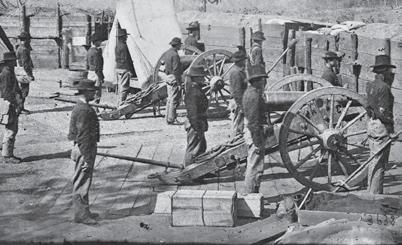
African Americans fighting for the Confederacy in the first three years of the war. The use of the conditional tense throughout the debates constitutes the most persuasive evidence that there was no critical mass of “Black Confederates” participating as soldiers in the War. Evidence that Prof. Ervin L. Jordan, Jr., amassed for his landmark study,
Black Confederates and AfroYankees in Civil War Virginia (1995), suggests that individual African Americans serving with Confederate armies occasionally participated in battle. Whether they did so for self-defense, loyalty to a master or friend, or commitment to the Confederacy is not clear. Although many scholars contend that no people would ever willingly fight to perpetuate their own enslavement, Jordan argues that an un-measurable minority of men were “zealots of the wrong,” and that students of history should try to understand those men, even if we disapprove of their decisions.

In contrast to Jordan’s scholarly critical analysis, the argument supporting “Black Confederates”
is typically related to the modern debate about slavery and Confederate heritage. According to this argument, if large numbers of African Americans fought for the Confederacy, then their descendants should embrace, not condemn, the Confederacy, the Confederate flag, and Confederate monuments.
The modern promotion of “Black Confederates” echoes the early 20th-century white southern embrace of “faithful slaves” who served the Confederacy. Southern states, beginning with Virginia in the 1880s, but most after 1900, awarded pensions to blacks who served with Confederate forces, and a handful of former body servants and cooks attended Confederate veteran reunions.
Prominent Confederate veteran Judge George L. Christian in 1913 hinted at the likely motive for such actions when he memorialized the service of Alexander Kean, who served with the Richmond Howitzers artillery. Christian hoped that the account of Kean’s service “might stimulate some of the colored people of this day to emulate the life and character of this faithful and devoted member of their race.”
As historians continue to mine records for evidence for and against the existence of “Black Confederates,” we know that no significant numbers of enslaved or free African-American men served in the Confederate Army as soldiers, as defined by commonly accepted criteria. Certainly their numbers and their military service was nothing to compare with the 200,000 AfricanAmerican men who served in the U.S. Colored Troops.


For Further Reading:
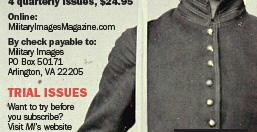
100 Significant Civil War Photographs: Atlanta Campaign collection of George Barnard’s camera work. Most of the photographs are from Barnard’s time in Atlanta, mid-September to mid-November 1864, during the Federal occupation of the city. With this volume, Stephen Davis advances the scholarly literature of Barnardiana.
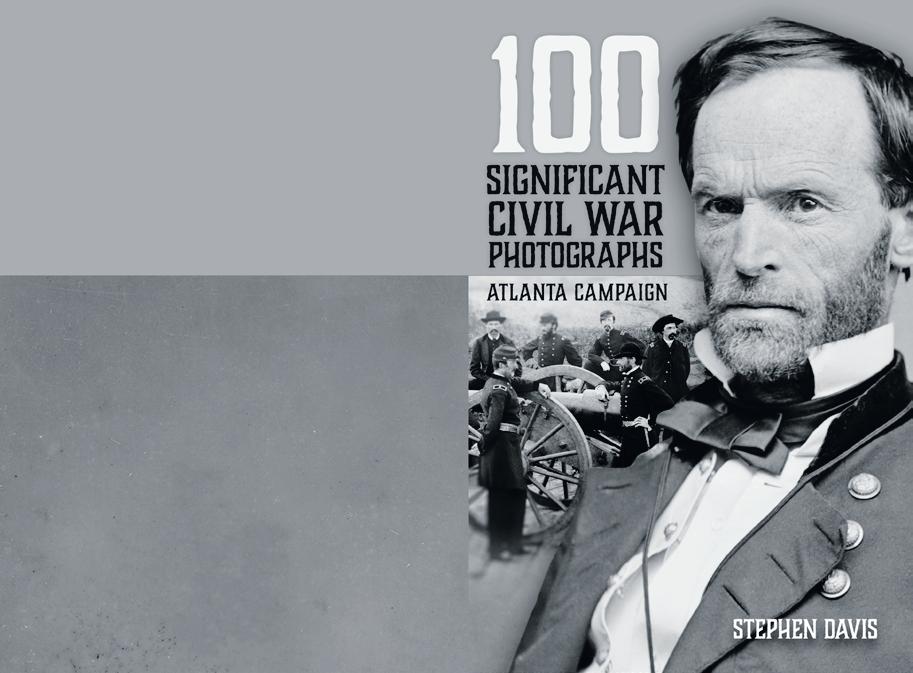

• Bruce Levine, Confederate Emancipation: Southern Plans to Free and Arm Slaves during the Civil War
• Video of Bruce Levine lecturing on the book: https://www.youtube.com/ watch?v=VjBwCSZC-20
• Robert Durden, The Gray and the Black: The Confederate Debate on Emancipation
• Ervin Jordan, Black Confederates and Afro-Yankees in Civil War Virginia
• Kevin M. Levin, Searching for Black Confederates: The Civil War’s Most Persistent Myth. Chapel Hill: University of North Carolina Press, 2019.
John M. Coski is historian at the American Civil War Museum in Richmond.
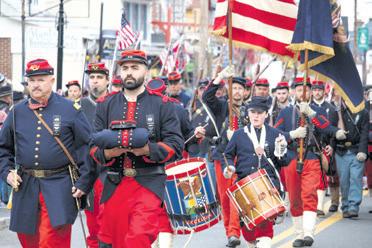

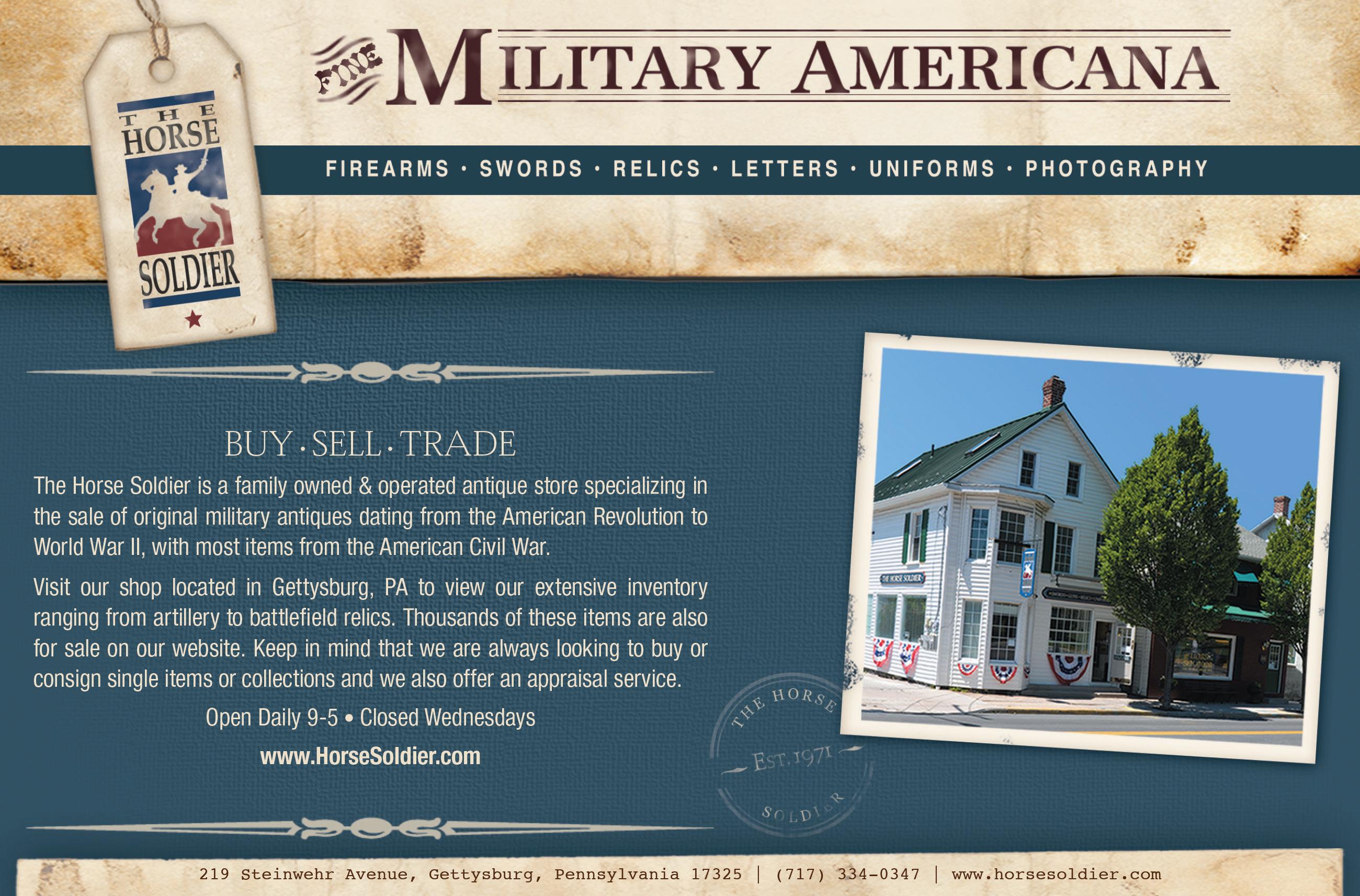
4 Civil War News March 2020
The American Civil War was the first war in which both sides widely used entrenchments, repeating rifles, ironclad warships, and telegraphed It was also the first American War to be extensively photographed. Mathew Brady, Alexander Gardner and Timothy O’Sullivan are famous for having made iconic photographs in the Civil War’s eastern theater. George N. Barnard deserves to be ranked in this top tier for his photographic A civilian photographer hired by Gen. William T. Sherman’s chief engineer to take pictures of fortifications around Atlanta, Barnard took several hundred of them in and around the city in the fall of 1864. His most famous is the site of Union Maj. Gen. James B. McPherson’s death in the battle of Atlanta, July 22, 1864. Thus far, no comprehensive, definitive listing has been made of the photographer’s work. The Library of Congress has 130 images; the U. S. Military Academy at West Point, New York, has at least 98 photographs, donated by Captain Poe’s widow. Other repositories, such as the Gilder Lehrman Institute of American History in New York City, have smaller collections. For this book we have chosen hundred images we deem “significant,” though other students may wonder at some of our selections. We hope that this work will stimulate further interest in Barnardiana, and that other scholarly volumes are yet to come. The Atlanta Campaign STEPHEN DAVIS 100 SIGNIFICANT CIVIL WAR PHOTOGRAPHS ATLANTA CAMPAIGN $19.95 + $3.50 shipping 128 pages, photographs, maps, bibliography. $19.95 + $3.50 shipping. Softbound. ISBN: 978-1-61850-151-6. www.HistoricalPubs.com. Order online at www.HistoricalPubs.com or call 800-777-1862 Want To Advertise In Civil War News? Email us at ads@civilwarnews.com or Call 800-777-1862 CW N Vol. 46, No. 1 48 Pages, January 2020 $3.50 Civil War News America’s Monthly Newspaper For Civil War Enthusiasts Inside this issue: 24 Inspection, ARMS! Day Remembrance Day, 2019, Gettysburg Joe Bordonaro about the first part, but very much this famous phrase from his magOn Nov. 23, 2019, reenactors and gathered Gettysburg, Penn., –--activities that took place.Stafford County Science Battlefield Trust) The Delaware Valley Blues march towards the Codori Farm.


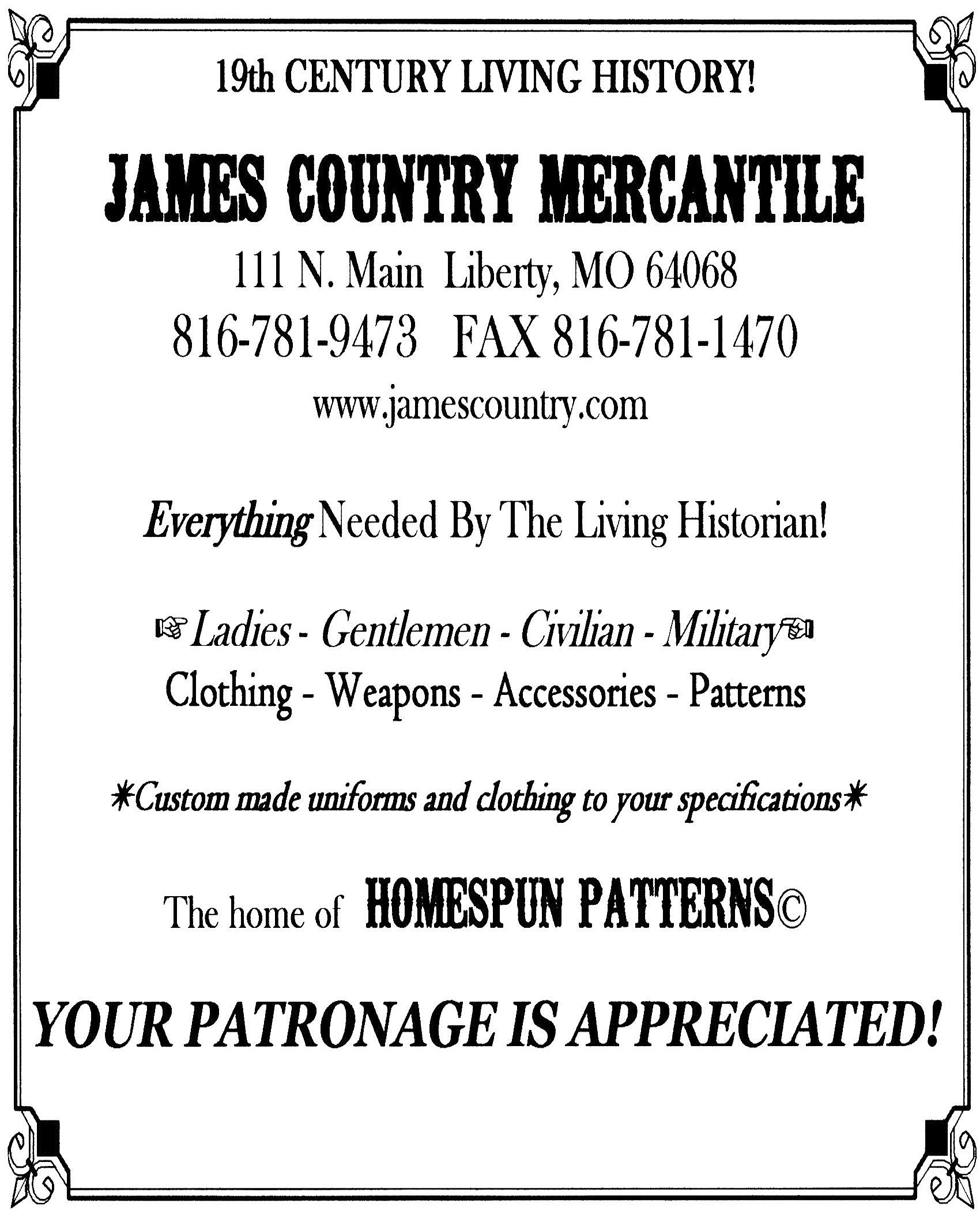

5 March 2020 Civil War News Want To Advertise In Civil War News? Email us at: ads@civilwarnews.com Call 800-777-1862 Publishers: Send your book(s) for review to: Civil War News 520 Folly Road, Suite 25 PMB 379 Charleston, SC 29412 bookreviews@civilwarnews.com
by Sam Smith Reprinted with permission from the American Battlefield Trust
The Civil War was a fiery prism at the center of American society. Every life entered the prism at its own angle and was refracted in its own way
The lives of Southern black people changed immeasurably during the war years. In the midst of a see-saw struggle that promised freedom as well as desolation, these men, women, and children made difficult and highly personal decisions in extraordinary circumstances.
Many Southern slaves took advantage of the fog of war to escape towards freedom. Before the Emancipation Proclamation was officially adopted, these escapes usually meant congregating around the Union armies that were operating in Southern territory. Vast columns of escaped slaves followed almost every major Union army at one point or another. These people, sometimes called “contrabands,” as in “confiscated enemy property,” frequently served as scouts and spies for the Union soldiers.
When the Emancipation Proclamation took effect on January 1, 1863, Union forces had regained control of large swaths of the South. Although many now claim that the Proclamation was effectively useless because
Black Confederates: Truth and Legend
it established policy for a foreign nation, the practical reality is that the Union, by force of arms, had every necessary power to establish policy in its occupied territories, just as Confederate armies exercised their power to capture and enslave free black people during their brief occupations of Northern territories.
After the Proclamation, the refugees in the contraband camps, along with free black people throughout the North, began to enlist in the Union Army in even greater proportion than Northern white men. After some time in legal limbo, many Southern black men took up arms against their former masters and distinguished themselves on campaign and on the battlefield. By the time the war was over, black soldiers made up 10% of the Union Army and had suffered more than 10,000 combat casualties.
Some black Southerners aided the Confederacy. Most of these were forced to accompany their masters or were forced to toil behind the lines. Black men were not legally allowed to serve as combat soldiers in the Confederate Army—they were cooks, teamsters, and manual laborers. There were no black Confederate combat units in service during the war and no documentation whatsoever exists for any black man being paid or pensioned as a Confederate soldier, although some did receive
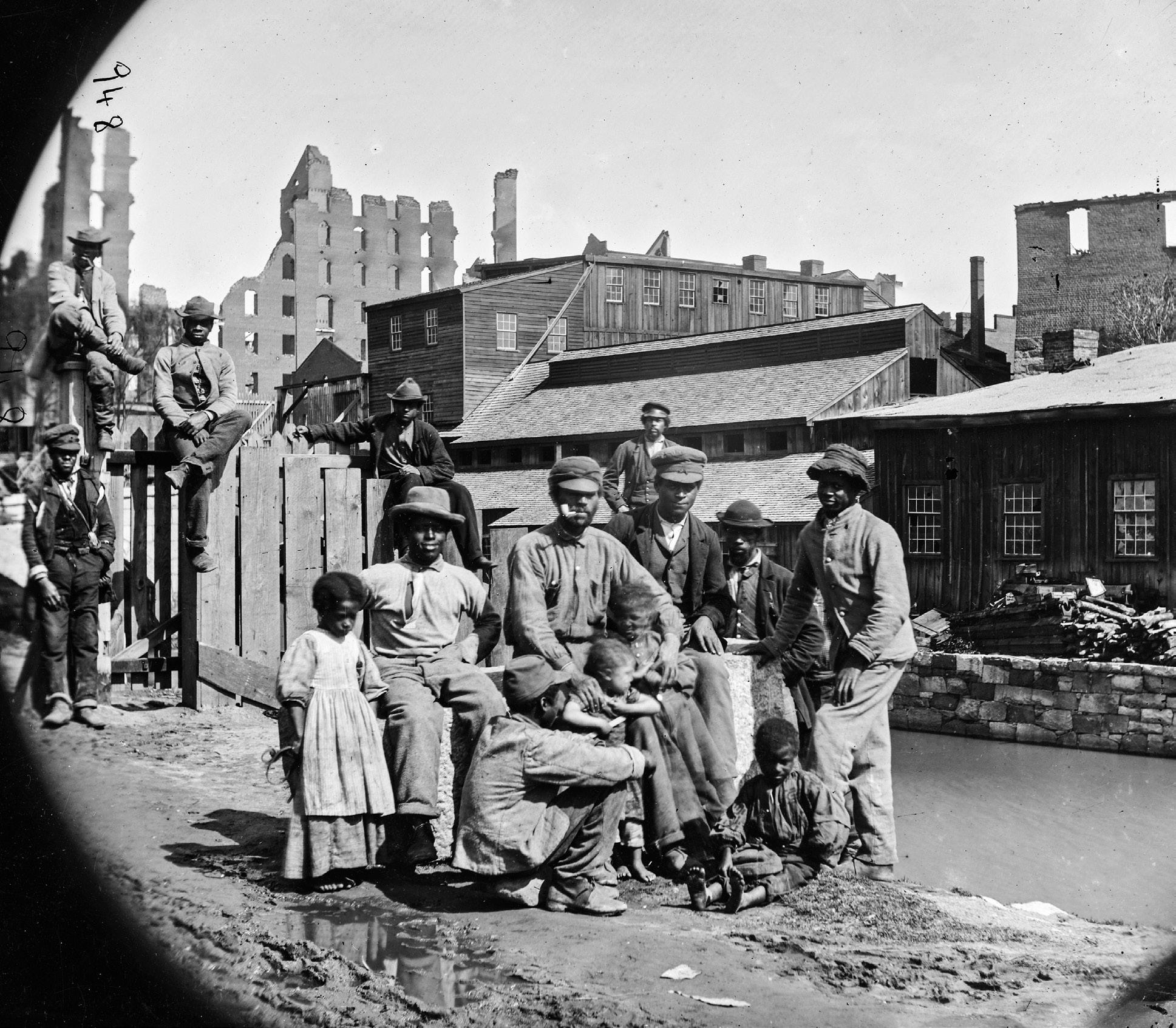
The altered photograph at left is considered by many to be evidence of black Confederate soldiers, however, the photograph has been intentionally cropped and mislabeled. The photograph is presented in its original state at right, in which a Union officer is clearly shown. Some 1,500 free blacks formed the “1st Louisiana Native Guards” in the early days of the war, but they were ordered disbanded by the Confederacy in January 1862. Some men of the unit later joined the Union Army. This photograph actually shows a Union U.S.C.T. unit. (The University of Virginia)
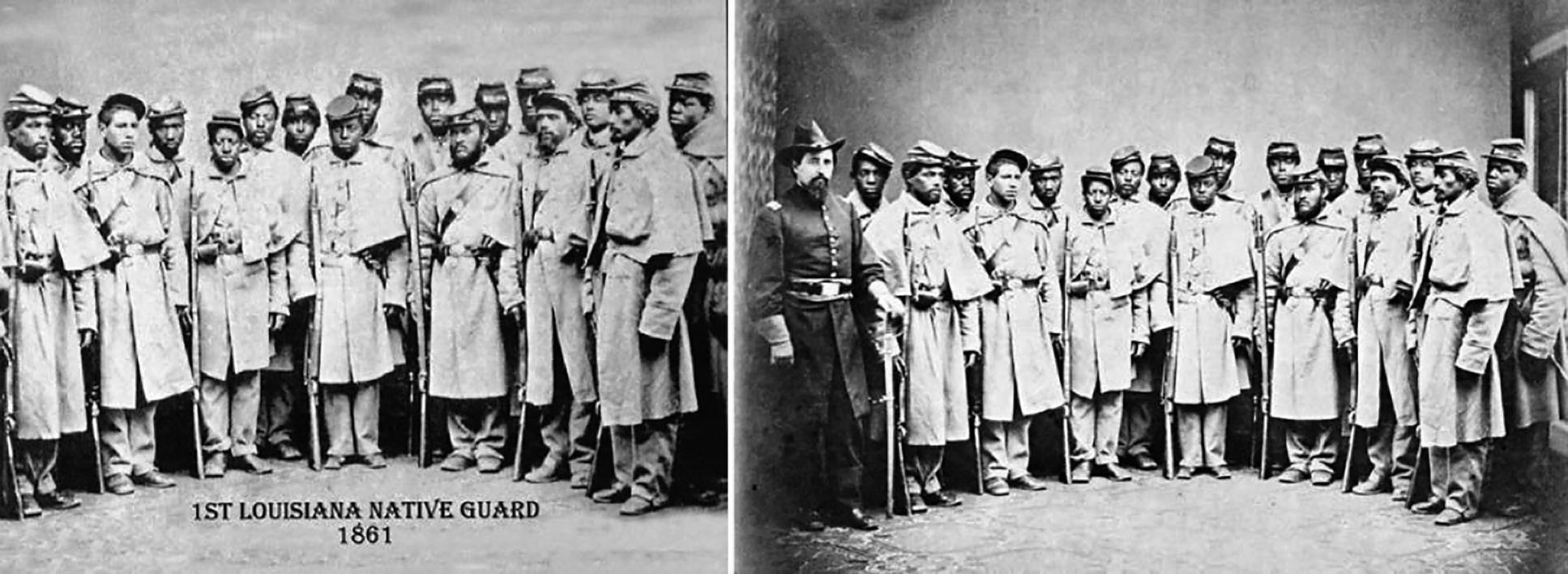
pensions for their work as laborers. Nevertheless, the black servants and the Confederate soldiers formed bonds in the shared crucible of conflict, and many servants later attended regimental reunions with their wartime comrades. This is not to say that no black man ever fired a gun for the Confederacy. To be specific, in the Official Records of the War of the Rebellion of the Union and Confederate Armies, a collection of military records from both sides consisting of 138,579 pages with 1,006 maps and diagrams, assembled in 128 books, organized as 70 volumes grouped in four series, published between 1881 and 1901, are a total of seven Union eyewitness
“In my opinion, the worst calamity that could befall us would be to gain our independence by the valor of our slaves, instead of our own. If we are conquered by the fortunes of war, we may save our honor and leave the cause to our descendants, who may be wiser and braver than we are and may avail themselves of the accidents of human affairs, and yet win what we are ignominiously throwing away. The day that the army of Virginia allows a negro regiment to enter their lines as soldiers they will be degraded, ruined and disgraced.”
Robert Toombs was the Confederacy’s first Secretary of State and a general in Robert E. Lee’s army. His response to the decision to enlist black soldiers in the Confederate Army appeared in a June 1865 edition of the Augusta Chronicle.
accounts of black Confederates. Three reports mention black men shooting at Union soldiers, one mentions capturing a handful of armed black men along with some soldiers, and the other three mention seeing unarmed black laborers. There is no record of Union soldiers encountering an all-black line of battle or anything close to it.
In those same Official Records, no Confederate ever references having black soldiers under his command or in his unit, although references to black laborers are common. The non-existence of black combat units is further indicated by the records of debates in the Confederate Congress over the issue of black enlistment.
The idea was repeatedly rejected until, on March 13, 1865, the Confederate Congress passed a law to allow black men to serve in combat roles, although with the provision “that nothing in this act shall be construed to authorize a change in the relation which the said slaves shall bear toward their owners,” i.e. that black soldiers would still be slaves.
Active fighting ended less than
three weeks after the law was passed, and there is no evidence that any black units were accepted into the Confederate Army as a result of the law. Whatever black combat service might have occurred during the war, it was not sanctioned by the Confederate government. Even beyond the Official Records, there is no known letter, diary entry, or any other primary source in which a Confederate mentions serving with black soldiers. In the years shortly after the war, hundreds of prominent Southerners wrote and spoke about “the Lost Cause,” a vision of the war in which the South was fighting to secure state rights and in which slavery was a secondary concern. None of these Southerners ever mentioned black soldiers fighting for the South, although it would have been a good time to present such evidence if there was any truth behind it. The notion of widespread black combat service has only arisen within the past 25 years or so, long past the lifespan of real veterans from either side, who would have immediately denied its legitimacy. The modern myth of black
6 Civil War News March 2020
Freed slaves smile for the camera amidst the ruins of Richmond in 1865. (Library of Congress)
Confederate soldiers is akin to a conspiracy theory—shoddy analysis has been presented, repeated, amplified, and twisted to such an extent that utterly baseless claims of as many as 80,000 black soldiers fighting for the Confederacy (which would roughly equal the size of Lee’s army at Gettysburg) have even made their way into classroom textbooks. It is right to study, discover, and share facts about the complex lives of 19th century black Americans. It is wrong to exaggerate, obfuscate, and ignore those facts in order to suit 21st century opinions.




Sam Smith is a native of Nashville, Tenn., and a graduate of the University of North Carolina, Sam Smith worked with the Civil War Trust’s (now American Battlefield Trust) K-12 educational programs. An award-winning board game designer, Smith has also written or co-written more than 50 articles on Civil War subjects, and is a frequent lecturer at the National Museum for American Jewish Military History.
Editor’s Comments:
There is some anecdotal commentary about black soldiers but tracking down the original source is complicated. Philip Thomas Tucker, Pickett’s Charge, (2016),


page 104, gives two examples, mentioning a black color bearer and his brother in the 14th Tennessee as well as a black drummer in the 18th Virginia during the massive charge at Gettysburg on July 3, but these men were presumable unarmed. The year before, a member of the U.S. Sanitary Commission wrote a description of blacks marching through Frederick, Md., among Jackson’s troops;
Over 3,000 negroes must be included in this number. These were clad in all kinds of uniforms, not only in cast-off or captured United States uniforms, but in coats with Southern buttons, State buttons, etc. These were shabby, but not shabbier or seedier than those worn by white men in the rebel ranks. Most of the negroes had arms, rifles, muskets, sabres, bowie-knives, dirks, etc. They were supplied, in many instances, with knapsacks, haversacks, canteens, etc., and were manifestly an integral part of the Southern Confederacy Army. They were seen riding on horses and mules, driving wagons, riding on caissons, in ambulances, with the staff of Generals, and promiscuously mixed up with all the rebel horde. The fact was patent, and rather interesting when
considered in connection with the horror rebels express at the suggestion of black soldiers being employed for the National defence (cited in Harwell’s Union Reader).
More to the point are late war references including Marylanders applying to be drillmasters for black units being formed in Richmond (Robert J. Driver First and Second Maryland Infantry, CSA, (2004), pp. 368, Negro recruiting in Richmond on Mar. 22, 1865 (Driver, p 323 citing three diary entries for 21-22 March 1865). The Maryland regiment researcher also noted that a Maryland regiment cook was sent to Point Lookout along with his captured regimental comrades (Driver, p 545). Any troops recruited and drilled in Richmond were presumably among those noted during the retreat to Appomattox as guarding a wagon train and who drove off an attack by Union cavalry, but were then captured in a second charge (Burke Davis, To Appomattox, p. 176 citing R. M. Doswell’s account in Confederate Veteran, 1915, p. 404). These scattered references probably indicate something of the reality of any black combat soldiers. We encourage comments..
7 March 2020 Civil War News
John Henry Myer: Pursued by War


 by Paul T. Scott
by Paul T. Scott
When war threatened civilians directly, they had three essential choices: stay, temporarily flee, or permanently relocate. Circumstances sometimes dictated which option they chose.

One of the most famous civilians of the conflict, Wilmer McLean, moved his family from Manassas Junction when a second battle in that area threatened his family; he relocated the clan to Appomattox Court House, only to have armies arrive in his yard and their generals discuss terms of surrender in his parlor three years later. Near Fredericksburg, Va., another
civilian faced a similar circumstance, war threatened, he relocated, but battlefield conflict pursued him. John Henry Myer spent his life making choices trying to better his family’s future, but sometimes fate did not cooperate.



In 1847, Myer and his wife, Mary Elizabeth Kohler Myer, immigrated to Virginia from the German kingdom of Hanover. They settled in the port city of Fredericksburg and started raising their family, which grew to include three children, Mary, John Jr., and Annie. The family lived over the store where Myer worked as a bridle and saddle
maker. In 1852, he sold his business and home and started a bakery and confectionery business, believed to have been located at 212 William Street. Myer’s bakery prospered until war came to the city.
In November 1862, Union forces gathered on the east bank of the Rappahannock River opposite Fredericksburg. Anticipating the coming onslaught, Myer followed the example of many neighbors, fleeing westward in Spotsylvania County. On Dec. 11, 1862, Federal artillery shelled the town, followed by street fighting that brought a new level of war to the Civil War history saga. Then, on Dec. 13, deadly attacks just west and south of town produced many casualties and left a horrific trail of carnage in the community. The following spring, the Second Battle of Fredericksburg took place, bringing another wave of violence through the riverside community.
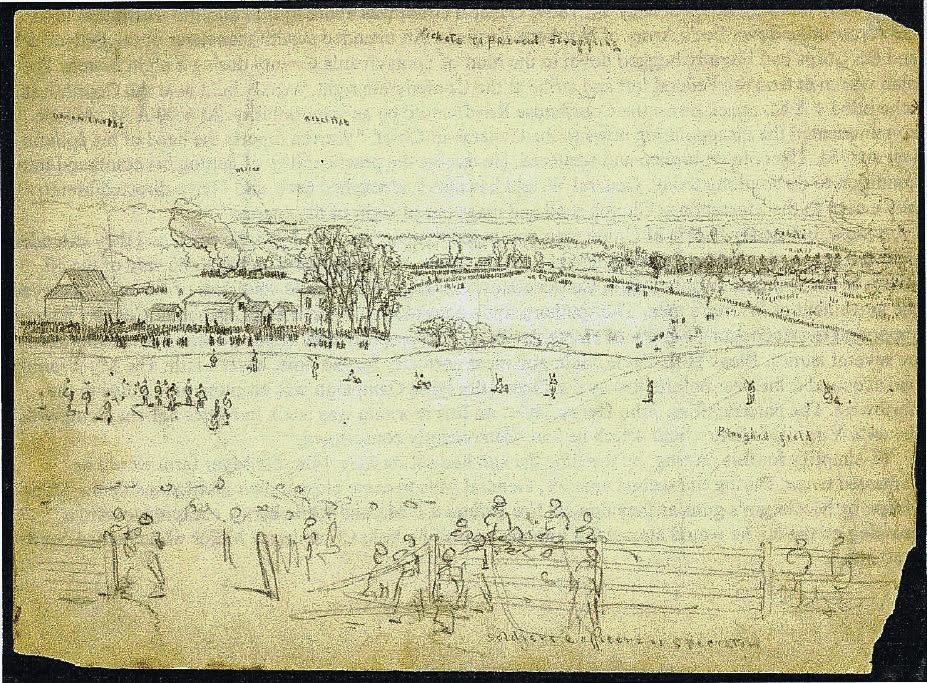
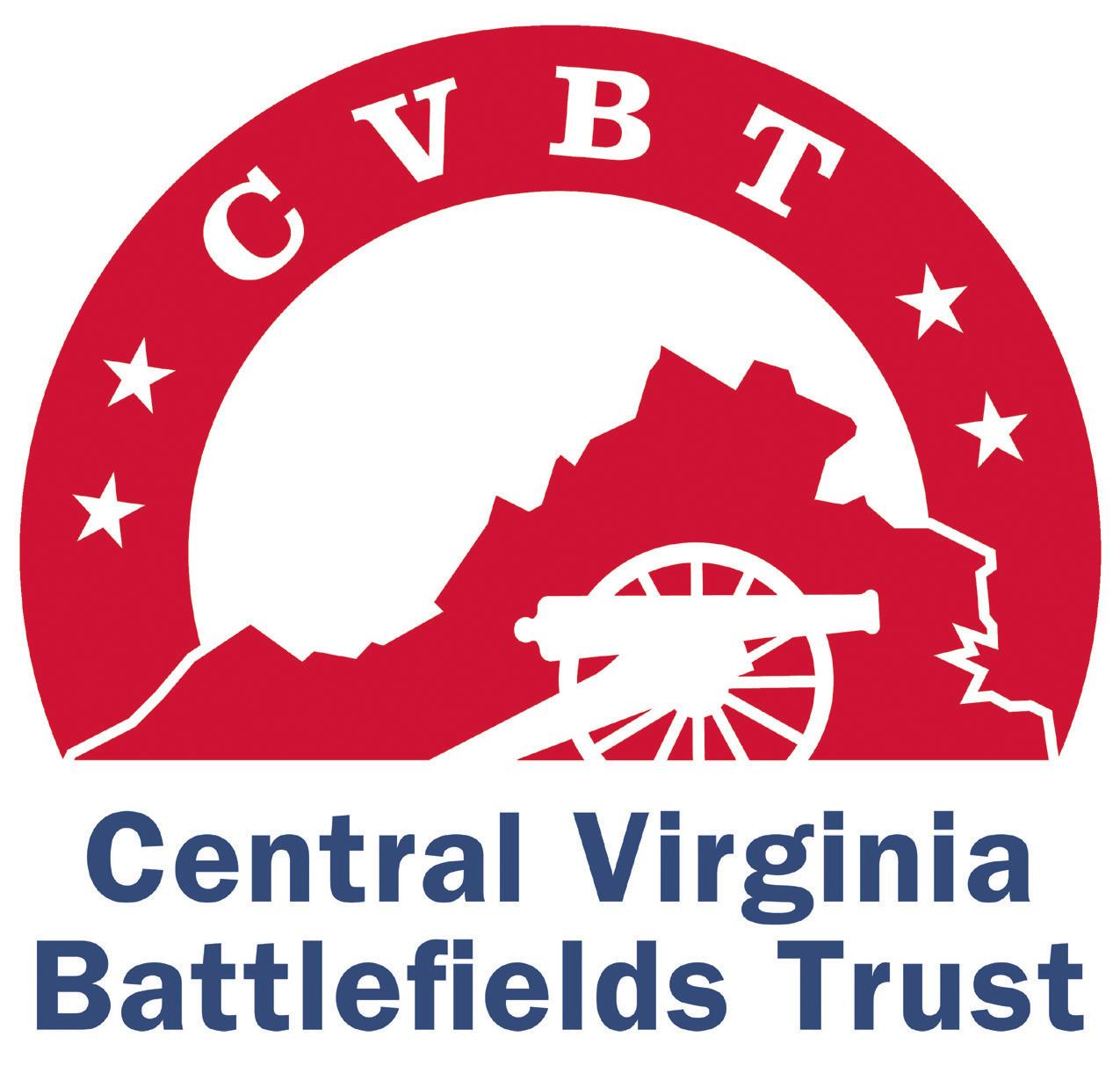
In April 1863, desiring to move his family away from the desolation in the city, Myer purchased a farm known as Bleak Hill (later Myer’s Hill) on the Ni River in Spotsylvania County and moved his family, hoping for a more peaceful future. The new property lay approximately twelve miles from Fredericksburg and southeast of Spotsylvania Court House. Unfortunately for Myer, war seemed to pursue him. It came to his front doorstep on May 14, 1864, during the Battle of Spotsylvania Court House. Serious fighting occurred near the house and atop Myer’s Hill. New York, Pennsylvania, and New Jersey regiments fought Georgia, Mississippi, and Virginia units for the strategic high ground. Generals Grant and Meade both came to Myer’s Hill, and at one point, Confederates came close to capturing Meade. The hill where the Myer house stood changed hands three times during the battle before the Federals claimed the day’s victory.
The Myer Family had fled, but a caretaker had stayed behind, sheltering in the house. Just before the final assault, the caretaker fired on the Federals, and in response, they burned the house to the ground.
John Myer saw the flames engulfing his house from the ranks of the 40th Virginia Infantry. Earlier that spring, he had been conscripted by the Confederate government for military service. He saw his first action in the Wilderness, and during the battle of Spotsylvania Court House, his unit was positioned in a part of the line that became known as Heth’s Salient, well within sight
of the hill that bore Myer’s name. He watched helplessly as smoke rose from his homestead.

On May 22, 1864, near the North Anna River, Yankees captured Myer, sending him to Maryland’s Point Lookout prison camp for the duration of the war. Much to his relief, he learned that his family had survived the battle and burning and were safe elsewhere. After his release, he took the oath of allegiance and returned home to restart his life.
With little except the home’s foundation left on his Spotsylvania farm, Myer abandoned the property and moved back to Fredericksburg with his wife and three children. Industrious as usual, he started to rebuild his opportunities and business ventures. He formed a partnership with Frederick Brule in 1866 and built the Germania Flour Mill with its office and
warehouse at 317 William Street. He became a prosperous merchant again, actively assisted in community affairs, and served on the Town Common Council for thirty years. Myer died on Dec. 5, 1909, and was remembered by the community as a member of the Presbyterian Church, a Mason, and an honored citizen. Today, Myer’s Hill remains untouched since the battle and house fire. Rifle pits still surround the homesite and earthworks traverse much of the southeastern section of the property. It is like a time capsule from 156 years ago, telling the story of a man, his family, and the battle that destroyed his home. Professional archaeology has uncovered a variety of clues and artifacts at the site, giving local historians a clearer picture
8 Civil War News March 2020 H Myer’s House . . . . . . . . . . . see page 10
Joseph Baker sketch of IX Corps soldiers at Myer’s House location.
Union General George G. Meade was almost captured during the fight at Myer’s Hill. (Library of Congress)






from page 8
of the family’s life and the battle that ended their time in the house on the hill.
In August 2018, the Central Virginia Battlefields Trust (CVBT) acquired a 73.3-acre tract at Myer’s Hill and has been working on preservation efforts and opportunities for special interpretation in the future. The stone basement of the burned house, the rock-lined well, and the icehouse pit are still clearly visible. At the time the property was purchased, CVBT President Thomas Van Winkle noted that the acquisition “is an increasingly rare opportunity to preserve an almost completely intact battlefield—one that history has paid little attention to yet, nevertheless, is so important to the entire story.”

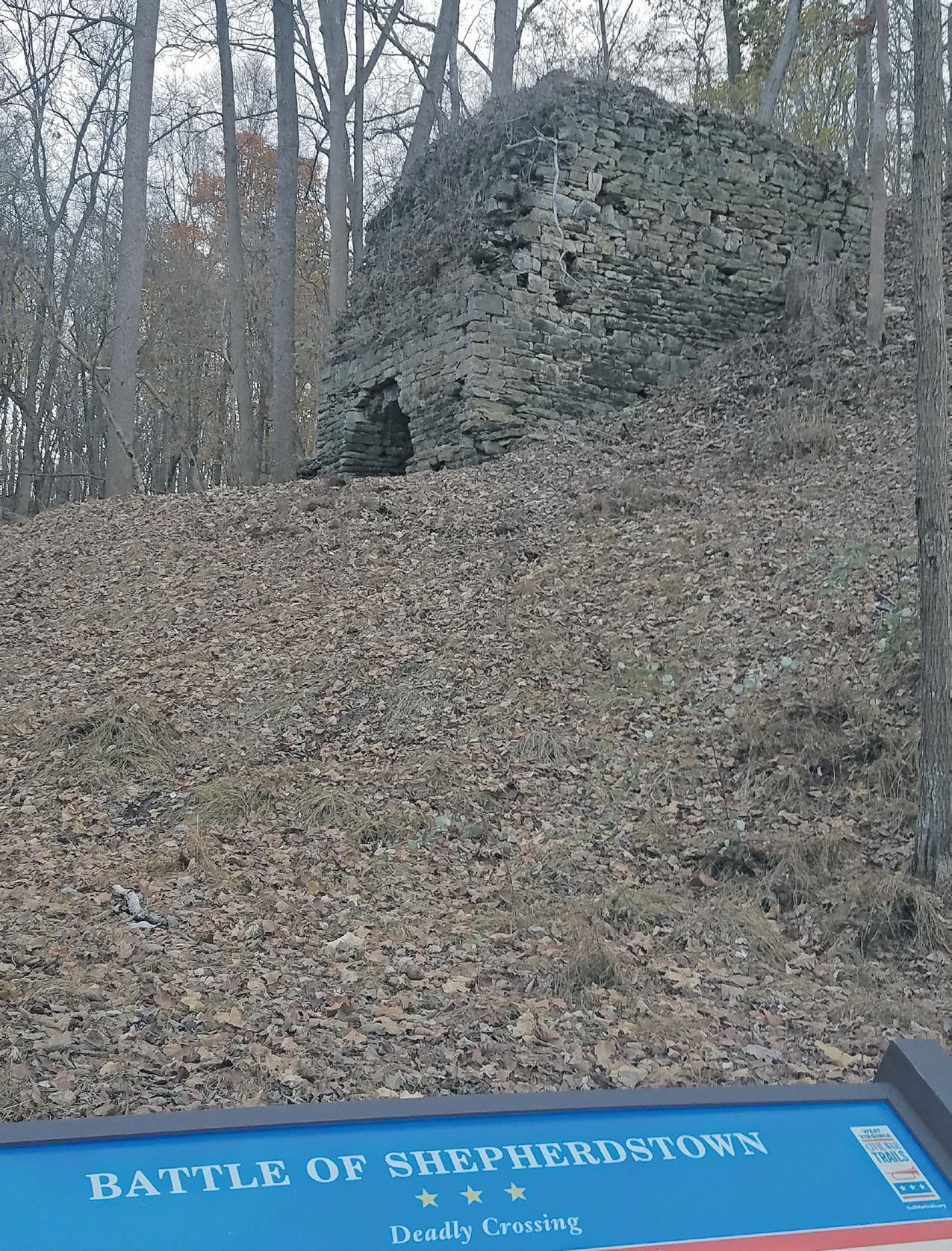



As CVBT continues to fundraise to retire the debt and preserve the battlefield forever, the
day is anticipated when the property can be further explored, studied, and interpreted. It is hallowed ground, a nearly forgotten part of the Battle of Spotsylvania’s history, and a witness to war’s destruction of civilian property.
John Myer, immigrant, entrepreneur, farmer, conscripted soldier, prisoner, businessman, and community leader, has a special chapter in Central Virginia’s local history. The opportunity to preserve pieces of his story also opens a greater discussion about civilians, their roles, and their losses during the Civil War. The conflict seemed to pursue Myer at multiple points, but happily he and his family survived, stayed in the Fredericksburg area, and rebuilt their lives when the fighting ended.
For more information about the preservation efforts at Myer’s Hill, please visit www.cvbt.org.
Paul Scott is a retired attorney and a member of the Central Virginia Battlefields Trust Board of Directors.
Want To Advertise
Shepherdstown Battlefield added to the Civil War Trails program
Civil War Trails, Inc. has teamed with Shepherdstown Battlefield Preservation Association to add their site to the popular program. The new sign is located along River Road, just east of Shepherdstown. Look for the West Virginia Civil War Trails sign to help guide your way. The Civil War Trails program connects visitors to more than 1,200 sites across six states. The program’s signature signs bring the modern landscape to life as visitors stand in the footsteps of soldiers, citizens, and those fighting to gain their freedom. Each Civil War Trails site is marketed internationally by state tourism offices, destination marketing organizations, and municipal partners.
The program is experiencing record visitation and immense growth since the Sesquicentennial. “I am delighted to see the addition of this new site in Shepherdstown, WV, bringing the total number of sites in Jefferson County to 16,” said Annette Gavin Bates, the CEO of the Jefferson County Convention and Visitors Bureau. “The Civil War Trails program is a vital partner of the Jefferson County CVB and our mission to provide the visitor an educational and fun experience as they follow in the footsteps of history.”
Increasing visitation to historic sites provides a strong revenue resource for location jurisdictions through sales, meals, and lodging taxes. “As our visitors average age declines their travel interests and spending habits are becoming more specific,” said Drew Gruber, Executive Director of Civil War Trails. “Shepherdstown is a great example of what our younger visitors are after. A battlefield presents not just a connection with the past but open space to hike or paddle right next door to a historic downtown with great shops and food.” A survey by the National Trust of Historic Preservation showed that millennial travelers are motivated to spend more in historic locations than elsewhere.
Working with the Jefferson County Historic Landmarks Commission, the Shepherdstown Battlefield Preservation Association (SBPA) is focused on preserving the site that stretches for more than a mile along the banks of the Potomac River and includes approximately 500 acres of core battlefield. Their organization relies on donations, grants, and partnerships to conserve and interpret the landscape. Most
recently the group negotiated a 24 acre conservation easement helping to secure more of the property. SBPA President Stephen Alemar mentioned that, “we are optimistic that national legislation will soon be completed that will incorporate our site into the National Park Service.”
This partnership in Jefferson County is part of a much wider effort in West Virginia. “West Virginia’s statehood is a direct result of the Civil War, making our many trails, battlefields, and reenactments an important part of our tourism industry,” Tourism Commissioner Chelsea Ruby said. “We continue to see interest from visitors looking to experience our rich history, and thanks to the support of the Civil War Trails organization, we’re able
to mark and promote these stops to new travelers every day.” The West Virginia Tourism Office partners with four other state travel offices to promote the Civil War Trails program, its sites, and create itineraries for travelers looking for all that the state has to offer.
A new West Virginia Civil War Trails map is currently under development; Civil War Trails has launched a GPS enabled page on their website to aid visitors in their quest to find these sites. More information can be had by calling the Jefferson County Convention and Visitors Bureau at 304-5352627 or Civil War Trails, Inc. at 757-378-5462. Connect with us on social media @civilwartrails #openairmuseum @livelovejcwv #almostheaven.
10 Civil War News March 2020
. . . . .
H Myer’s House . . . . . .
In Civil War News? Email us at ads@civilwarnews.com Call 800-777-1862
The Myer’s House foundations and part of the basement are visible in this photograph.
Hand dug rock lined well of the Myer’s House.
Myer’s Hill icehouse pit.
This c. 1828 kiln is in the core of the historic Shepherdstown battlefield.
The cement complex was in the epicenter of the fighting during the Battle of Shepherdstown.











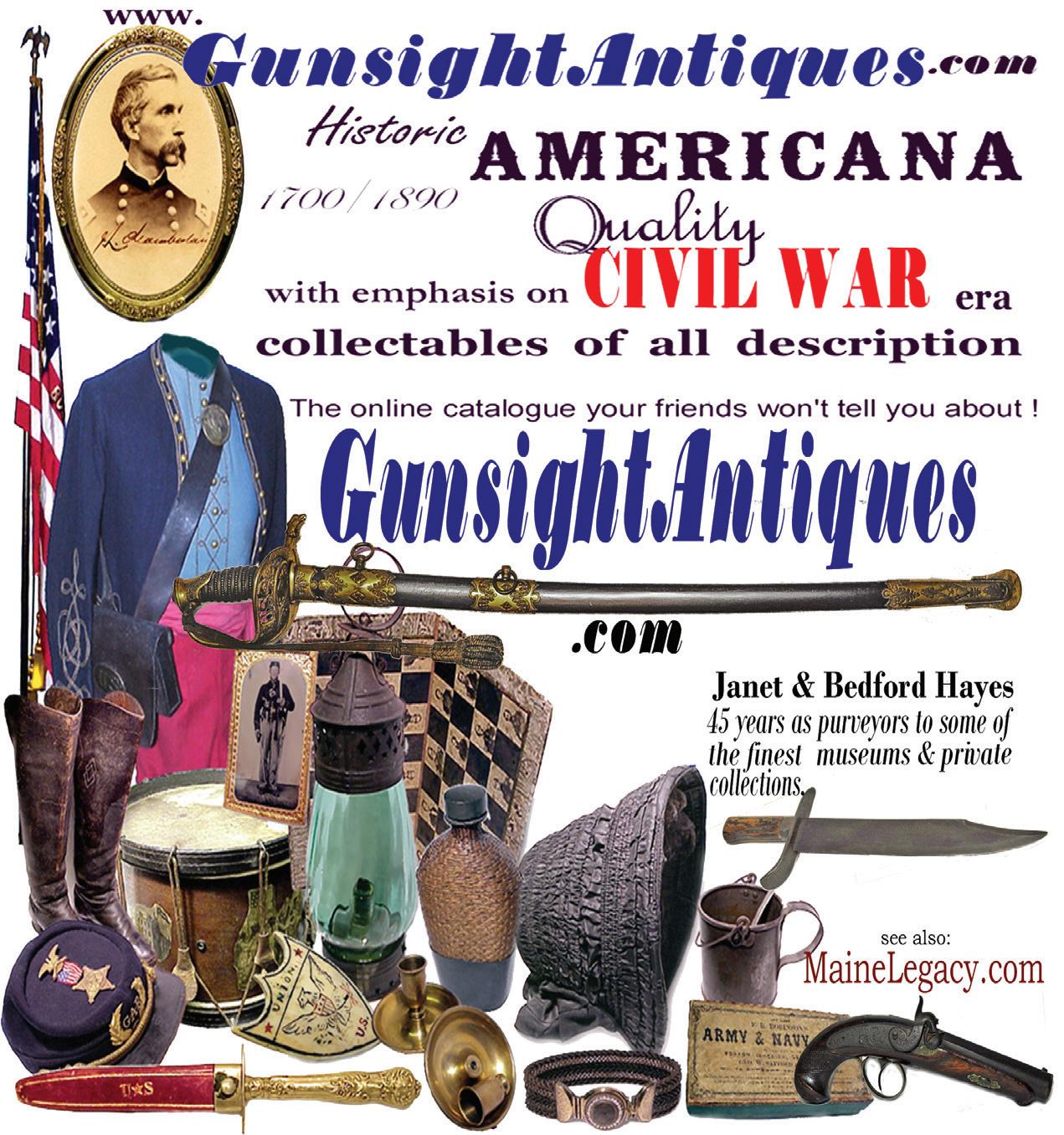
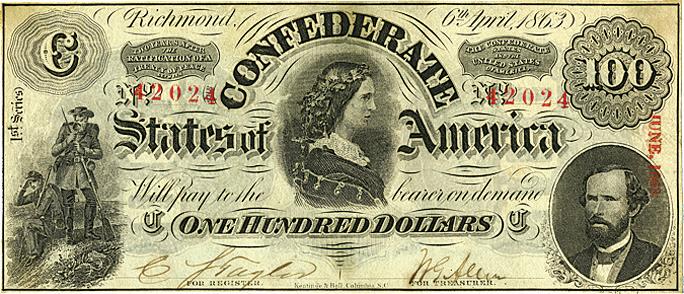




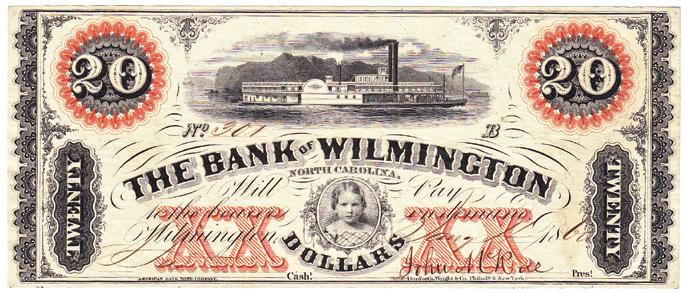














11 March 2020 Civil War News Deadlines for Submissions is the 20th of each month. Email to: ads@civilwarnews.com Greg Ton • P.O. Box 9 • Franklin, TN 37065 901-487-5944 • GTon1@aol.com Greg Ton Buying and Selling the Finest Confederate, Obsolete and Southern States Currency Since 1978 GregTonCurrency.com
New Dixie Catalog, Instructing the “Stupids” & Multiple Loading
Dixie Catalog
If you were a black powder fan back in the 1930s into the early 1950s, you were pretty much on your own. You had to either find a shootable original gun or go to one of a few custom gunmakers, and then figure out how to load, fire, and clean your gun using the advice of friends who, if you were lucky, were in the National Muzzle loading Rifle Association, or by consulting the few classic books available.

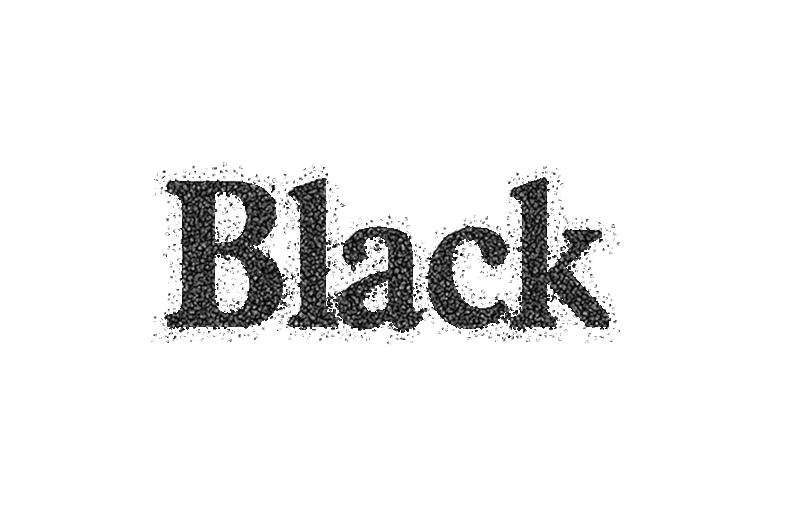
Then came Dixie Gun Works, founded by black powder entrepreneur Turner Kirkland. Kirkland started by selling gun parts and over the years became one of the largest suppliers of affordable reproduction guns and accessories for the black powder shooter. While other suppliers have come and gone, Dixie is still there, and issues a new catalog every year.

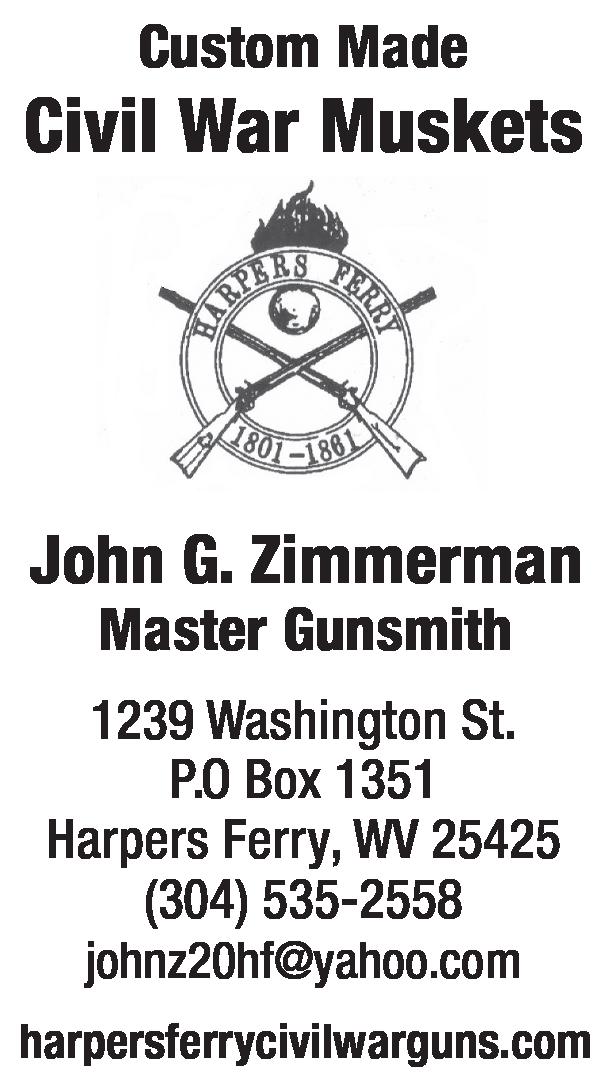
This year’s catalog has some interesting new products, including a reproduction Whitworth Volunteer rifle, and some Pedersoli bullet molds for that company’s more exotic
reproduction arms, including the Austrian Lorenz and the German Mauser 1857 rifle muskets. An interesting object in the new catalog is a “Percussion Cap Maker’ which allows the shooter to fabricate his own #11 caps out of aluminum cans
Other new items include an advanced bore light, lamb tallow for the exotic bullet lubricant maker, the Fortieth Anniversary Edition of the classic Blue Book of Gun Values, as well as a new definitive work on Colt revolvers, Robert.
M. Jordan’s Colt 1851 and 1861 Navies and Conversions.
The Dixie catalog not only features black powder muzzle loading and breech loading rifles, shotguns, and handguns, but also sells reproduction and original gun parts and accessories, including holsters, scabbards and rifle cases, gun cleaning materials, modern and traditional gunsmithing supplies, black powder reloading equipment including presses, hand tools, and accessories like case trimmers, obsolete black powder and blank ammo, knives, and tomahawks. If you want a Crusader sword to carve up infidels, or a “Brank” to silence a gossipy neighbor, or need a 2/3 scale cannon or a full-size cannon barrel to celebrate the 4th of July, Dixie is the place to go.
Dixie is also a source of reproduction historical and state flags, period clothing, and camp equipment for the reenactor or old-style hunter, as well as specific Dixie Gun Works memorabilia, including shirts, hats, and patches. You can also select from a large selection of magazines, including the
by Joe Bilby
old Dixie Gun Works Annual, in which I have a number of articles, reproduction historic documents, including eighteenth and nineteenth century maps, a large selection of black powder books, music, and artwork, including Native American and Civil War prints. You can even get a set of old timey button suspenders from Dixie; forty-eight- or fifty-sixinch sizes.
Dixie is now also inviting tourists to visit its iconic shop in Union City, Tenn. The company will make hotel or motel reservations for visitors and, if you fly in by private plane, will meet you at the airport.
The Dixie Gun Works Catalog is available for $5 from Dixie Gun Works 1312 W. Reelfoot Avenue, Union City, TN 38261. You can order by phone at 1-800238-6785 The Dixie Website is: www.dixiegunworks.com.

Instructing the “Stupids”
In the early months of the Civil War the basics of military life were often difficult to grasp for many volunteers, a situation that caused a Springfield, Mass., newspaper to complain that: “Some stupids down near Boston have been loading the United States rifle muskets with cartridges made of heavy paper, and finding that they do not work well, complain of the rifles as in fault.”
Apparently the “stupids” had been loading their rifle muskets in the same manner they loaded smoothbore muskets in the past, pouring powder down the muzzle and then ramming down the rest


of the cartridge, including the paper casing, unaware that with the rifle musket, the cartridge paper was supposed to be disposed of before inserting the Minié ball in the gun’s muzzle.
The newspaper went on to lecture the “stupids” that “no paper should be used in loading these arms. First the powder is poured in from the cartridge, and then the ball is dropped on top, and will go home of itself, but a gentle tap of the ramrod is useful to fill the cavity of the ball with powder, and leave no opportunity for the gas generated by the explosion to escape but behind the ball.” Apparently, there were “stupids” on the other side as well, since a Richmond newspaper copied the article as an advisory to Virginians.
Multiple Rifle Musket Loading
It wasn’t always the “stupids” who screwed up. In the past I have discussed the multiple loaded rifle muskets found on the field at Gettysburg in the battle’s aftermath. Multiple loading did indeed occur, and soldiers probably did not even realize, with all the smoke and noise, that they were doing it. This was not; it turns out, a Gettysburg discovery. The problem existed prior to that battle, and officers knew about it. In May 1861, a USMC lieutenant reported the following after conducting a test with enlisted men firing Sharps breechloaders and rifle muskets: “On the other hand, armed with the muzzle loading
rifle, the soldier’s severest trial occurs when he has discharged his piece and during the interval of reloading—hence it is, after an engagement, so many arms are found disabled by the insertion of the ball below the powder or double or treble loading.”
Joseph G. Bilby received his BA and MA degrees in history from Seton Hall University and served as a lieutenant in the 1st Infantry Division in 1966–1967. He is Assistant Curator of the New Jersey National Guard and Militia Museum, a freelance writer and historical consultant and author or editor of 21 books and over 400 articles on N.J. and military history and firearms. He is also publications editor for the N.J. Civil War 150 Committee and edited the award winning New Jersey Goes to War. His latest book, New Jersey: A Military History, was published by Westholme Publishing in 2017. He has received an award for contributions to Monmouth County (N.J.) history and an Award of Merit from the N.J. Historical Commission for contributions to the state’s military history. He can be contacted by email at jgbilby44@aol.com.

12 Civil War News March 2020
for Advertising or Editorial Submissions is the 20th of each month.
to ads@civilwarnews.com
Deadlines
Email
George Weller Juno

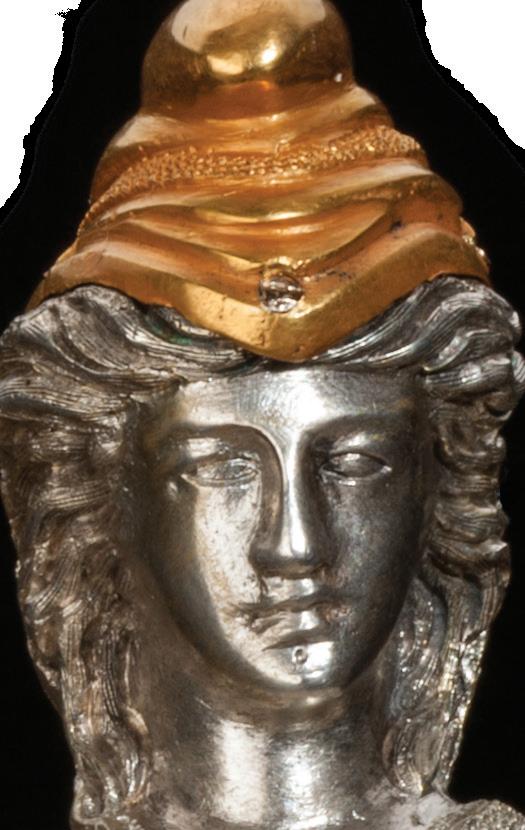
Carrie Sheads House
by Joe Bordonaro
Carrie Sheads is truly an icon of American History. Twenty-seven years old at the time of the Battle of Gettysburg, Caroline (Carrie) S. Sheads was the principal of the Oakridge Seminary for Girls. Her heroic actions, and that of her students, were hailed at the time; Carrie was featured in Frank Moore’s 1866 book Women of the War, and should be remembered by all Americans today. Her 11room family home also served as her seminary.
The Sheads family suffered tragic losses due to the Civil War; two of Carrie’s four brothers, Elias J. Sheads, Co. F, 87th Penn. Vols., killed July 9, 1864, at the Battle of Monocacy, Md., and J. James Sheads, Co. B, 21 Penn. Cav., who died in the City Point, Va., hospital Oct. 25, 1864. Another brother, Robert E. Sheads, Co. A, Veteran Volunteers, was wounded at White Oak Swamp. He survived his wounds, but died at a young age not long after the war ended.

In addition to these terrible personal losses, the seminary building suffered extensive damage
due to its use as a hospital where both Confederate and Union soldiers were treated during and after the battle. In addition, the house was hit by artillery fire, and today still has a cannon ball stuck in the brickwork on one side. The building was hit in more than sixty places, and two shells passed entirely through it. The losses to his house and crops resulted in Carrie’s father, Elias, being awarded $180 by the government after the war.
The house also was witness to Carrie’s heroic actions, when she hid a Union officer’s sword and thus prevented his being shot. The officer, Lt. Col. Charles Wheelock, 97th New York Infantry, had refused an order from a Confederate officer to surrender his sword, and was on the point of being shot, when Carrie intervened and pleaded for the colonel’s life. Distracted by the entrance of other prisoners, the Confederate officer left for a moment and did not see Carrie remove the sword from the officer’s belt and hide it in the folds of her dress. When he returned, the sword was nowhere to be
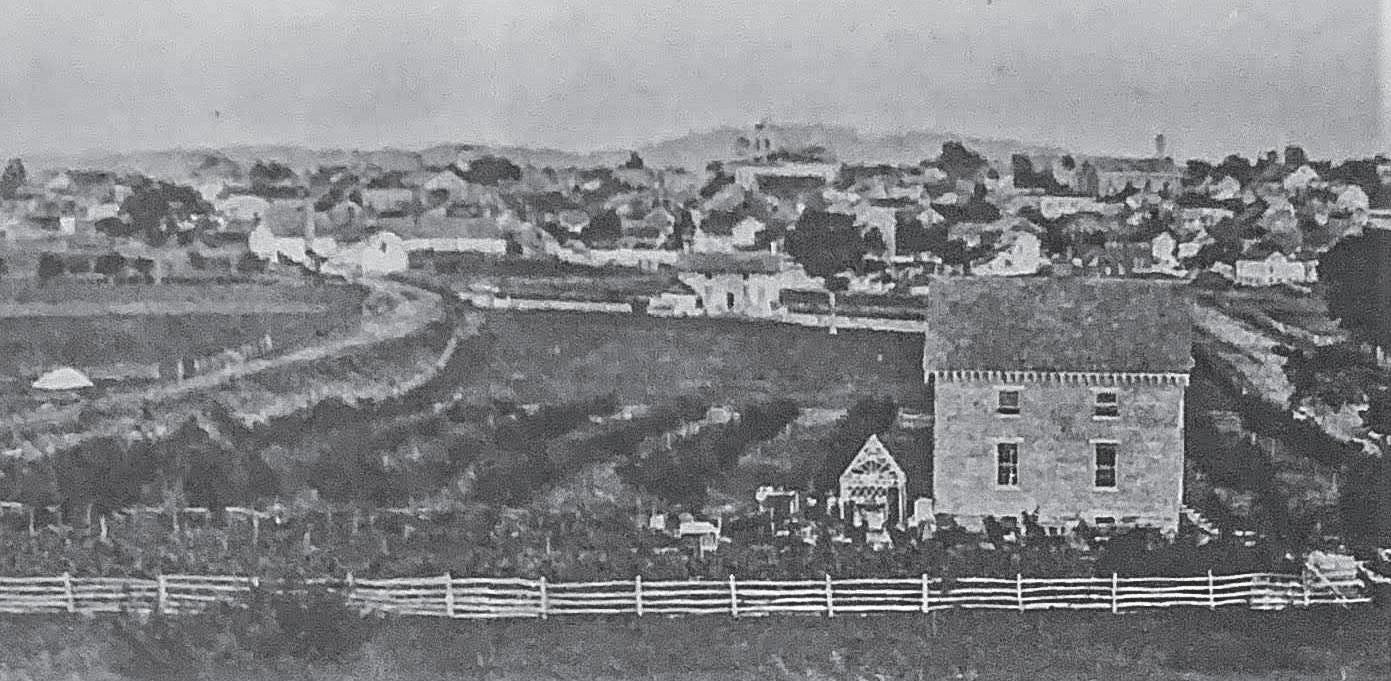

seen and Lt. Col. Wheelock told him that he had surrendered it to another Confederate. The ruse worked and Carrie kept the sword safe.

Five days after the battle, Lt. Col. Wheelock showed up unexpectedly and reclaimed his sword. He had escaped from the Confederates while being marched over South Mountain. He returned to duty with his sword and used it until his death, of “camp fever,” in Washington City in January 1865.
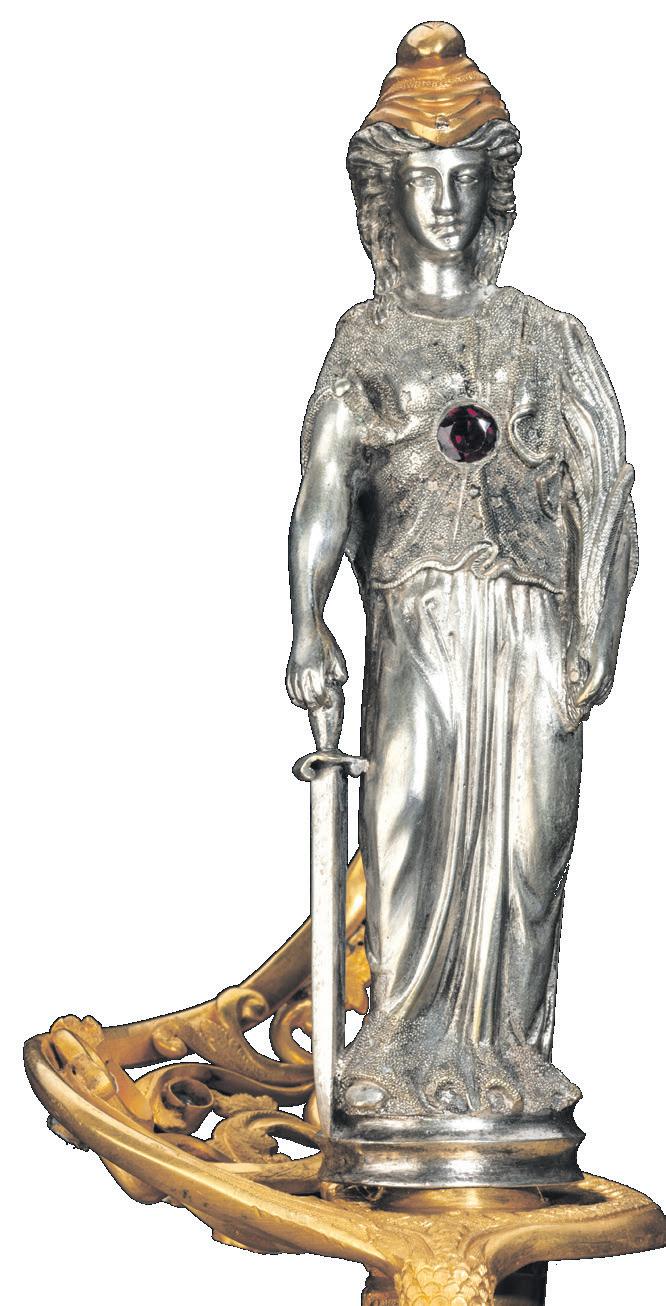
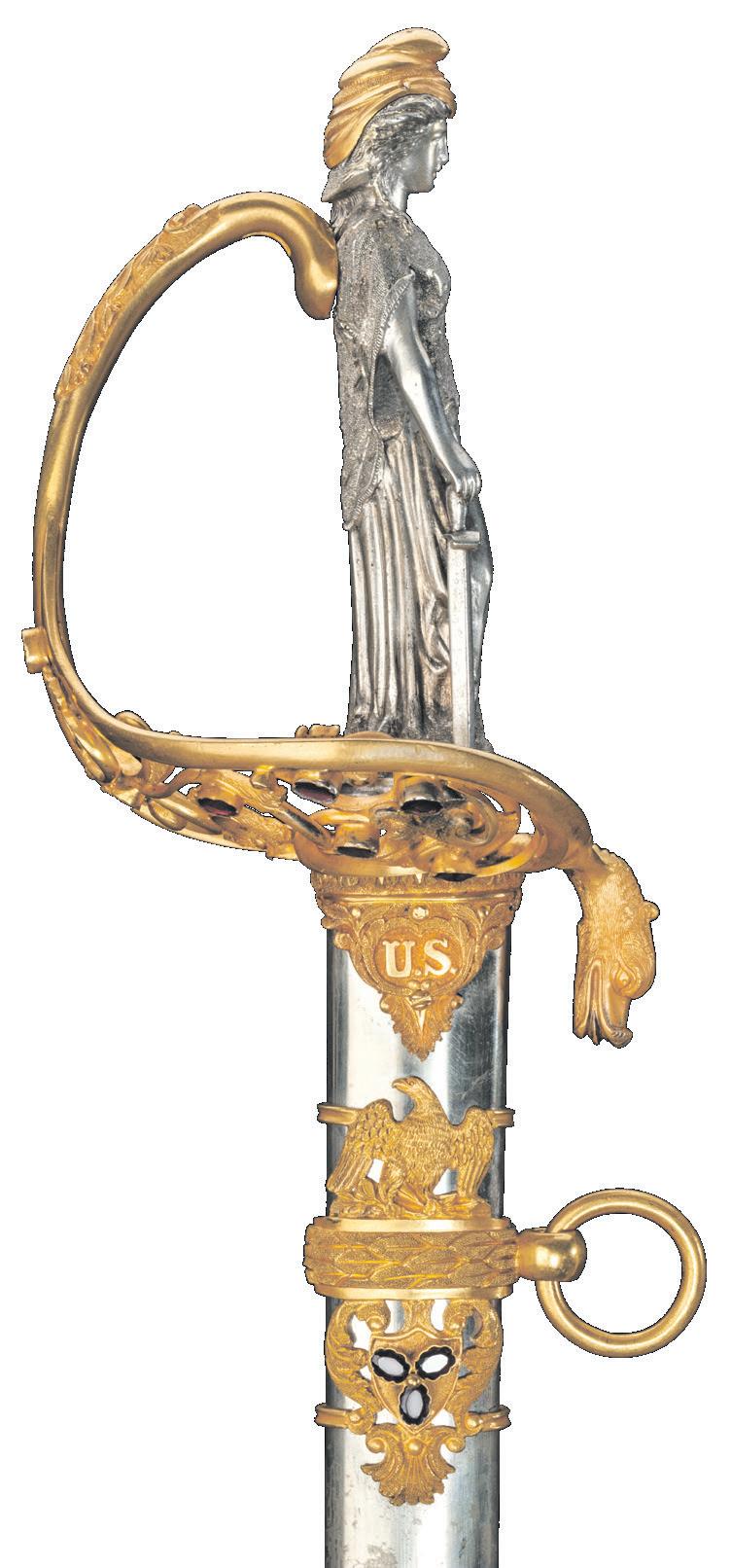
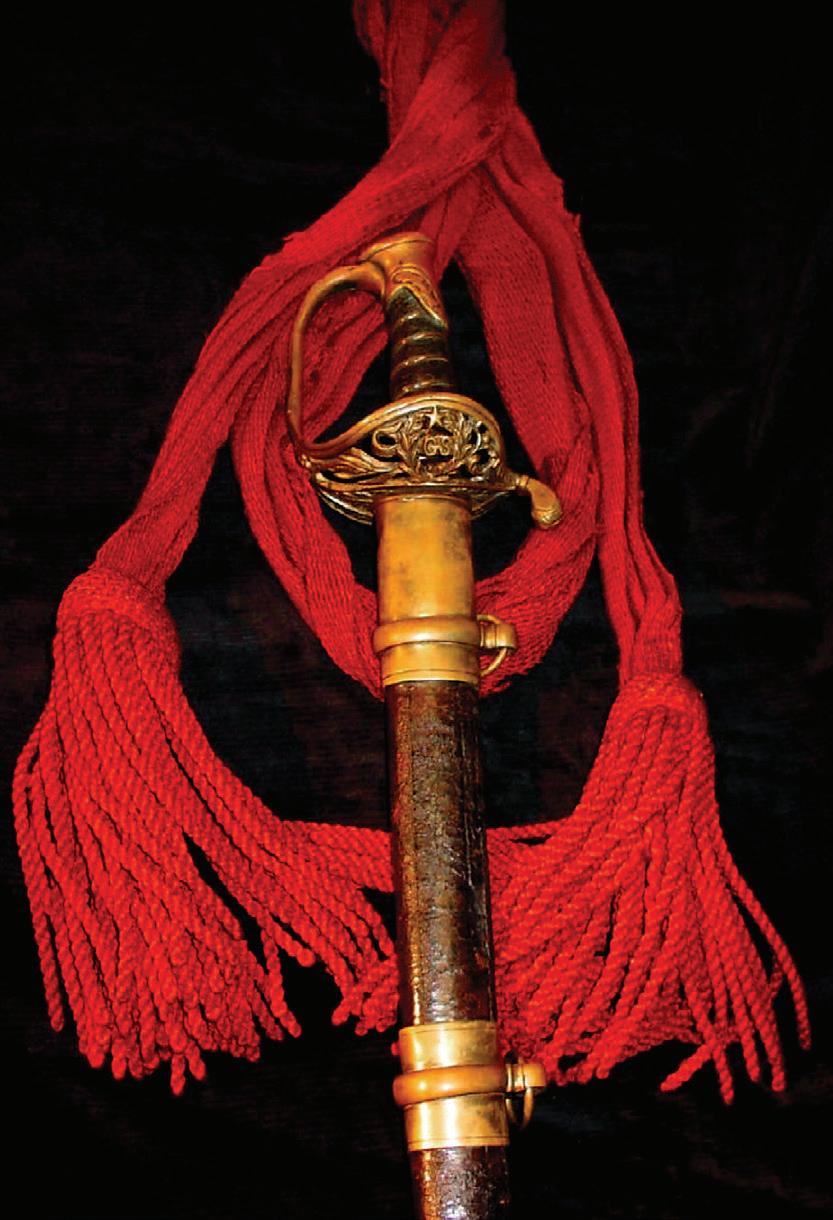
Today, Tim and Debbie Sheads live in the famous Sheads House, located on Chambersburg Pike “Buford Ave.” (Rt. 30), not far from the center of town. Tim, a direct descendant of the Carrie Sheads family who bought the house when it finally came on the market, and Debbie operate S&S Sutler of Gettysburg, based in a building located behind their house. Many of their high-quality reproduction wares can be seen by visiting their well-known tent at larger Civil War reenactments. Tim and Debbie also participated in many Civil War reenactments before starting their business.
Joe Bordonaro is a USAF veteran (1973–1977), Glassboro State College graduate (1980), Catholic school teacher (St. Joseph’s ProCathedral, 1983–1988), and retired public school teacher (Mullica Township School, 1988–2009). He has been involved with Civil War reenacting/living history since 1999. Joe began submitting articles to the Civil War News in 2005 and has been covering events for the News on a regular basis since 2016. Joe lives in Mount Laurel, NJ, and has been married to his wife Karen for 31 years. If you wish to contact Joe, you may send an email to joe1861@gmail.com.



13 March 2020 Civil War News Publishers: Please send your book(s) for review to: Civil War News 520 Folly Road, Suite 25 PMB 379 Charleston, SC 29412 THE FINEST HISTORICAL ANTIQUE MILITARIA Wallace Markert info@csacquisitions.com 16905 Nash Road • Dewitt, Virginia 23840 804-536-6413 • 804-469-7362 www.csacquisitions.com Buying and Selling The Finest in Americana 11311 S. Indian River Dr. • Fort Pierce, Florida 34982 770-329-4985 • gwjuno@aol.com
Sheads House modern view.
Sheads House 1863.
Debbie and Tim Sheads wedding photo.
Major T.H. Blacknall in an article titled “Corn” (Confederate Veteran Magazine, Vol. 26, April 1918) noted the following: “During the war I commanded the 1st Arkansas Regiment, consisting of twelve hundred men, and during the four years we never saw a piece of bread that contained a grain of wheat flour. We lived entirely on plain corn bread, and my men were strong and kept the best of health...” What was the reason for the amount of cornbread used by the Confederate Army during the Civil War?
American corn (Zea mays) was grown in almost every state in the country during the 1860s. Part of the reason for this was the higher yield in terms of bushels produced per acre of crop. If an acre of corn yielded (on average) 25
bushels, the same acre could be expected to produce only about 15 bushels of wheat. This rate of yield remained true from colonial times until the 1940s when crop production per acre dramatically increased. During the Civil War period the traditional acreage yield figures would have been the norm. Of course, while a portion of the corn crop was used for animal feed, human consumption of corn was still the most prevalent use of the grain. Corn was easier to grow than other grains and it thrived in a wide array of conditions. Regional varieties of corn differed based on the growing season and the soil conditions. Common corn varieties included Southern white, also called “horse tooth,” yellow, and even reddish or blue colored regional varieties. Red corn was used almost exclusively for animal feeds.
Southern white cornmeal was made from hominy, a key ingredient of many traditional recipes of the Deep South, as well as a staple of Confederate rations. Hominy is produced by drying the corn while still on the cob, then stripping and soaking the dried kernels in a weak alkaline solution made from water mixed with limestone or wood ash to remove the hull. The bloated kernel of corn minus the hull results in “hominy” which is then either used as is or ground. William Smithers, writing about “Life in Old Virginia” noted this description of the process:
“The beating was done in a “hominy mortar” made out of a gum log three and a half feet in height, the top of which was dug out with an adz and the inside smoothly charred with fire and afterward cleanly and smoothly scraped. The hard flinty grains of corn selected for the purpose were placed in the mortar and boiling water poured over it to soften and loosen the husk. The beating of hominy was down upon the mass of corn with a wooden pestle made of seasoned gum wood. After sufficient beating the hominy was placed in a wooden tray and thrown up in the air; the falling motion of the grain
back in the tray blew the “hulls” out and thus separated the two. Hominy prepared in this way is a delicious food, far superior to that ground in mills.”
If coarsely ground, it is called “samp,” while more finely ground hominy is called “grits;” when it is ground even more finely like flour, it is “cornmeal.” Recipes using grits and cornmeal are all familiar throughout the South, but how was samp used? Samp was mixed with hot water to make the cereal commonly known as “porridge.” The use of Southern white corn is why real hominy grits are white and not yellow in color. This distinction is also important in making the correct Southern cornbread which should not be yellow either.
As the old saying goes, “an army marches on its stomach,” and this was never truer than during the Civil War. Food, including cornmeal or flour, was usually issued through the Quartermaster (commissary) as part of daily rations. By definition, a ration is the amount of food authorized for one soldier for one day. The Confederate government adopted the official U.S. Army ration at the start of the war, although by the spring of 1862 they were forced to reduce it. The marching ration consisted of 1 lb. of hard bread, ¾ lb. of salt pork or 1 ¼ lb. of fresh meat, plus sugar, coffee/tea, and salt.

Cornmeal was often substituted for flour or hard bread. Bread, flour, hard bread, and cornmeal were used interchangeably in rations. Cornmeal was a common Confederate ration because corn was common in the South. While cornmeal was far from unknown in the Union army, it was an absolute staple of the Confederate soldier’s diet. One soldier noted:
“Rations were light, provisions of all sorts scarce, luxuries unknown, and clothing without suspicion of style or fashion. Cut off by the blockade from foreign supplies, we were dependent upon home resources, already overtaxed and imperfect, for almost everything. Only cornbread, peas, and sorghum were plentiful.”
The problem, as stated previously, was not with the ration so much as what the soldier did with it. Few individual soldiers knew much about cooking. The men pooled their resources and delegated cooking responsibilities to those most able to produce something edible out of the rations. However, there was not much material to work with. While on campaign there was not much available besides a campfire, the same monotonous rations, and a frying pan.

Craig L. Barry was born in Charlottesville, Va. He holds his BA and Masters degrees from the University of North Carolina (Charlotte). Craig served The Watchdog Civil War Quarterly as Associate Editor and Editor from 2003–2017. The Watchdog published books and columns on 19th-century material and donated all funds from publications to battlefield preservation. He is the author of several books including The Civil War Musket: A Handbook for Historical Accuracy (2006, 2011), The Unfinished Fight: Essays on Confederate Material Culture Vol. I and II (2012, 2013) and three books (soon to be four) in the Suppliers to the Confederacy series on English Arms & Accoutrements, Quartermaster stores and other European imports.
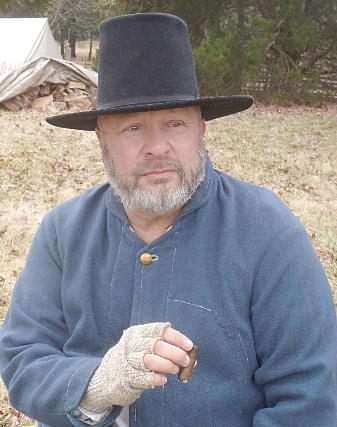
14 Civil War News March 2020
Available online at http://booklocker.com/books/9403.html Amazon.com and Barnes & Noble. Hardcover, 534 pages.
Corn
$39.95
Soldiers (Group) “Corn Harvest.” (Library of Congress)
1st Georgia, Oglethorpe Light Infantry Presentation Sword
by Shannon Pritchard
Thirty-three year old Methodist preacher, James Osgood Andrew Clarke, enlisted in the Georgia Volunteers, on March 16, 1861, as Captain of the Oglethorpe Light Infantry. He had previous military experience serving in the Mexican War. The 1st Georgia Volunteers, CS (Ramsey’s) was formed at Camp Oglethorpe, Macon, Ga., in April 1861, with the Oglethorpe Light Infantry as Company D. Clarke was signing documents as a lieutenant colonel as early as April 30,
1861, although the record showing his official promotion date is missing.

The men were raised in Macon, Newnan, Perry, Augusta, Sandersville, Atlanta, Bainbridge, Quitman, Dahlonega, and Columbus. The regiment went to Pensacola, Fla., then north to Virginia. The War Department sent the First to western (now West) Virginia and the Shenandoah Valley where they served under R.S. Garnett and H.R. Jackson, then was attached to General D.S. Donelson’s
Brigade during Lee’s Cheat Mountain Campaign.
They met with an initial success in a minor skirmish at Laurel Hill, but then were involved in
a disastrous retreat and the rear guard fights at Kalers Ford and Corricks Ford, during which six companies were cut off and became lost in the rugged Alleghenies, starving to the point of contemplating cannibalism.
The First fought well in the Confederate victory at Greenbriar River. Subsequently, they were sent to the Shenandoah Valley and served under General Thomas J. “Stonewall” Jackson. The regiment suffered horribly dealing with the winter ice and
snow as they followed Jackson on marches to Bath, Hancock, and Romney. After being left isolated in winter quarters at Romney, the Georgians came near to mutiny. When one of his men assaulted General Taliaferro, charges were preferred against Colonel Clarke, causing him to resign in November 1861. He, and soon the regiment, returned to Macon and were mustered out of service. Most members joined other commands and went back to Virginia. Clarke reentered service as a
The ornately cast brass mount is inset with an engraved silver scene depicting mankind confidently climbing the hill of adversity, while carrying a flag that is engraved with “Excelsior” which means, ever upward.
The scabbard’s lower mount has a silver inset engraved with Lady Liberty, holding a liberty cap on a spear. This was a patriotic motif that all of the era recognized.

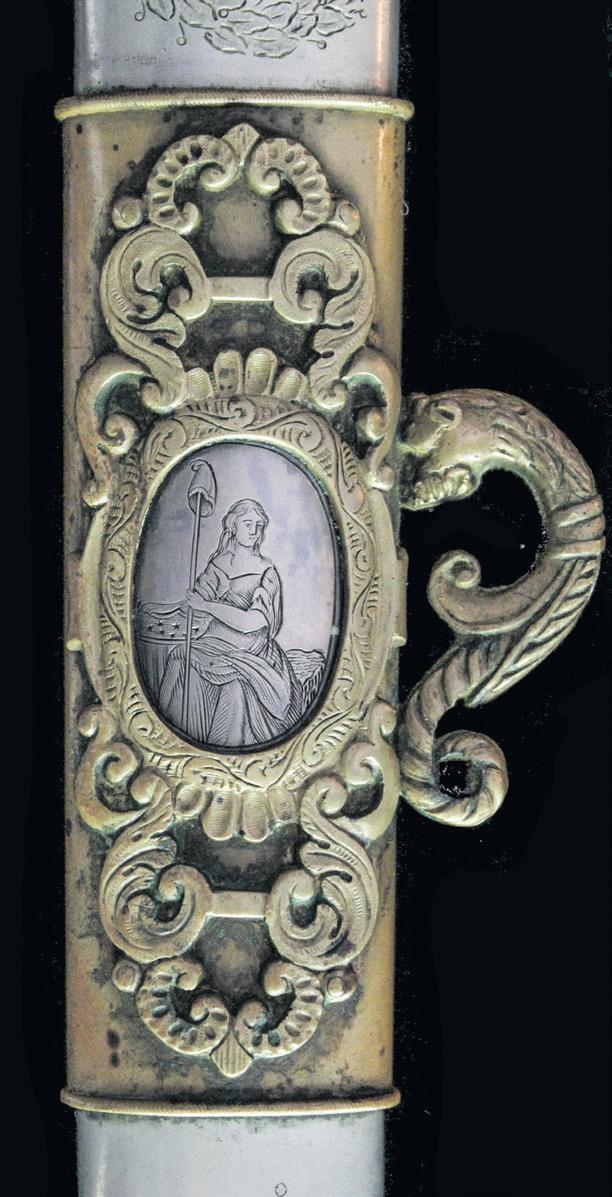



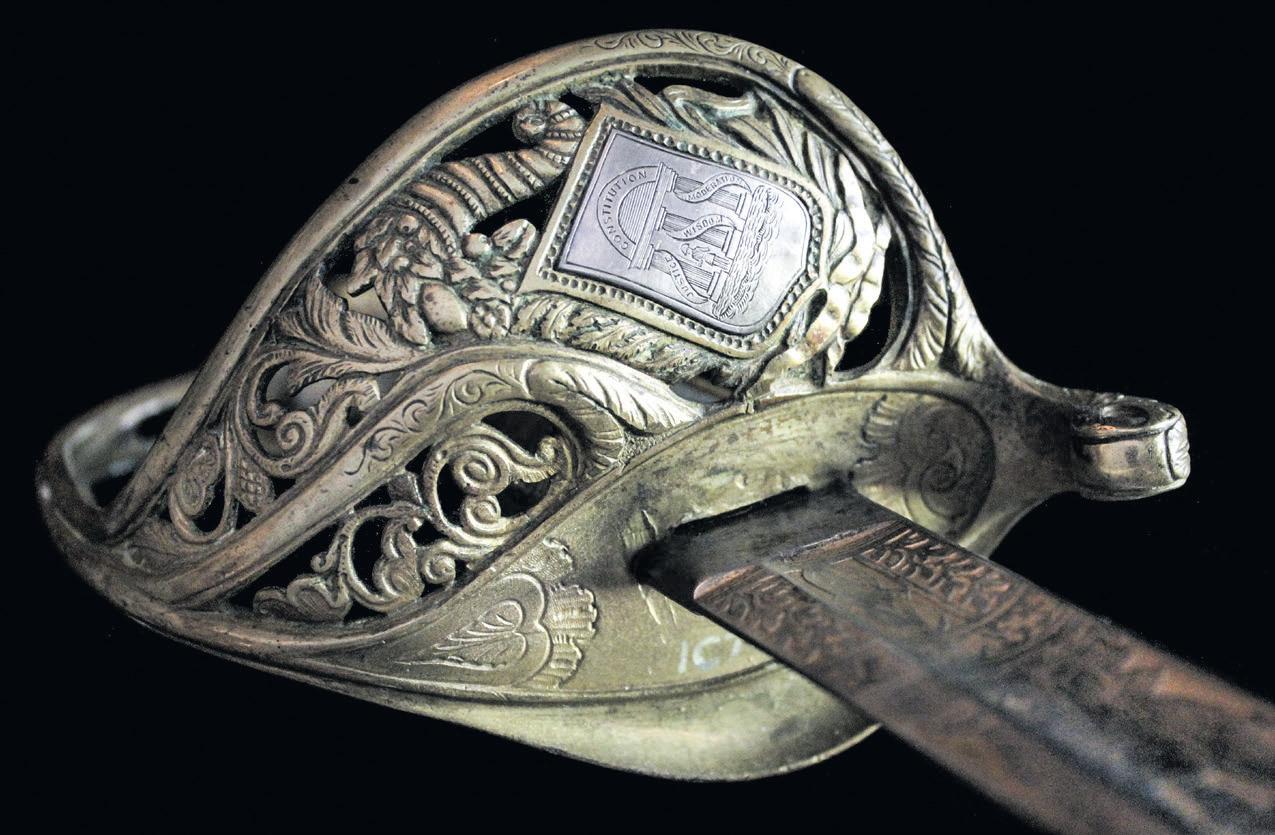

brass, cast drag is little less ornate than the mounts themselves.
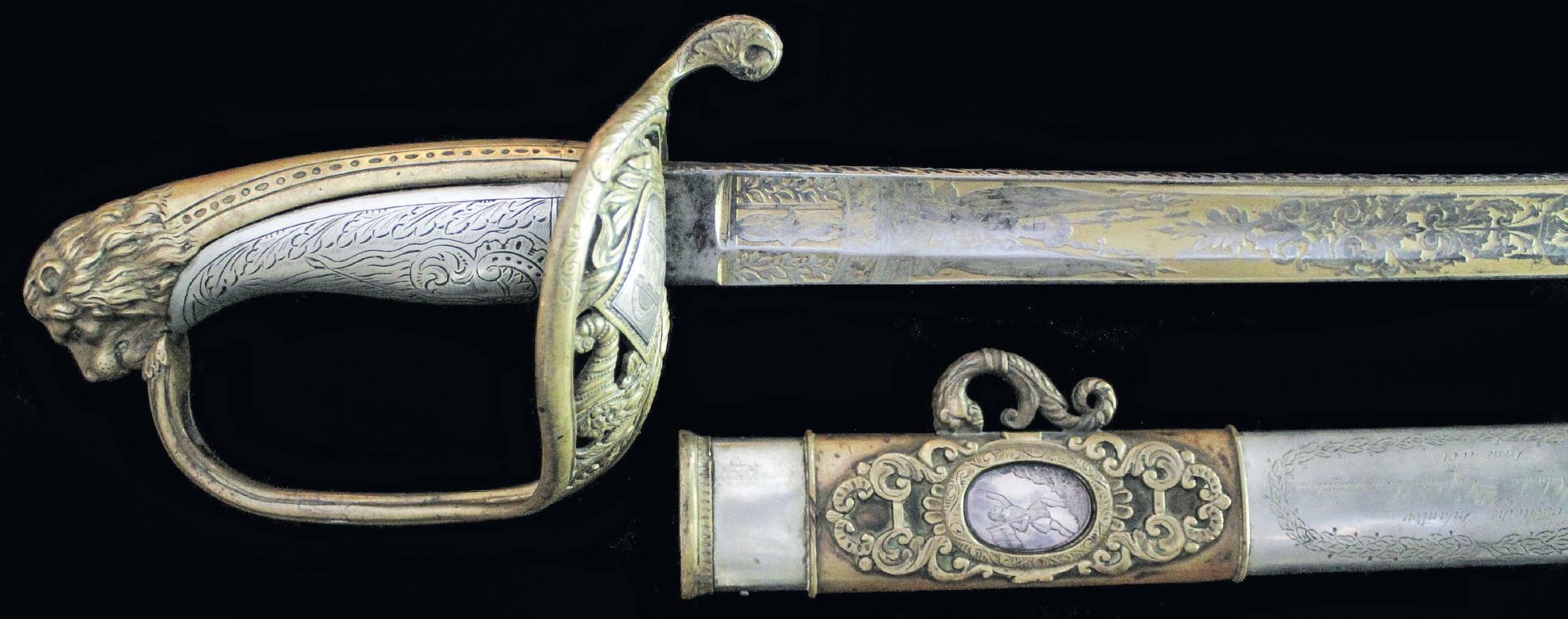
15 March 2020 Civil War News Deadlines for Advertising or Editorial Submissions is the 20th of each month. Email to ads@civilwarnews.com
The laurel bordered presentation panel is engraved “Oglethorpe Infantry to James O Clarke Captain Commanding, June 1861.
The lion head pommel staff officer’s sword is coin silver mounted, with a gold washed blade.
The scabbard is silver plated in all areas not covered in brass. All photos courtesy OldSouthAntiques.com.
View of the basket with silver Georgia state seal inlay.
The sword features an exquisitely engraved, coin silver grip.
The
The Georgia state seal, the constitution, resting on the pillars of justice, wisdom and moderation.
Lieutenant and Drill Master at a Georgia Camp of Instruction. He was already serving, but his official appointment date was July 29, 1862. He continued in that position through 1863 at the least; due to the dearth of records, his discharge date cannot be determined, but I assume that he served through the remainder of the War.
Colonel Clarke had a remarkable career in the ministry after the War, and I found hundreds, if not thousands, of newspaper accounts mentioning him and referring to him as a professor, minister, and doctor. He went
to his reward on Sept. 4, 1894; his earthly remains are buried in Magnolia Cemetery, Augusta, Richmond County, Ga.
The “Captain’s” ornate sword was presented to him by the men of the Oglethorpe Light Infantry in June 1861. It was manufactured by Horstmann & Sons, Philadelphia. The sword and its scabbard are ornately decorated with solid silver, engraved patriotic Georgia motifs, and an engraved silver grip. The blade is deeply etched with more patriotic motifs that are brought out in strong relief with a gold overlay on the recesses.


The sword and its scabbard are in near new condition, still glowing with their original beauty.
Shannon Pritchard has authored numerous articles relating to the authentication, care and conservation of Confederate antiques, including several cover articles and is the author of the definitive work on Confederate collectibles, the widely acclaimed Collecting the Confederacy, Artifacts and Antiques from the War Between the States, and is co-author of Confederate Faces in Color.
The American Battlefield Trust, the nation’s premier battlefield preservation organization, marked another year of leadership in the fields of historic land conservation and place-based education in 2019. No matter how you want to measure, whether by land saved, Americans educated, or steadfast donors engaged, it was a year of milestones

With the help of generous donors, alongside strategic partnerships with government officials and nonprofit groups across the country, the Trust protected more than 1,176 acres of battlefield land in ten states during 2019, preserving in perpetuity properties deeply rooted in American history, while welcoming more than 10 million visitors eager to learn about this nation’s past to its website www.battlefields.org and its YouTube channel.
Attesting to the tremendous loyalty exhibited by Trust members, the organization recorded its two-millionth donor gift on behalf of battlefield preservation during December. That donation came from retired sergeant William B. Bristor Jr., of Ellicott City, Md., who gave $100 in recognition of Trust president Jim Lighthizer’s retirement announcement. Mr. Bristor has been invited to be a guest of honor at the Trust’s upcoming annual conference in Chantilly, Va.
“Even after 20 years at the helm of this incredible organization, I remain in awe of the remarkable support given by our members for protecting America’s historic landscapes. Although this is the last full calendar year I will spend as its leader, all the pieces remain in place for the Trust to continue setting aside these
national treasures for the benefit of generations yet to come,” said Lighthizer, who told members in November that a search had begun to identify his successor.
Working closely with landowners and preservation partners, the Trust completed 24 transactions at 17 battlefield sites, including: Bentonville, N.C.; Bristoe Station, Va.; Champion Hill, Miss.; Cold Harbor, Va.; Fort Blakely, Ala.; Franklin, Tenn.; Gettysburg, Pa.; Hanging Rock, S.C.; Newtown, N.Y.; Peebles Farm, Va.; Rappahannock Station, Va.; Sailor’s Creek, Va.; Saratoga, N.Y.; Second Manassas, Va.; Shiloh, Tenn.; South Mountain, Md.; and Wilson’s Creek, Mo. Meanwhile, meaningful progress was made toward dozens of other transactions that will be completed in the months to come.
Of particular note was the acquisition of 50 acres at Cold Harbor, Va., that had once been slated to become a massive sportsplex with six soccer and lacrosse fields, acres of parking lots, and night illumination that towered over the battlefield. However, the Trust was able to negotiate a purchase agreement with Hanover County and raise the necessary $1 million for the land’s preservation.
Acreage saved is an important benchmark in battlefield preservation; however, the Trust is also fully committed to advancing history education programs designed for both traditional classrooms and lifelong learners engaging from home. By the close of the 2018–2019 school year, our Field Trip Fund had sent more than 30,000 young people on class trips to historic sites. Meanwhile, nearly 200
Civil War Artillery Book
Civil War News publisher, Jack W. Melton Jr., is proud to announce his new 392 page, full-color book, Civil War Artillery Projectiles – The Half Shell Book.

For more information and how to order visit the website www.ArtillerymanMagazine.com or call 800-777-1862. $89.95 + $8 media mail for the standard edition shown here. The limited edition deluxe edition is $125 + $8 media mail. Civil War Artillery Projectiles –The Half Shell Book cover.
100 Significant Civil War Photographs:


Atlanta Campaign collection of George Barnard’s camera work. Most of the photographs are from Barnard’s time in Atlanta, mid-September to mid-November 1864, during the Federal occupation of the city.
With this volume, Stephen Davis advances the scholarly literature of Barnardiana.

16 Civil War News March 2020
The American Civil War was the first war in which both sides widely used entrenchments, repeating rifles, ironclad warships, and telegraphed communications. It was also the first American War to be extensively photographed. Mathew Brady, Alexander Gardner and Timothy O’Sullivan are famous for having made iconic photographs in the Civil War’s eastern theater. George N. Barnard deserves to be ranked in this top tier for his photographic A civilian photographer hired by Gen. William T. Sherman’s chief engineer to take pictures of fortifications around Atlanta, Barnard took several hundred of them in and around the city in the fall of 1864. His most famous is the site of Union Maj. Gen. James B. McPherson’s death in the battle of Atlanta, July 22, 1864. Thus far, no comprehensive, definitive listing has been made of the photographer’s work. The Library of Congress has 130 images; the U. S. Military Academy at West Point, New York, has at least 98 photographs, donated by Captain Poe’s widow. Other repositories, such as the Gilder Lehrman Institute of American History in New York City, have smaller collections. For this book we have chosen hundred images we deem “significant,” though other students may wonder at some of our selections. We hope that this work will stimulate further interest in Barnardiana, and that other scholarly volumes are yet to come. The Atlanta Campaign STEPHEN DAVIS 100 SIGNIFICANT CIVIL WAR PHOTOGRAPHS ATLANTA CAMPAIGN $19.95 + $3.50 shipping 128 pages, photographs, maps, bibliography. $19.95 + $3.50 shipping. Softbound. ISBN: 978-1-61850-151-6. www.HistoricalPubs.com. Order online at www.HistoricalPubs.com or call 800-777-1862
The panoply of arms is etched in deep relief, and brought out in stunning clarity with a gilt background.
Another blade etching featuring a roman soldier; after etching the panel was chased to add detail.
Still another beautifully etched and chased panoply of arms.
professional educators joined us in Raleigh, N.C., for the 19th annual National Teacher Institute, a free continuing education weekend where teachers participate in workshops and other sessions designed to help them integrate the latest techniques in bringing the past to life for students.
In October, the Trust launched 1864: A Virtually Reality Experience, that has already achieved more views than any other video in its catalog of more than 500 titles, as nearly 650,000 users have flocked to this immersive experience of Civil War combat. The organization also launched its inaugural Youth Leadership Team, a group of ten dynamic high school students working alongside the Trust to promote historic preservation and history education in their own communities. In addition to holding advocacy meetings with their elected officials, each participant is pursuing a project designed to increase engagement on the local level.

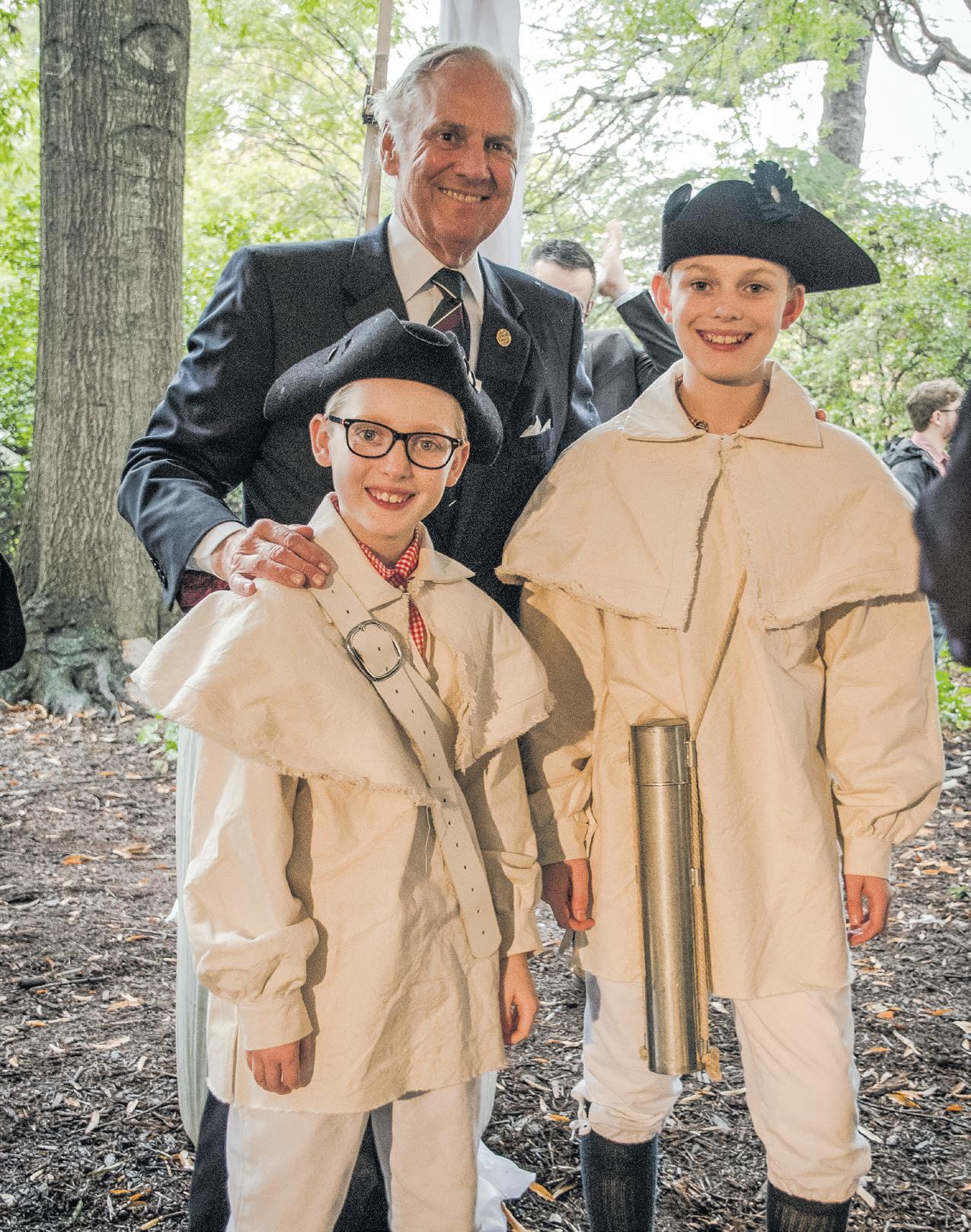
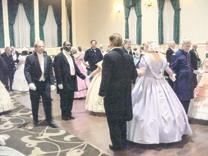
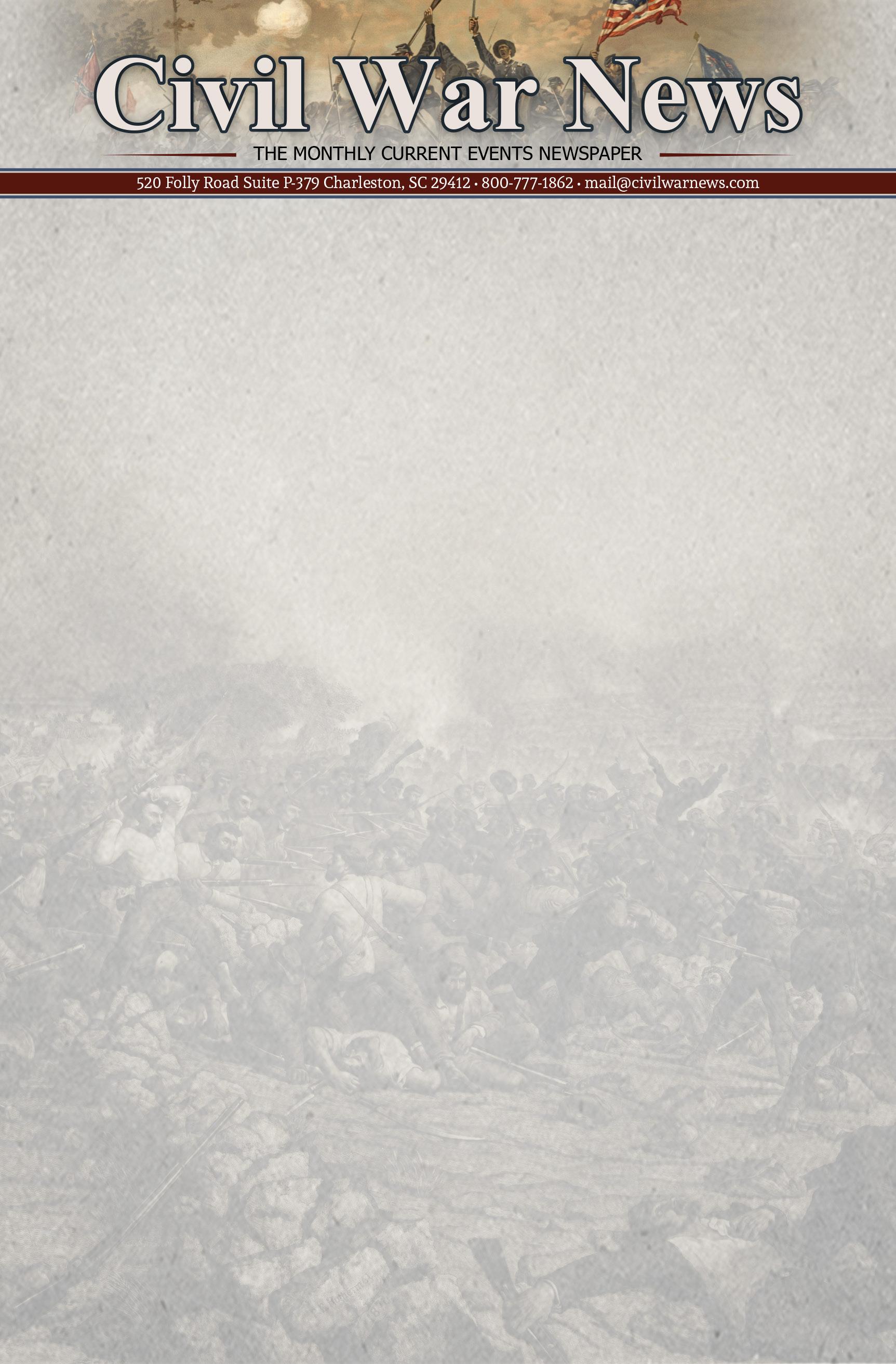
October also saw the launch of The Liberty Trail, a joint heritage tourism and preservation initiative alongside the South Carolina Battleground Preservation Trust that seeks to promote the Palmetto State’s leading role in the founding of the United States, during a Columbia event hosted by Governor Henry McMaster. Ultimately, the effort will link 70 sites across the state with a new driving tour that functions as a one-of-a-kind educational and heritage tourism resource. As part of the effort, some 2,500 acres of battlefield land will be preserved, and five new parks will be created.
Demonstrating its commitment to deepening ties between members of the modern military with their historic forebearers, the Trust launched a stirring series of videos entitled Brothers in Valor, that highlighted parallels between Civil War Medal of Honor recipients and contemporary honorees. Thanks to a July initiative, some 3,000 active and veteran servicemen or women took advantage of free memberships to the organization. The Trust also partnered with the National Park Service and American Veterans Archaeological Recovery to host a program at Saratoga National Historical Park that allows vets to participate in excavations on an American battlefield, a project profiled in the winter issue of our membership magazine Hallowed Ground.
The past year was also significant federal legislation on behalf of battlefield protection. In March, the John D. Dingell, Jr. Conservation, Management and
Recreation Act was signed into law, expanding park boundaries at Shiloh National Military Park and Kennesaw Mountain National Battlefield Park; the act also established two Civil Warrelated national monuments in Kentucky, Camp Nelson National Monument and Mill Springs Battlefield National Monument.




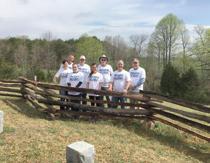



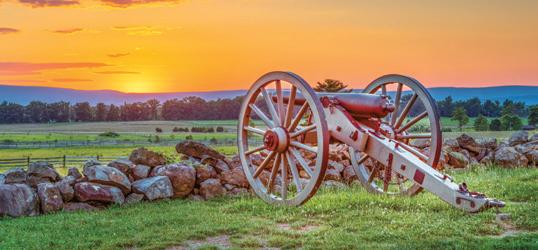

In December, the Preserving America’s Battlefields Act reauthorized the federal Battlefield Land Acquisition Grants Program through FY 2028 at $18 million annually. Under the act similar matching grant streams will be made available to assist in restoring and interpreting protected battlefield landscapes; up to $1 million will be available in each category annually. A truly bipartisan bill, it acquired 101 co-sponsors, 51 Democrats and 50 Republicans, in the House of Representatives and seventeen cosponsors in the Senate.
The Trust’s preservation work in 2019 would not have been possible without the dedication of numerous partners, including: the American Battlefield Protection Program; National Park Service; Adams County, Pa.; Battle of Franklin Trust, Inc.; Chemung County, N.Y.; The Conservation Fund; Fauquier County, Va.; Franklin’s Charge, Inc.; Frederick County, Md.; the HTR Foundation; Katawba Valley Land Trust, Inc.; Lancaster County, S.C.; Land Conservancy
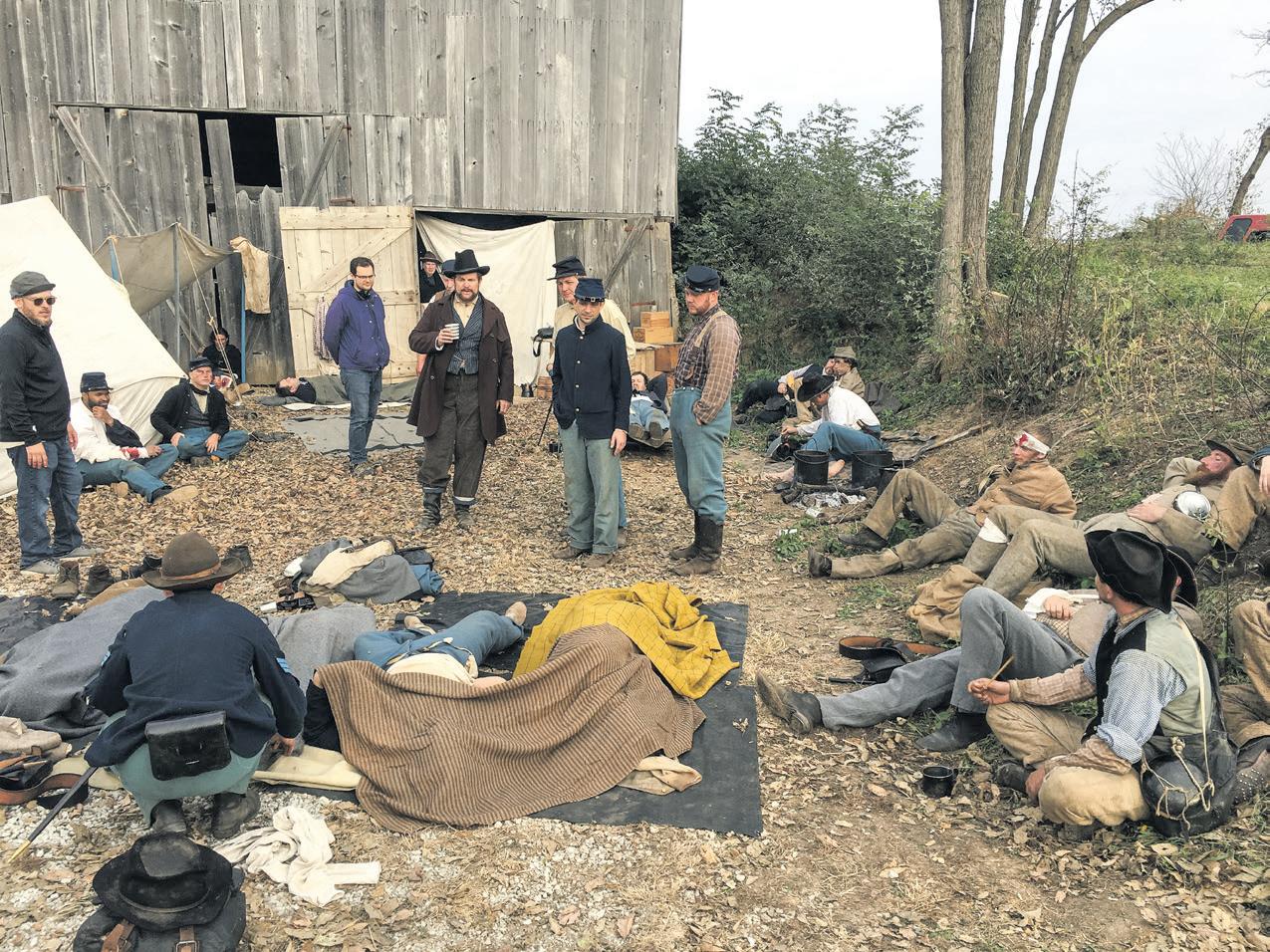
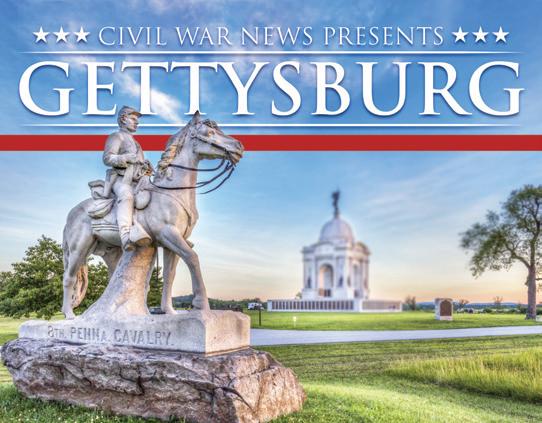
of Adams County; Maryland Environmental Trust; Maryland State Highway Administration; Mississippi Department of Archives and History; National Park Partners; Natural Resource Conservation Service; North Carolina Department of Natural & Cultural Resources; Prince William County, Va.; the Pritzker Foundation; Save Historic Antietam Foundation; South Carolina Battleground Preservation Trust; South Carolina Conservation Bank; State of New York; Tennessee Civil War Sites Preservation Fund; Tennessee Historic Commission; University of South Alabama; U.S. Department of Agriculture; Virginia Battlefield Preservation Fund; Virginia Department of Conservation and Recreation; Virginia Department of Historic Resources; Virginia Land Conservation Fund; Virginia Outdoors Foundation; the Volgenau Foundation; and Wilson’s Creek Battlefield Foundation.
As we look toward another year of success in 2020, the Trust is deeply grateful to these and other partners without whom our work would be less viable and dynamic, but especially, we thank everyone who made a contribution to our cause. Two million individual donations to any cause is remarkable, and we are honored by the trust these members place in us to be quality stewards of their gifts.
17 March 2020 Civil War News Historical Publications, LLC Civil War News • 800-777-1862 520 Folly Road, Suite 25 PMB 379 Charleston, SC 29412 www.CIVILWARNEWS.com UP-TO-DATE COVERAGE • PRESERVATION NEWS • BOOK REVIEWS SHOWS, LIVING HISTORY AND REENACTMENTS • HISTORICAL ARTICLES MONTHLY COLUMNS • CALENDAR OF EVENTS STAY INFORMED! Only $38.50/One Year • $66.00/ Two Years THE MONTHLY CURRENT EVENTS NEWSPAPER -FORCIVIL WAR ENTHUSIASTS SINCE 1974 12 ISSUES PER YEAR PRINT & DIGITAL EDITIONS AVAILABLE CALL OR SUBSCRIBE ONLINE TODAY! 2018 CW N 44, $3.50 America’s Monthly Newspaper For War Enthusiasts War acres states! Culpeper Virginia. Friends Mountain Civil War Trust’s Path to Preservation CW N No. Pages, Civil War News America’s Newspaper Enthusiasts Holzer Dancingsee this issue: GETTYSBURG, the industryaround spirits. might placesmore where then departedplace McClellan’s owners. now nursed woundedwoman ballroom. believe these banquet eraroomRemembrance andPenn., Karen beentionsDay, photographs thestories meantime, please dancers Dancing the Night Away at the Gettysburg Hotel Poretsky guides Lincoln Scholar Harold Holzer’s Oration at the 154th Anniversary of the Gettysburg Address Gettysburg spot—in Washington—standscoln clutchingbecauseAmerican freedmen. “unveiledbronze, something great today, fashion— politically the kneeling theDespite endure, suchwithoutcontroversy—the roiling country.remember Gettysburg who mightgallery,uments:and subjects secessionwhenequal—remained an coming—inspeech own, other Lincoln INSIDE EVERY ISSUE
Young participants in our March Generations event “Charge and Countercharge at Cedar Mountain” marveled at seeing Civil War photos as they were designed to be viewed – in 3D.
A behind the scenes look at filming of Civil War 1864: A Virtual Reality experience, an innovative collaboration with Wide Awake Films that swiftly became the most-watched video in Trust history.
Governor Henry McMaster celebrated with young history lovers during the October even that officially launched the Liberty Trail, an ambitions preservation and heritage tourism project for Palmetto State Revolutionary War sites pursued in partnership with the South Carolina Battleground Preservation Trust.
Confederate Imprints
Imprint: “…an indelible distinguishing effect or influence;” is one definition Webster offers. Duke University defines Confederate Imprints as: “… items printed in the Confederate States of America between secession from the Union and the surrender of the Confederate military forces (December 1860-April 1865).” Researchers can bring visualization to this part of our nation’s history through mining the various repositories, in person or online, which hold thousands of items printed in the Confederacy. For this article, we will focus on those institutions with more
substantial holdings, and especially those offering digitized imprints online. Researchers interested in consulting books to assist in locating specific imprints can benefit from several available sources, including state-specific titles. Of note, the two-volume Confederate Imprints: A Check List Based Principally on the Collection of the Boston Athenæum. Check https://www. worldcat.org to find a copy in a local library, or view online at https://catalog.hathitrust.org/ Record/001168298.

The repository holding the most extensive collection of Confederate imprints is the Boston Athenæum (see Fig. 1 for an example). Shortly after
the war ended, historian Francis Parkman and colleagues traveled to Richmond and made several acquisitions. Thus, the beginning of a rich collection, one, which prompted James Ford Rhodes to weave the picturesque description of a researcher’s visit to the Athenæum that will close this article. The image above shows the Boston Athenæum homepage at https://cdm.bostonathenaeum.org/digital/collection/ p16057coll14, where one can view over 4,000 images –t printed material ranging from government and state documents, military manuals, maps, poetry, textbooks, religious tracts, church publications, almanacs, and more. Each of the online collections (readers will find the websites listed at the end of the article) offers the ability to search using keywords, retrieve results, and download images for personal use. One note, commercial use will require permission from the holding institution.
To demonstrate the Athenæum website, this writer conducted a search using the keywords “religious tracts.” This image shows the 122 results from the search shown in Fig. 2.

A search using the same keywords, from the Duke University Libraries, Confederate Imprints website (https://archive.org/details/dulci?tab=about), yielded the results shown in Fig. 3. Researchers can bookmark the following Confederate Imprint websites for future reference. Many other sites, most offering smaller collections, exist. Conduct your own search for more sources!
Confederate Imprint Websites
• Boston Athenæum: https:// cdm.bostonathenaeum. org/digital/collection/ p16057coll14
• Duke University Libraries: https://archive.org/details/ dulci?tab=about

• Library of Congress: https:// www.loc.gov/collections/broadsides-and-other-printed-ephemera/? -
dates=1860/1869
• Digital Library of Georgia: http://american-south. org/collections/geu/ confederateimprints/ items/?Welcome
• Internet Archive: https://archive.org/search.php?query=confederate%20imprints%20AND%20 mediatype%3Atexts

Let us close with the words of Rhodes. “The older man settles himself in the Confederate room, and as he gazes at the bound volumes of newspapers and at the other volumes, the outside aspect of which is eloquent of the life in the Southern Confederacy… he blesses the men who had the forethought to make so valuable a collection for him as he thinks and writes of society at the South.” Next month, we will explore additional primary sources. Until then, good luck in researching the Civil War!
Michael K. Shaffer is a Civil War historian, author, lecturer, instructor, and a member of the Society of Civil War Historians, the Historians of the Civil War Western Theater, and the Georgia Association of Historians. Readers may contact him at mkscdr11@gmail.com, or to request speaking engagements, via his website www.civilwarhistorian.net. Follow Michael on Facebook www.facebook.com/ michael.k.shaffer and Twitter @ michaelkshaffer.
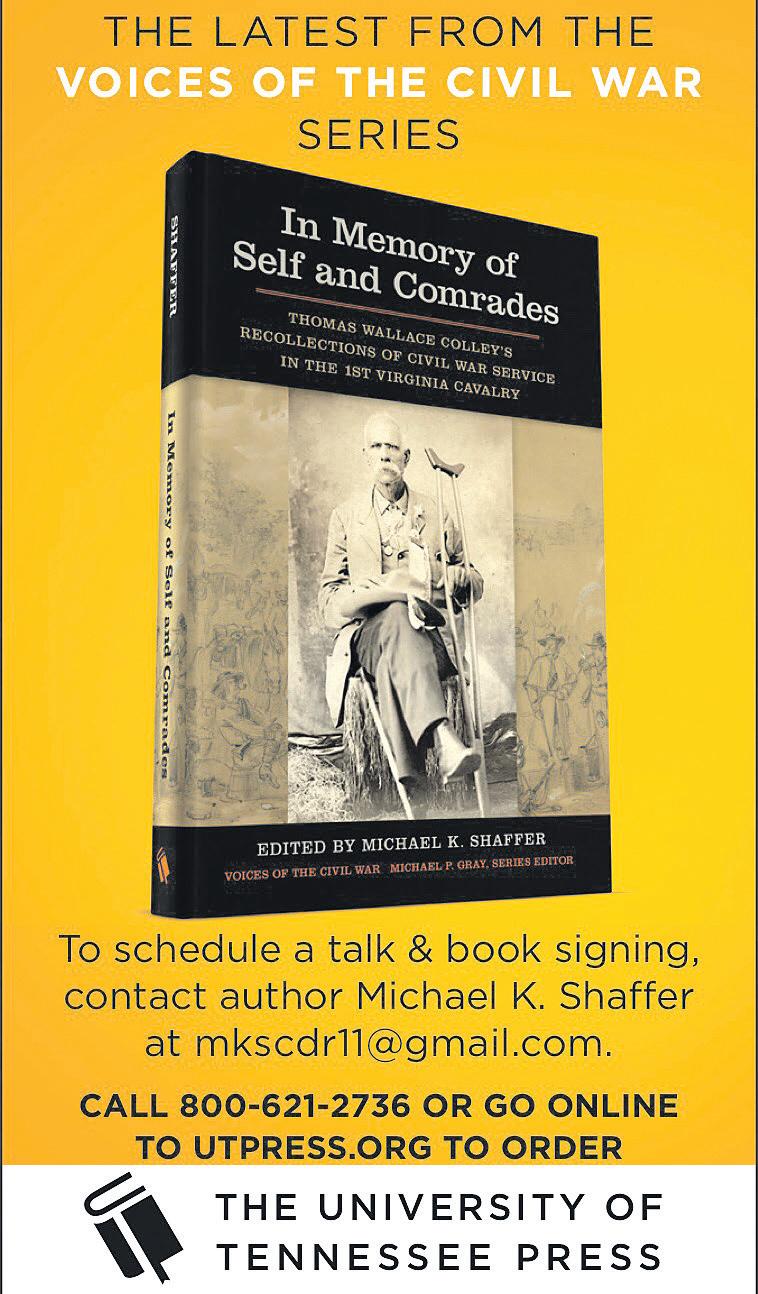
18 Civil War News March 2020 Deadlines for Advertising or Editorial Submissions is the 20th of each month. Email to ads@civilwarnews.com
Fig. 1. Boston Athenæum website.
Fig. 2. Boston Athenæum religious tracts
Fig. 3. Duke University religious tracts
25th Annual Chickamauga Civil War Show and Sale
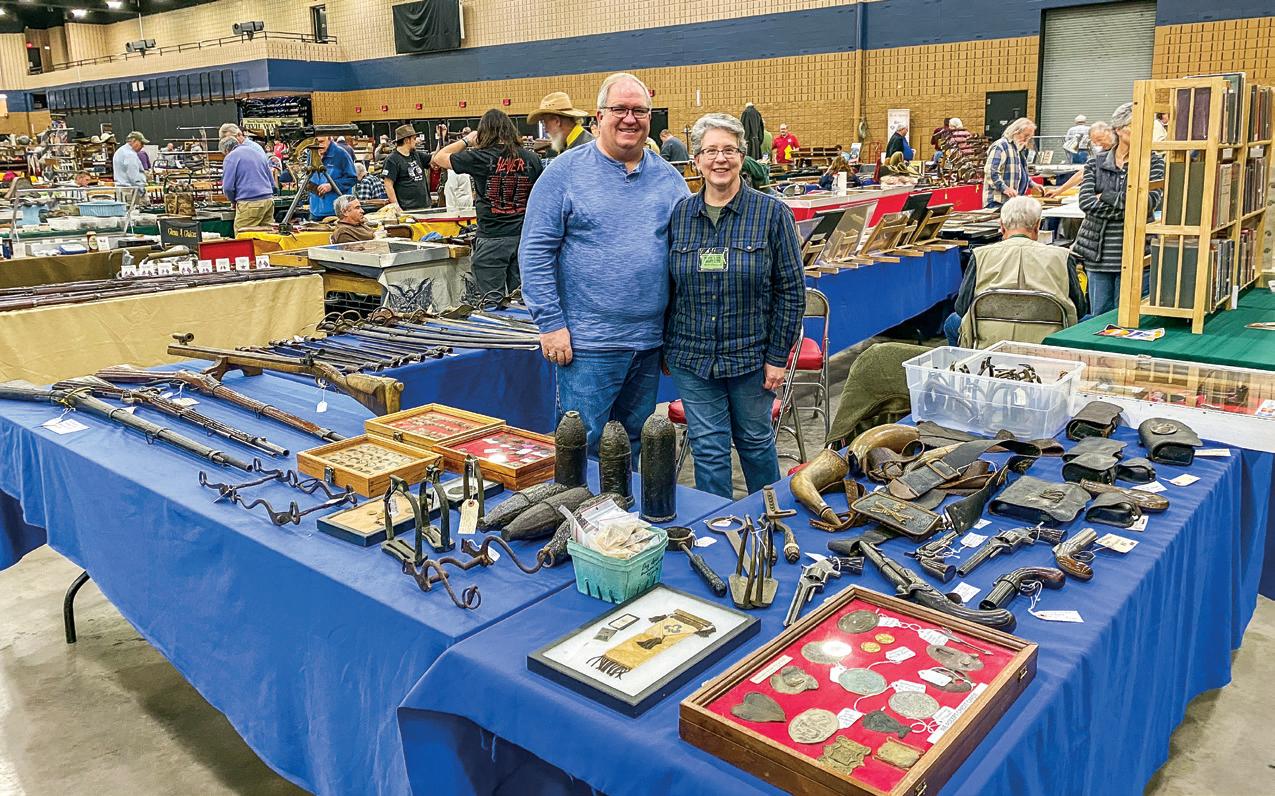
DALTON, Ga.—The 25th Annual Chickamauga Civil War Show and Sale went off without a hitch on February 1 and 2 at the Dalton Convention Center in Dalton, Ga. The weather was perfect for a show with cool temperatures and rain on Saturday driving the public in to spend the day among 500 tables of authentic Civil War weapons, artifacts, and memorabilia presented by many of the nation’s top dealers and collectors.
This show is always a gamble, weather wise, according to promoter Mike Kent of MK Shows. With the Dalton Convention Center located atop a mountain just off I-75 at Exit 333, a little ice or snow could have a major impact. That is why this show is always covered by weather cancellation insurance. I watch the weather reports continuously right up until show time, but I sleep a lot better knowing I have insurance in case a winter storm hits, continued Kent.
This is Kent’s third Civil War show in the last 3 months; it was just as successful as the outings in Richmond, Va., in November, and Franklin, Tenn., in December. All tables were sold weeks in advance at all three shows with waiting lists in case there were any last minute cancellations,

always a good sign the Civil War industry as a whole is still healthy and vibrant.
The crowd was strong wit numbers up slightly from 2019. The lobby was packed with over 200 folks as the clock approached the 9 a.m. opening bell so tickets were presold to expedite the admission process. As usual, the lobby was also a key central location for several nonprofit groups such as local SCV camps, historical sites, and the Convention and Visitors Bureau. The Civil War Roundtable of Atlanta made a strong showing again this year with several carloads of members caravanning to shop, visit, and renew old friendships at the show. MK Shows donates tables free of charge to many groups each year as a way of giving back to the communities and organizations that support the shows.
Back this year Due to popular demand, the Civil War seminars held throughout Saturday were back this year. The speakers and their topics were as follows:
• Michael K. Shaffer – Atlanta Campaign: Into the Very Heart of the Confederacy.
• Brad Quinlan – Dignity, Honor, Character: The Story of the Medal of Honor and the Recipients From Chattanooga and Tenn.
• Greg Biggs – Stopping Hood: The U.S. Navy and the Tennessee Campaign.
• Gene Andrews – Biography of General Nathan Bedford Forrest.
While the topics and presentations were interesting, professional, and educational, the biographies of the presenters were amazing and could have been the subject of an entire seminar. Their collective experiences included numerous awards, books, speaking engagements, movies, war time service, and of course, a deep and abiding interest in the Civil War. These individuals are
to be commended for their willingness to share their knowledge and time with others.

Another addition this year were several live fire musket drills and demonstrations conducted by Fred Ufford of Co. F, 39th Ga. Inf. In addition to the musket demonstrations, Ufford also conducted a church service for dealers on Sunday morning dressed in period clothing.

No show would be complete without displays and Dalton was no exception. Winners this year included:
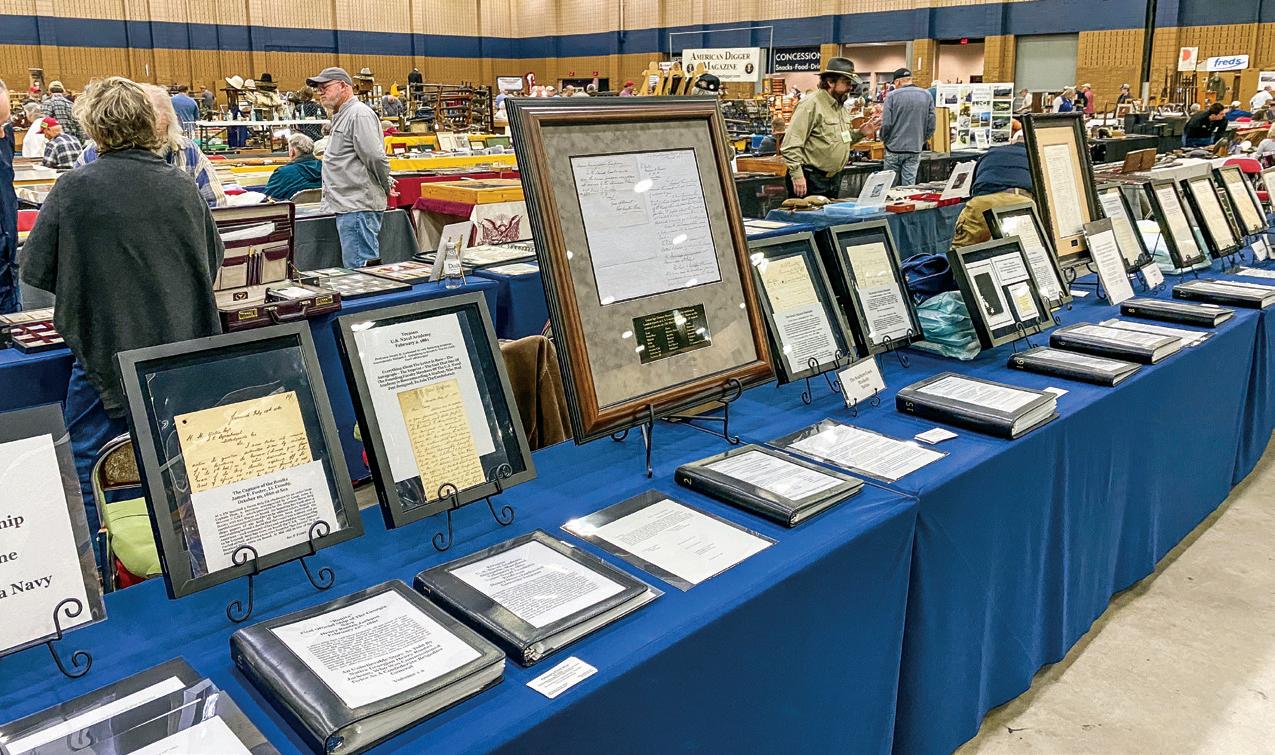
• Best of Show – Paul Gibson and Bob Edmondson: Blockade Runner Documents and Letters
• People’s Choice Award –Jerry Hayes: Confederate Buckles and Buttons
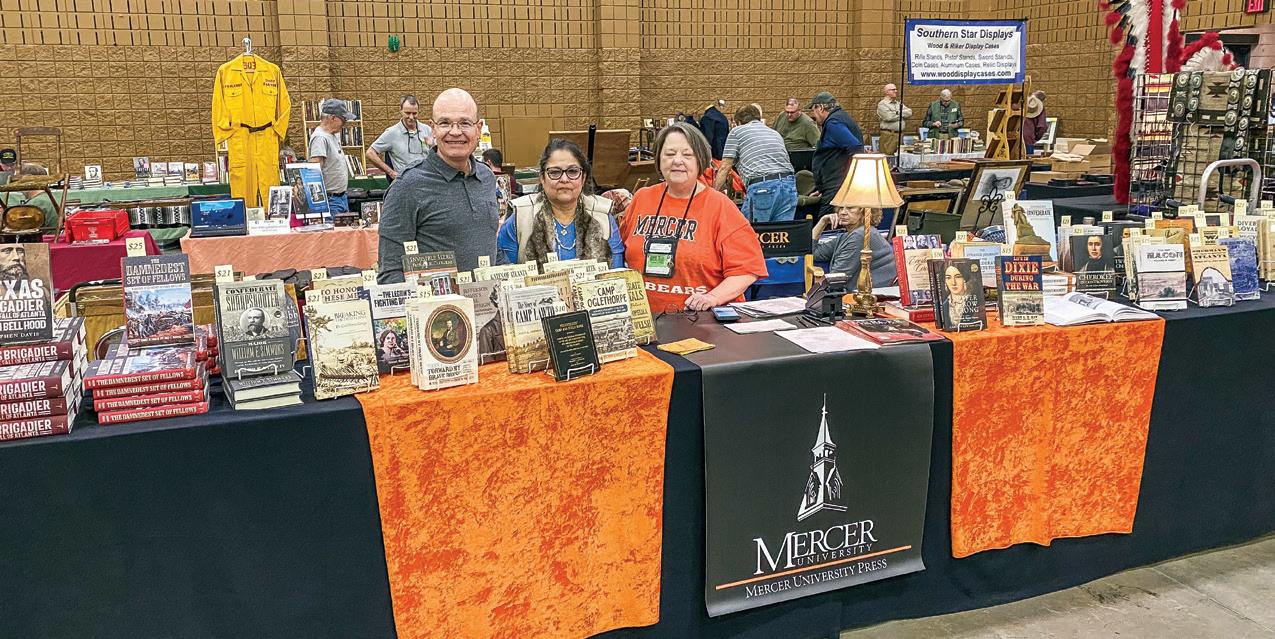
• Chairman’s Award – Bill Blackman: Confederate Buckles and Belt Plates

Kudos to those individuals who bring out their displays for public viewing at shows several times a year. It takes time, money, and effort to display and it is truly a labor of love as the rewards are few. A simple plaque to hang on a wall does not begin to make up for the lifetime of collecting and accumulating preceding a display coming to fruition. For these folks, a simple comment or word of appreciation about their display makes it all worthwhile. For information on all events sponsored by MK Shows, visit his website at MKShows.com or Mike@MKShows.

19 March 2020 Civil War News
Paul Gibson and Bob Edmondson’s display of Confederate blockade runner documents won the Best of Show Award.
Steve Strickland, President of the North Georgia Relic Hunter’s Association, and his wife Melody.
Award winners, Bill Blackman, Paul Gibson, Bob Edmondson, and Jerry Hayes.
The faces behind Mercer University Press: L to R: Author Garry Fisher, Zela Fisher, Marsha Luttrell of Mercer University Press.
Perry Cutshall of Mississippi Prospecting and Detecting Supply is enjoying his first Dalton show but is already planning to be back next year.
Sharpshooter Rifle
Dear John, My question is “Is there a fee for your appraisal/authentication services?”
I am the great great grandson of Pvt. Ira Lunt. He fought with Company D, 2nd Regiment USSS. He volunteered out of Maine but later settled in New Castle Delaware. I live in the house he built in New Castle. He was a stone mason by trade. Anyway, I am so lucky to have many items from his service. Most importantly I have the target rifle he used in the USSS. It’s in remarkably good condition. I would love to have it appraised and authenticated. I also have his Berdan SS Medal also in amazing condition. I have the molds for the bullets and many of his GAR medals as well.
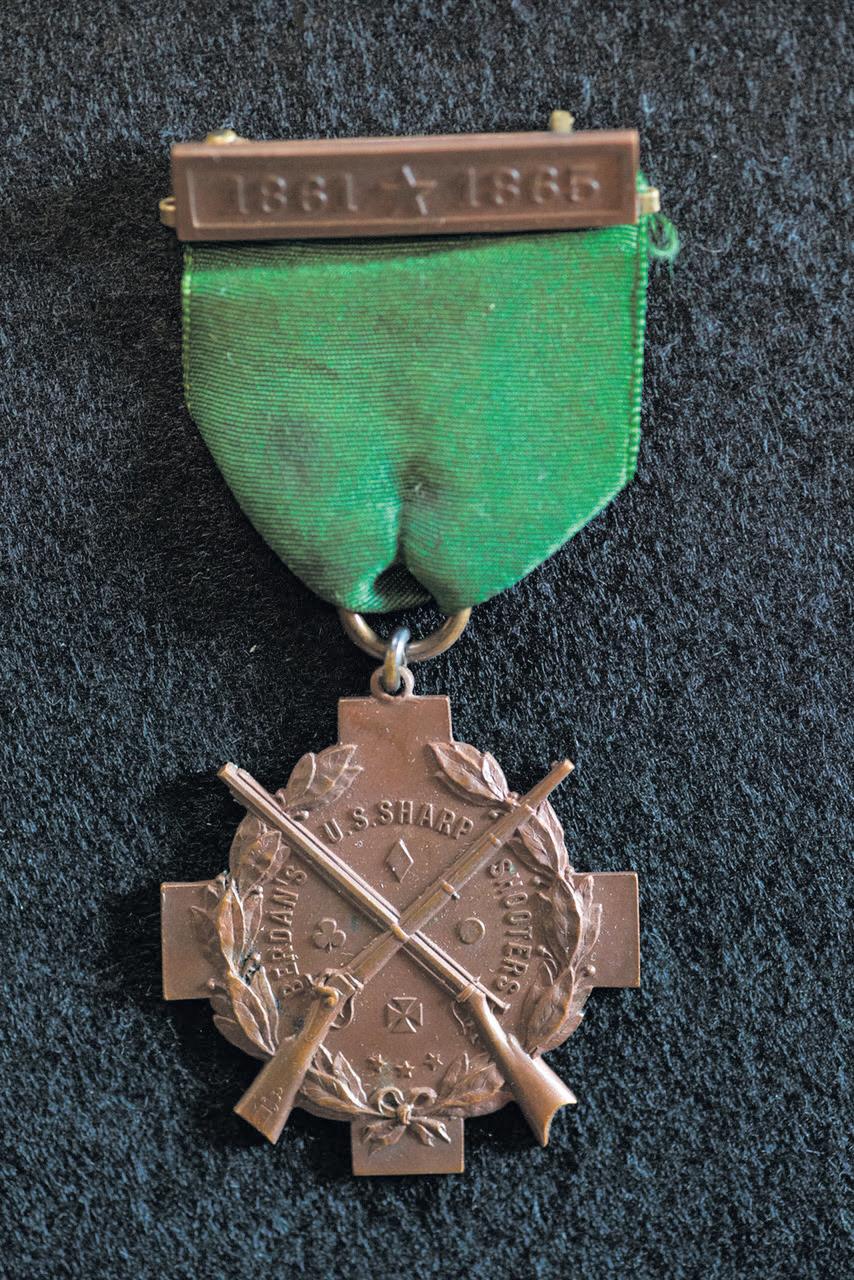
Thank you
T.W. Lunt

Dear Mr. Lunt, Hiram Berdan was the most
well known proponent of sharpshooters in the Civil War and “Berdan’s US Sharp Shooter’s” were the most famous unit of marksmen changing history with regular military use of dreaded snipers. There are several excellent texts written on Berdan and his men that give an indepth history.

Your great-great grandfather Ira Lunt was 33 years old when he joined Company D, 2nd US Sharpshooters. He had just transferred from the 17th Maine Infantry. Ira was from Oldtown, Maine, just north of Bangor.
Your rifle is most likely the finest and best identified of any heavy barrel sharpshooter’s rifle extant. The condition appears to be very good to fine retaining traces of finish with dark plum/ brown patina overall to barrel, lock, and breech. The scope and scope mounts also appear quite fine. Scopes are always so fragile, and usually damaged after

150 years, especially those of extremely long barrel length. Fortunately, this example has been stored in partitioned wood case box for a long time. The accessories all appear to be wartime though the large fluted brass powder flask looks out of place. The bullet mold, projectiles, cap containers, bullet starter, and “false muzzle” all appear original to time of use.
What makes this rifle so valuable and rare is the retained documentation including your ancestor’s original docketed letter requesting use of this custom “telescopic rifle” made for his specifications by Bangor, Maine, gunsmith, Malcom Long. It is amazing that the rifle is signed by the maker and we know that Ira Lunt’s rifle was used at Petersburg, Va., where sharpshooters, both Union and Confederate, were more prominent than any other
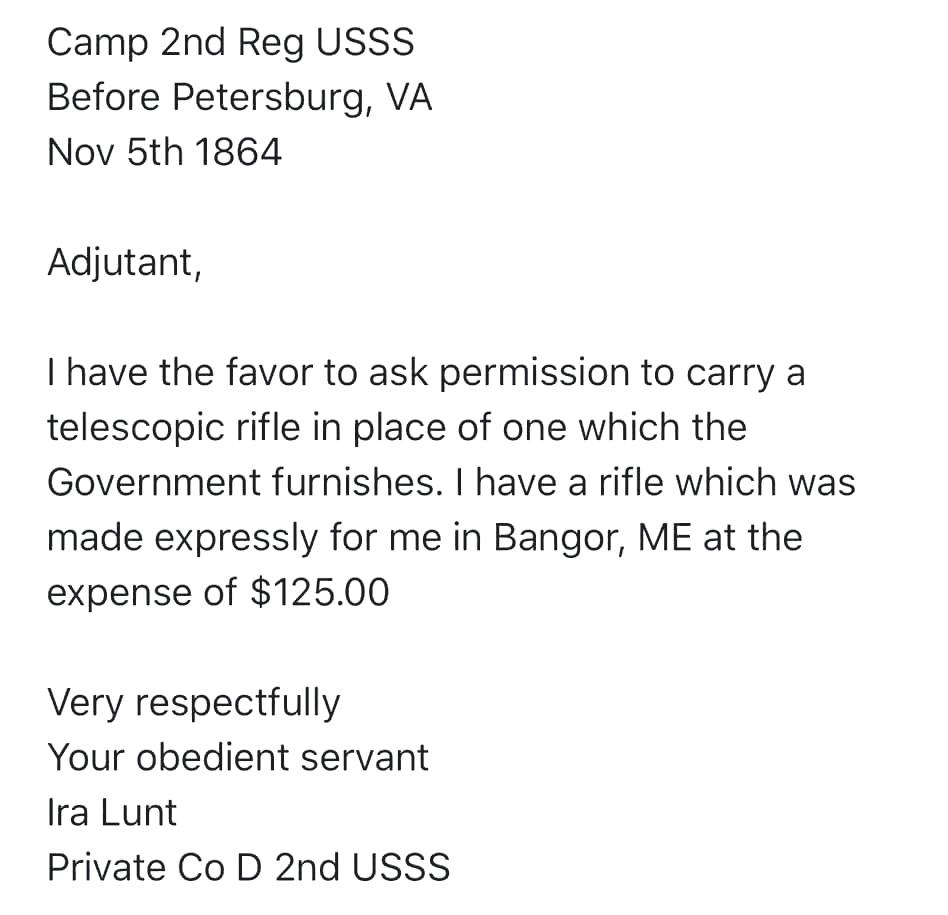
Note the cap containers are all Civil War era as are the “picket” bullets which are rare in excavated form from Civil War sites and highly sought by projectile collectors. They have long been associated with American long rifles.


Transcription of Ira Lunt’s request to use his personally purchased “telescopic rifle” he wrote from Petersburg, Va.

20 Civil War News March 2020
The old wood case retains two old brass powder flasks, the original brass/iron bullet starter for a false muzzle and “picket bullet” mold.
Most likely the finest surviving identified Berdan heavy barreled sharpshooter rifle. Made without the patchbox usually seen on sporting target rifles.
Ira Lunt when GAR post commander postwar.
Barrel markings of barrel maker O. Huse from Manchester, N.H., and Malcom W. Long (1834–1912) of Bangor, Maine, who made this rifle for Ira Lunt in 1864.
Berdan USSS membership medals sell for about $800 unidentified. This one should bring a premium.
time or place in the Civil War. The last fine heavy barrel scoped Civil War sharpshooter rifle sold in public auction in October 2016 for $18,400. That rifle was possibly used by the 1st Massachusetts Infantry but had no identification. This comparable property had similar condition but no history. Your rifle rates much higher with the
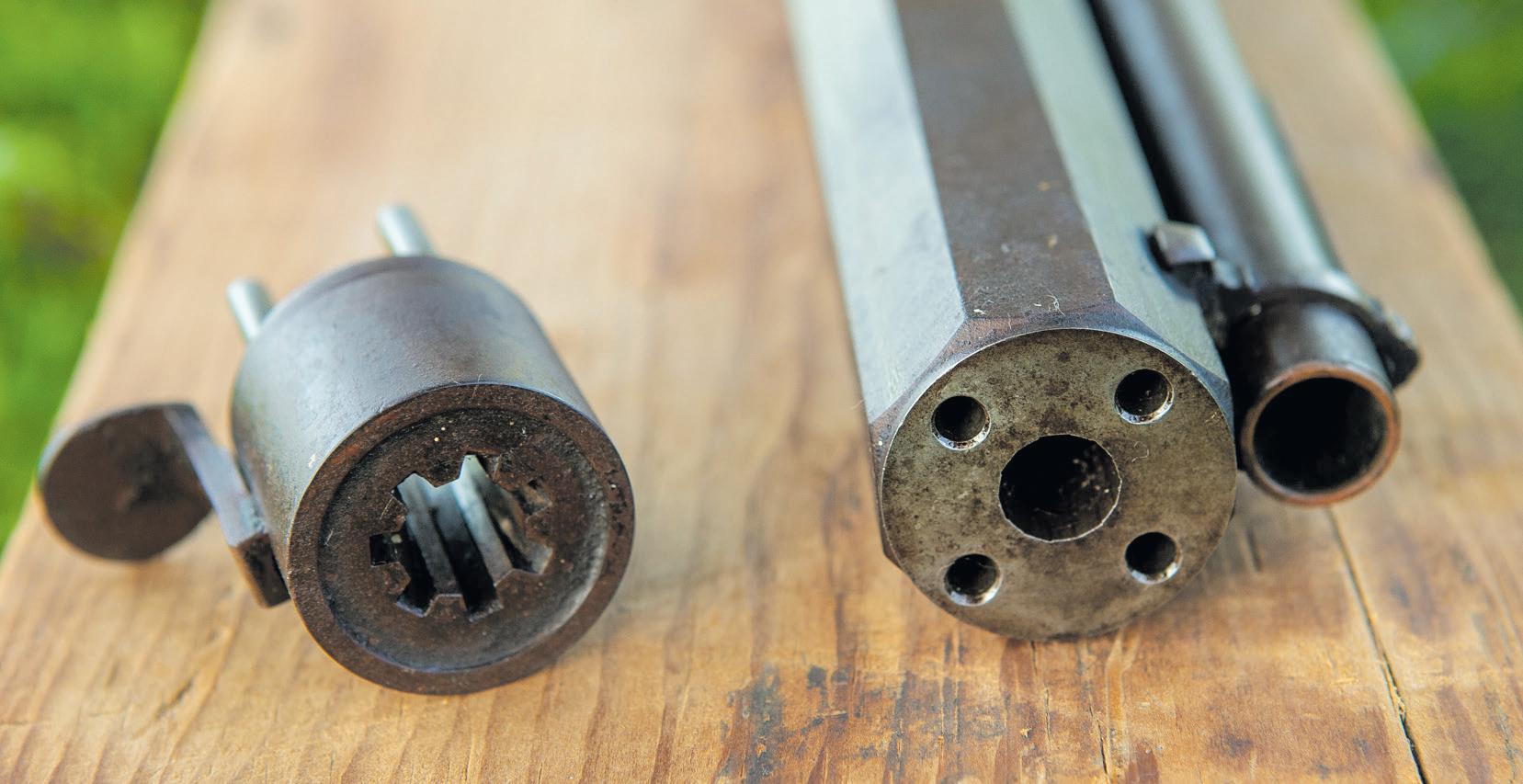
documentation that it indeed was used in the field during the Civil War. Value would be in excess of the $18,400 realized in comparable market in 2016. I would place an auction presale estimate on this rifle of $20,000-30,000 and not be surprised if it brings more.
Ira Lunt’s Service Summary
• “D” Co., US Army 2nd Sharp
Shooters
• Residence Oldtown ME; 33 years old.
• 9/2/1864 he transferred into “A” Co., 17th Maine Infantry
• On 9/13/1864 he mustered into “D” Co., US Volunteers 2nd Sharp Shooters
• He was transferred out on 2/1/1865
• On 2/1/1865 he transferred into the 17th Maine Infantry
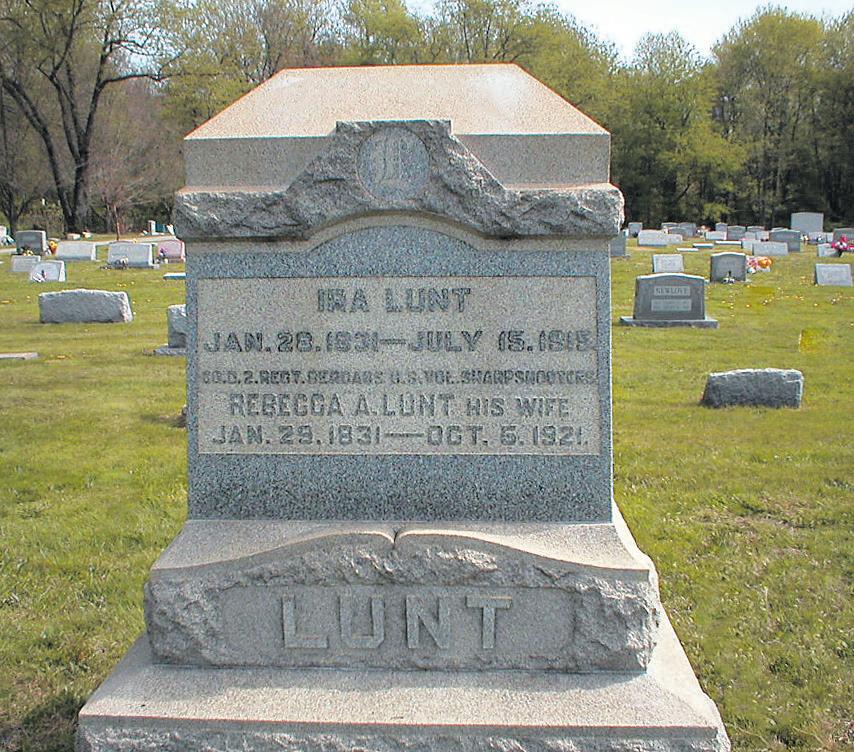
• He was Mustered Out on 6/4/1865 at Washington, D.C.
John is an certified appraiser with International Society of Appraisers specializing in Civil War memorabilia. He authenticates and evaluates other rare and valuable
historic items as well. His website is www.civilwardealer.com. He is coauthor of the book Confederate Bowie Knives (2012) by Jack Melton, Josh Phillips and John Sexton, that was published by Mowbray Publishing, Inc. Send “Ask The Appraiser” questions and photographs to civilwarappraiser@gmail.com.
Original “false muzzle” hand fitted for this rifle. Often false muzzles are missing and rarely associated with military rifles such as this one.
Classic configuration of 19th century target rifle with back-action lock, double set triggers, heavy barrel, and rare long tubular scope. This design was becoming popular just before the Civil War and remained popular among competitive shooters well into the 20th century. Identified Civil War examples are quite rare.

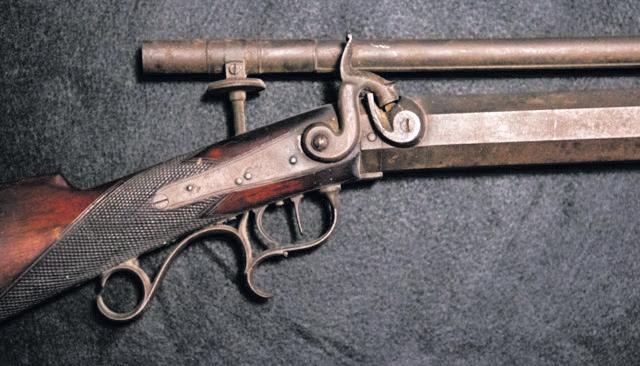
What is the difference between a heavy barreled scope long range target rifle and a sharpshooter rifle?
Answer: “the target.” Very few of this genre of rifle can be positively identified as sharpshooter rifles. This example in exemplary “as found” condition is a Civil War treasure.
This document was preserved with rifle in its original shipping box. Note the chain of command that was required to sign off until finally approved on November 7, 1864:
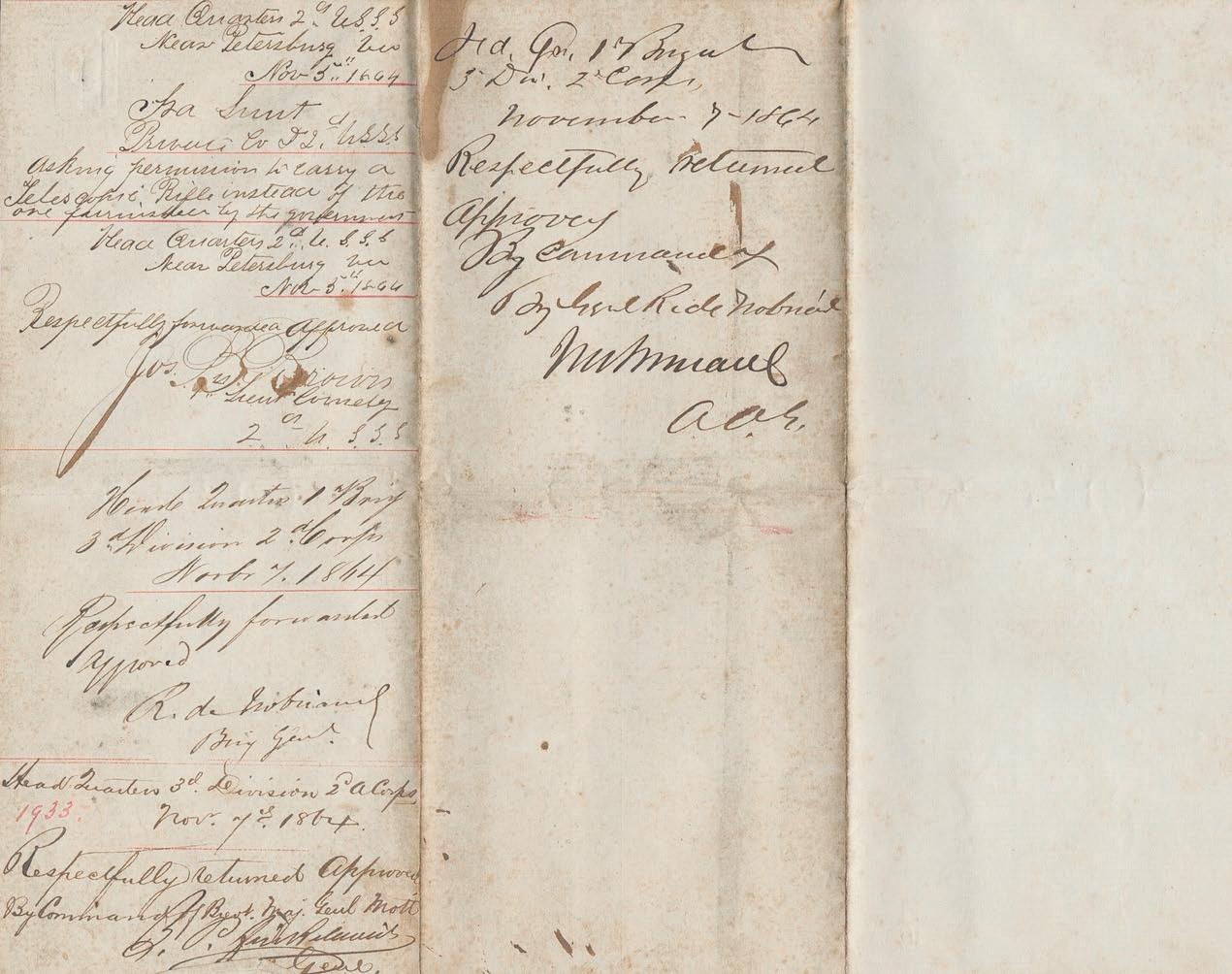
Lt. Edgar Crockett, Acting Adjutant, 2nd US Sharpshooters
Lt. Joseph Brown, Co. D, 2nd USSS
General Regis de Trobriand, 1st brigade, 3rd Division, 2nd Army Corps
Brig. General Gersham Mott, HDQ 3rd Division, 2nd AC
General Regis de Trobriand’s Acting Adjutant General, HDQ, 1st Division, 3rd Brigade, 2nd AC
This comparable rifle sold October 2016 in a Fairfield, Maine, Civil War auction for $18,400. Auction catalog description: Mounted with a Civil War 39 inch brass scope with small field of vision. Brass patchbox has Massachusetts state seal engraved, most likely when sold by Cyrus B. Holden, circa 1861 of Worcester, Mass. James & Ferris were known makers of fine heavy barrel match rifles and Civil War sharpshooters`s rifles with “telescope sights.” This gun is most interesting in that it most likely saw Civil War service in that the percussion nipple has been converted to a musket cone and contemporary replacement plain hammer has been made to strike it properly. There are photographs of soldiers armed with such weapons, including soldiers of the 1st Massachusetts Sharpshooters. There is an example of a very similar weapon on display at Gettysburg National Park Museum. The 1st Massachusetts Sharpshooters are among the few units of the Civil War that utilized heavy barreled guns, such as this one that weighs just over 15lbs. Most interesting is that the Massachusetts state seal is found on this gun, more closely tying this gun to that unit. The First Massachusetts had 39 casualties in the war, serving in almost every major battle of the Army of the Potomac during the war. An identical rifle is held by solider on the 1st Massachusetts Gettysburg monument where the unit was engaged near Devil’s Den. This is a fine example of a rarely offered Civil War sharpshooters rifle. CONDITION: Very good to fine overall. Sound and solid with good surfaces. Rear adjustable scope mount has detached right ear and replaced screw. Scope is missing front lens and cap, though still retaining the “lollipop” style aperture instead of crosshairs. The brass retains a smooth light mustard patina. The scope body also has a smooth copper/chocolate colored patina. The steel is overall gray with good edges and markings; stock is sound and well fit, retaining much of its original thinning varnish. Mechanically, gun functions well including adjustable trigger pull. Bore is clean with crisp rifling.
21 March 2020 Civil War News
Ira Lunt and his wife Rebecca A. Lunt’s headstone.
A Dramatic Leap
The Battle of Glorieta Pass – Part 1
“Boys, I’m the worst enemy you have” – C.S. Gen. Henry Sibley, departing from Ft. Union

After the 1846–1848 MexicanAmerican War, the United States stretched from sea to shining sea. The Confederates considered it only equitable that their new country should do so as well. C.S. Gen. Henry Hopkins Sibley would lead the effort. Sibley had invented the Sibley tent, widely used by both sides and the Sibley stove, to heat tents the Army used through the early years of World War II. Louisiana native Sibley resigned while actively serving in New Mexico. He went to C.S.A. President Jefferson Davis in Richmond, Va., to pitch his idea to capture the New Mexico Territory.
He knew many of the area’s defenders had either resigned to join the Confederacy or were sent to fight in the East. After 14 years of being Americans, the native Hispanic population wasn’t particularly loyal to the Federal government. Sibley would raise troops in Texas, live off the land until he easily captured Federal supplies, seize the rich mines in Colorado Territory, march westward through Salt Lake City, across the mountains, and “On to San Francisco.”
Sibley overlooked that two previous years of drought had dried up year around water holes in the barren landscape. The Federals had consolidated their position at Fort Union and Fort Craig near Santa Fe, N.M., to defend supplies and movement along the transcontinental Santa Fe Trail. The residents primarily wanted a government that protected them from the Indians, conducted business through the border state of Missouri, and hated Texans. Everyone feared the Apaches. The Apaches made their living with raiding parties, viewed the departure of the soldiers as a victory, and created a three-sided
war by attacking everyone.
On Feb. 21, 1862, the Confederates won the Battle of Valverde, but their goal of being resupplied was thwarted by the Federals removing stores on retreat and clearing provisions out of both Albuquerque and Santa Fe, N.M. Additionally, the gold miners from Pikes Peak, Colo. Territory heeded the call for reinforcements. Under U.S. Col. John P. Slough, the Colorado Volunteers marched over 400 miles in 14 days to reach Fort Union.
On March 22, Slough sent U.S. Maj. John Chivington to Santa Fe to capture the approximately 100 rebels reported there. Chivington, an ordained minister from a military family, had a reputation for “cleaning up frontier towns in the name of the Lord. Once in Platte County, Mo., when threatened with tarring and feathering if he continued to preach, he stormed to the pulpit and, laying two pistols beside the open Bible, proclaimed, ‘By the grace of God and these two revolvers I am going to preach here today!’
The “Fighting Parson” turned down a chaplaincy for a fighting command.
The Santa Fe Trail between Fort Union and Santa Fe traveled through 11miles of valleys, canyons, creeks, wooded ridges, and cultivated fields collectively known as La Glorieta Pass, in the Sangre de Cristo Mountains. The Battle of Glorieta Pass was fought on March 26–28, 1862.
During the early hours of March 26, both sides sent men searching through the dark to find their adversary. U.S. Lt. George Nelson and 20 men following the Santa Fe Trail back to their camp came across their opponent’s four mounted pickets. In the early morning light, C.S. Lt. John McIntyre, mistaking the group for their brethren, asked if they were being relieved.
“Yes, we came to relieve you of
men were positioned on the “steep, rocky hillock” on the left flank; the right flank took their places on the canyon’s southern side. According to one Federal, it looked like the “bastion of a fort.”
your arms,” replied Nelson. The Federals “cocked our rifles and drew them to our faces.” Nelson ordered them to surrender and the rebels complied. Back at camp, the waking Federals were surprised to recognize a deserter and a person from Colorado among the captives. More to the point, Chivington learned the whereabouts of his foe.
About 2 p.m. Chivington’s three infantry 1st Colo. companies and one that had been mounted, went with a detachment of the 1st and 3rd Cavalry regiments and reached Apache Canyon. A report that the enemy was spotted a mile ahead spread through troops. The excited recruits rushed forward “dropping knapsacks, canteens, and overcoats,” for their first taste of battle.
Due to the cold, the Confederates had not slept well. Unaware of capture of their pickets, Maj. Charles L. Pyron with his 2nd Texas Mounted Rifles battalion and Maj. John Shropshire’s four companies of the 5th Texas and two 6-pdr. cannon were getting a slow start to the day. Ahead of the main column, 30 men with the 6-pdr. guns just reached the upper portion of Apache Canyon when the Federals were spotted. The cannon were fired, disrupting the Union advance. Chivington ordered his men to take cover amongst the trees on the high ground and to charge the guns if they were limbered. Outnumbered, the guns were limbered for a retreat to Shropshire’s camp in the lower canyon when Pvt. Adolphus Norman noticed a loose gun carriage wheel. Interpreting the repair as the gun taking a firing position, the Federals dove for cover. It gave the Texans time to escape. The bluecoats mounted but no one gave the order to charge. Instead they stood around like “stoughton bottles.”
The artillery flew past as Shropshire’s men rushed forward. About 1 ½ miles from the initial encounter, Pyron conveyed calm as he placed his men and artillery in the road. Shropshire’s
Chivington placed his men on the wooded hillsides. The cavalry was to charge if the opposing line faltered. The horsemen of Company F, 1st Colo. followed the infantry over the Galisteo Creek bridge. The Confederates turned their artillery fire at this “… new threat and the veteran regulars were thrown into confusion by the projectiles screaming over their heads and bursting at their rear.” The regulars regrouped behind some rocks leaving Company F on the bridge. The Confederate artillery advanced but was unable to withstand the fire from the hillside and retreated. Covington expected his cavalry to charge, but when the cavalry didn’t receive the order, both sides regrouped farther down the canyon.
This time Chivington planned a cavalry charge to break the Confederate center while the infantry flanked the line. About 4 p.m., Chivington gave the order for Company F to charge the perceived retreating Confederate artillery. The horseman charged four across down the trail, unable to spread out due to the terrain. The Texans poured lead on the oncoming horseman. Around
the bend they rode to face the Confederate center. The Rebels broke, taking their two cannon with them. The horsemen jumped a little gully or rode through it after the Texans. The fighting continued until nightfall. Some Confederates “…forgot that one of them was equal to five of us and insisted on surrendering.” Both sides pulled back and sent for reinforcements to continue the fight.
Nevertheless, the myth of Company F, galloping in “columns of twos” down the Santa Fe Trail and leaping over a burning eighteen-foot bridge to continue the fight with the Texans is the enduring image of the battle.
Sources:


• Alberts, Don E. The battle of Glorieta: Union victory in the West. Texas A&M University Press, 2000
• Edrington, Thomas S. and Taylor, John. The battle of Glorieta Pass: a Gettysburg in the West, March 26-28, 1862. University of New Mexico Press, 2000
Stephanie Hagiwara is the editor for Civil War in Color.com and Civil War in 3D.com. She also writes a column for History in Full Color. com that covers stories of photographs of historical interest from the 1850’s to the present. Her articles can be found on Facebook, Tumblr and Pinterest.
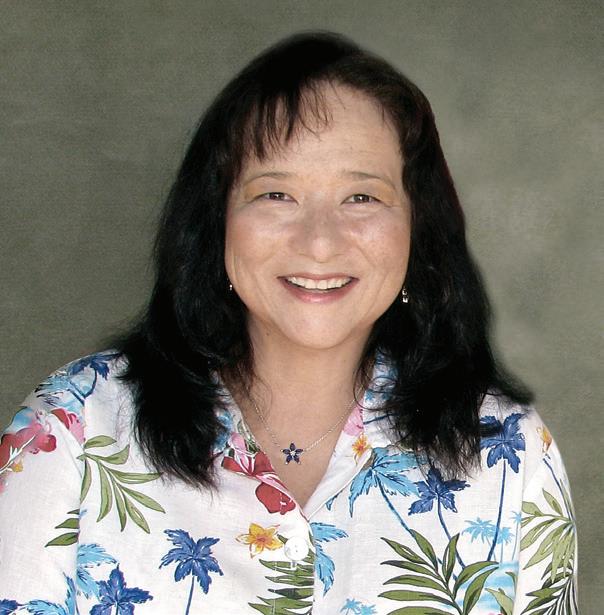
22 Civil War News March 2020
Digital Issues of CWN are available by subscription alone or with print plus archives from 2012 to present at www.CivilWarNews.com
General Henry Hopkins Sibley, Commander, Army of New Mexico, Colorization © 2020 civilwarincolor.com courtesy civilwarincolor.com/cwn. (Library of Congress)
GBPA’s Daniel Lady Farm will Host the 2020 Battle of Gettysburg as Planned
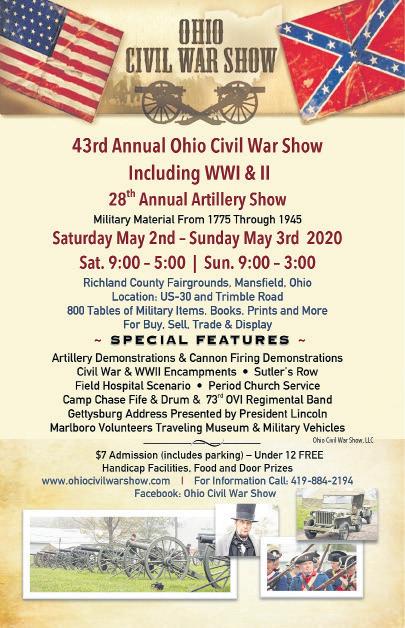
The Gettysburg Battlefield Preservation Association (GBPA. org) reaffirms that they will be hosting and managing the 2020 Battle of Gettysburg reenactment. It will be staged on the hallowed ground of the GBPA’s 146-acre Daniel Lady Farm located on Hanover Road with a large reenactment field bordering Gettysburg National Military Park at Benner Hill. The farm was the site of artillery emplacements and infantry preparations for the Confederate attack on Culp’s Hill. The house and barn became a field hospital. Shell fragments and soldiers’ carved initials remain in the barn and there are blood stained floors in the house.
The 2020 reenactment is being planned as a two-day event over the July 4 and 5 weekend. Celebrate the 157th Anniversary of the Battle of Gettysburg with battle reenactments, artillery and cavalry demonstrations, living history programs, tours of the restored house & barn, and more!
This reenactment of the Battle of Gettysburg under new sponsorship continues Gettysburg’s tradition of annually commemorating the sacrifices of the soldiers and the townspeople in 1863.
The president of the GBPA, Mike Cassidy, said, “Gettysburg’s long history of commemorative events honoring those who fought here, and the civilians that dealt with the aftermath, will continue.”
Quoting Lincoln’s Gettysburg’s Address, “we can never forget what they did here.”

Civil War reenactment units have begun to sign up for the event and the Union command has been confirmed with Confederate command to be announced shortly. Kirk Davis, the GBPA’s Vice President of Operations, will manage the event. He has decades of experience as an event organizer for major reenactments. Many staff who have worked with him at major reenactments over the past 26 years will be helping with the
event along with GBPA staff and volunteers. More details will be released as planning progresses.
The GBPA is a 501c3 nonprofit corporation founded in 1959. Former President Dwight D. Eisenhower was an early member and booster. For 60 years the GBPA has fought to preserve the Gettysburg Battlefield through land purchase, education, and advocacy. Current GBPA programs include owning and operating the historic Daniel Lady Farm, Gettysburg Battlefield Monuments Project, Scout Camping Program on the farm, living history events, site tours, and preservation advocacy. The 2020 Battle of Gettysburg will benefit the GBPA and its preservation and education mission as well as up-keep of the historic Daniel Lady Farm.
MAKE
Detailed information will soon be available on the website at GBPA.org and inquiries may be addressed to info@gbpa.org.

Contacts: Kirk Davis, GBPA Vice President for Operations at 717-357-7609 or Mike Cassidy, GBPA President at 717-368-1235.

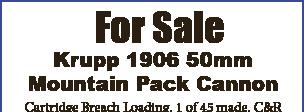
is the 20th of each month.
Nobody even comes close to building a Civil War tent with as much attention to reinforcing the stress areas as Panther. Our extra heavy duty reinforcing is just one of the added features that makes Panther tentage the best you can buy!
PANTHER Catalog - $2 Web: www.pantherprimitives.com
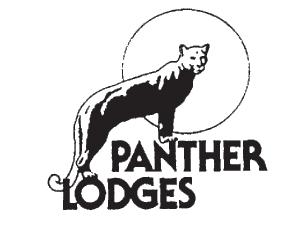
160 pages of the best selection of historical reenactment items from Medieval era to Civil War era. Includes over 60 pages on our famous tents and a 4-color section.



Your $2 cost is refundable with your first order. SEND for

23 March 2020 Civil War News
REINFORCEMENTS
ALL THE DIFFERENCE!!!
copy TODAY The Best Tents in History P.O. Box 32N Normantown WV 25267 (304) 462-7718
Deadlines for Advertising or Editorial Submissions
Email to ads@civilwarnews.com Subscribe online at CivilWarNews.com
Winter Camp: 37th Massachusetts
The Graphic War highlights prints and printmakers from the Civil War discussing their meaning and most importantly, the print maker or artist’s goals.
The 37th Massachusetts Volunteer Infantry had a gallant wartime record. It was recruited by its eventual commander, Major Oliver Edwards. It formed under Lincoln’s call for 300,000 more men in the summer of 1862. The regiment consisted mainly of recruits from the western counties of Massachusetts. Three companies adopted Zouave uniforms calling themselves the “Tremont
Battalion of Zouaves.” The regiment lost 261 men during its three-year service.
It saw action at Fredericksburg, Gettysburg, the Siege of Petersburg, and the Appomattox campaign. In early August 1863, the 37th went to New York City to enforce the new draft law and quell the draft riots that immobilized the city. It re-joined the VI Corps and participated at Rappahannock Station, November 7, 1863.
Following the victory at Rappahannock Station, General Meade was eager to engage Lee’s army at Mine Run. Meade’s
plans were aborted when General Gouvernor Warren informed him that the attack would be devastating to his troops. Reluctantly, he cancelled the attack. Lee had positioned his hardened veterans behind new earthworks making any assault on them suicidal. With that, both commanders decided it was time to go into winter camp. Lee settled his army below the Rapidan River. Six miles below Rappahannock Station, the Union army occupied an area in the vicinity of Brandy Station. The VI Corps, with the 37th Massachusetts settled into the same camp at Brandy
Station it had occupied after Rappahannock Station before the Mine Run Campaign.
Describing the camp, the historian for the 37th Massachusetts wrote: “the location was scarcely an ideal one for a camp, the situation being exposed and wood having to be brought a long distance. But the days wore away with their dull routine, the chills of early winter sharpened the air more and more cold, heavy rains made the day and night alike uncomfortable.”1 Once returned from the cold, miserable Mine Run Campaign, it appeared that winter quarters rumors were becoming a reality; the 37th began preparations to move. “The site for a new camp was selected and the men set to work upon it, patterning it closely after ‘Camp Edwards,’ the famous habitation of the previous winter.”2
As the Army of the Potomac and the Army of Northern Virginia calmly retreated to their winter quarters, the New York Times told its readers that the Federals were “probably in (their) old quarters at Brandy Station, on the line of the Orange and Alexandria Railroad” calling it a “retrograde movement.”
The paper opined that Meade’s strategy was to prevent Lee “from sending reinforcements to
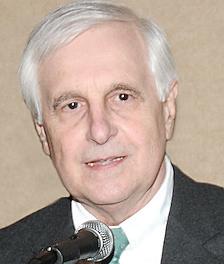
Longstreet in Tennessee.” With a straight face, the paper reported that the movement was a success “and it is now hinted quietly that the army will settle down into winter quarters on the line of the Rappahannock.”3
The title margin of Bufford’s lithograph showing the 37th Massachusetts camp reveals that it was executed by our “special artist.” Signed in the plate is “Baker,” Bufford’s principal and draftsman and illustrator of sheet music, Joseph E. Baker. In 1860, Baker produced a portrait of Lincoln, which “was widely circulated” enabling him to build “a solid reputation as a portraitist.” During the war he drew political cartoons, war scenes, and portraits of military officers. Although his principal work was with Bufford, Baker worked for other Boston firms producing playbills and advertisements. He remained active until 1888.4 Lithographic historian and collector Harry Peters noted that Bufford employed many talented artists giving a mention to “J. E. Baker.” Noted in earlier columns in this space was the information that Winslow Homer was one of John Bufford’s apprentices before he achieved his fame.5 Bufford was responsible for countless views of the Civil War. His body
24 Civil War News March 2020
of work rivaled Currier and Ives and was more artistically appealing. Additionally, he worked with other lithographers such as John Bachelder who also stressed quality and accuracy over Currier’s penchant for immediacy.

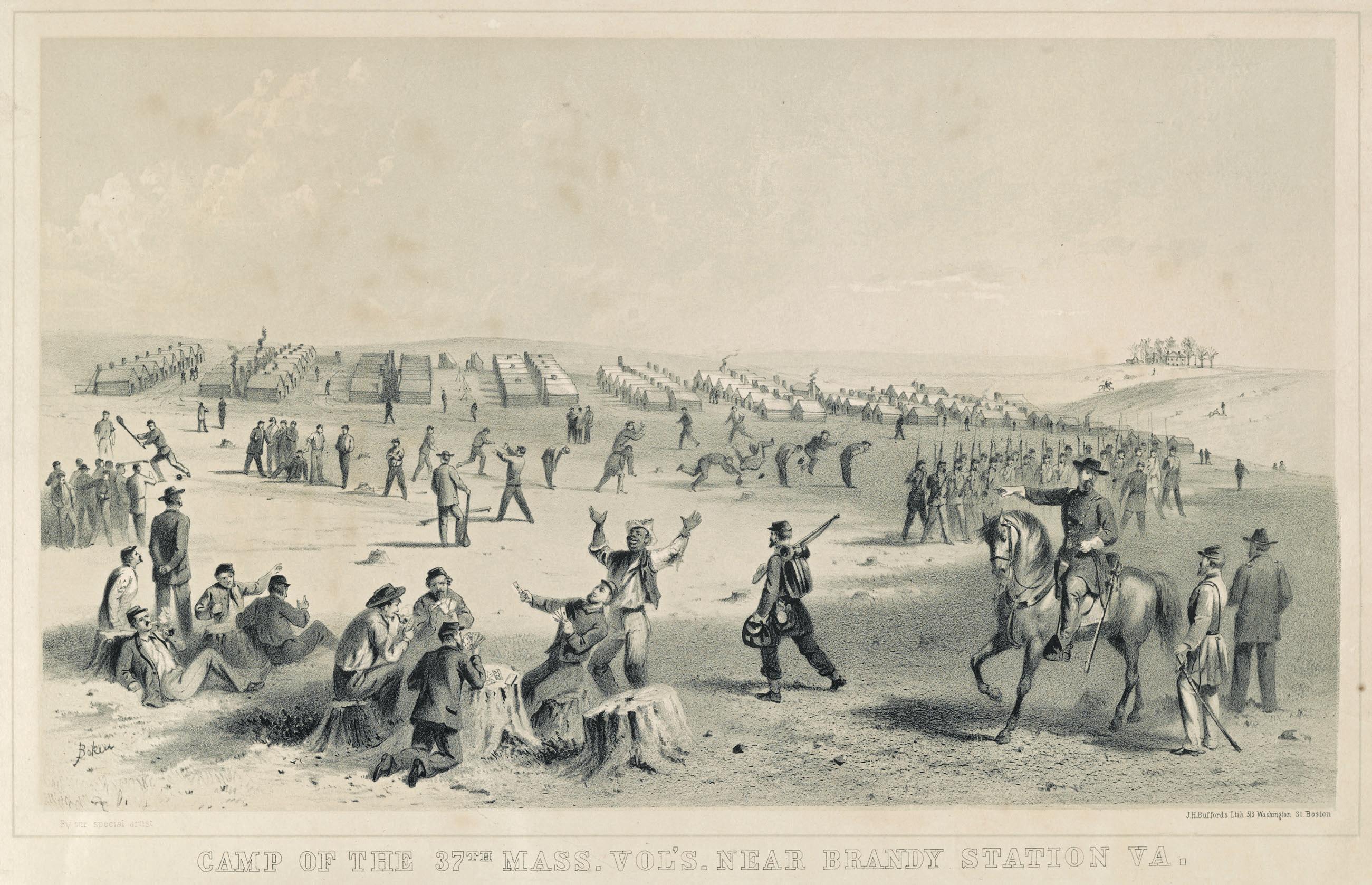
Endnotes:
1. James L. Bowen, History of the Thirty-Seventh Regiment, Mass. Volunteers in the Civil War of 1861–1865 : With a Comprehensive Sketch of the Doings of Massachusetts as a State, and of the Principal Campaigns of the War. Holyoke. C. W. Bryan, & Co., 1884, 235. See also Mason Whiting Tyler, Recollections of the Civil War. Columbus, O.: Badgley Publishing Company, 2011, 84-85.
2. Ibid., 243.
3. The New York Times, December 2, 1863.
4. https://www.artprice.com/ artist/223175/joseph-e-baker/biography. See also David Tatham, American Antiquarian Society, “John Henry Bufford,” 47-73. https://www.americanantiquarian.org/proceedings/44517581.pdf.
5. Harry Peters. America On Stone: The Other Printmakers to the American People. New York: Doubleday & Co., 1931, 118-119.
After 43 years in the museum field, Salvatore Cilella now spends his time collecting American prints and maps and writing. His last professional position was President and CEO of the Atlanta History Center. His most recent books are Upton’s Regulars: A History of the 121st New York Volunteers in the Civil War (U. Press Kansas, 2009). His two-volume Correspondence of Major General Emory Upton, (U. of Tennessee Press, 2017), is the recipient of the 2017–2018 American Civil War Museum’s Founders Award for outstanding editing of primary source materials. He is currently editing a manuscript of Upton’s letters to his wife 1868-70, slated for publication by the Oklahoma University Press early 2020.
25 March 2020 Civil War News
Camp of the 37th Mass. Vol’s. near Brandy Station, Va. / Bakers; J.H. Bufford’s lith., Boston. (Library of Congress)
Tremont Zouaves, (song sheet) also by Bufford. (Public Domain)
Digital Issues of CWN are available by subscription alone or with print plus CWN archives at CivilWarNews.com
Walch Pocket Revolver— The Gun That Almost Put Oliver Winchester Out of the Gun Business!

On February 8, 1859, John Walch of New York City received United States Patent #22,905 for a somewhat unique revolver that fired superimposed loads from its cylinder, thus doubling the number of times the revolver could be fired before reloading. Walch’s patent application, describing his Improvement in Revolving Firearms, read in part:
The nature of my said invention consists in constructing a revolving chamber with two ranges of nipples connecting to the middle and rear part of the breeches, in combination with double hammers so fitted and acting that upon pulling the trigger the
hammers fall, the one before the other, and explode caps on the aforesaid nipples that fire in succession charges contained in the forward and rear parts of each breech, so that two charges are fired out of one breech and the breech revolved each time the two hammers are cocked.
As mid-19th century percussion revolvers were prone to chain fires, the simultaneous detonation of chambers other than the one being fired, it would seem that Walch’s double loaded chambers would raise a few eyebrows and cause concern among potential users. However, Walch explained clearly in his patent application that there was nothing to fear, as his revolvers would also use a new type of projectile. He notes that this new type of bullet was “made either by attaching a tin plate to a half ball by means of a very thin piece, or by connecting
two half-round balls by means of a very small piece, in such a manner as to have a recess all round, This recess is filled with a composition consisting of three-fourths part of soap and one-quarter of oil.”
While the description may not really bring to mind what the inventor intended, the patent drawings that he references can best be described as miniature “bar shot,” essentially a lead ball cut in half and joined by a thin piece between the flat sides that resulted in an incredibly deep groove. This also gave the projectile a more oval than round silhouette. The purpose of this deep groove was to contain the grease-like composition he described, which would ooze out of the groove when the ball was compressed during loading and the space between the two halves suitably squeezed. This grease would then, in the words of the Walch, have the effect that “…every danger is likewise prevented by which the after-charge might be ignited when the forward charge is fired off….”




Walch further notes that this rather slippery arrangement with the heavily greased balls would have the effect that “the chamber will be well greased and the barrel by each discharge will be there by cleaned.” He goes on to further state the advantages of the arrangement being that “as this forms a perfect air-tight packing for the ball the powder will
have more force (and) be able to send the ball a greater distance.”

It is interesting to note that while Walch appears to have, at least in his mind, removed the possibility of the rear charge firing as a result of the front charge being fired, he does not address the possibility that the front charge might misfire, and when the rear charge was fired into the blocked chamber, a catastrophic failure would almost certainly occur.
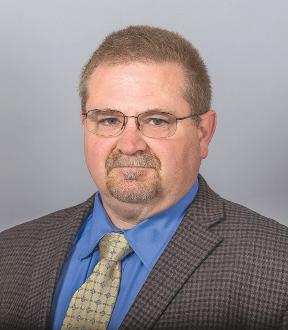
Walch knew that the concept of a superimposed positioning of two or more loads in a single chamber was not a new idea and did not claim that design in his patent. In fact, the U.S. military had experimented with the concept circa 1829 with the EllisJennings repeating rifle, which was produced in both four and ten shot variants. Rather, his claim ran specifically to the arrangement of two rows of nipples on the rear of revolving cylinder that allowed double loads to be fired from each cylinder chamber. His other claim referred to his trigger, which as he noted, “is on its upper end made in two parts.” Thus, a single conventional trigger appeared in the triggerguard that had two operating parts in the frame, which allowed the release of the right hammer and then the left with two distinct pulls.
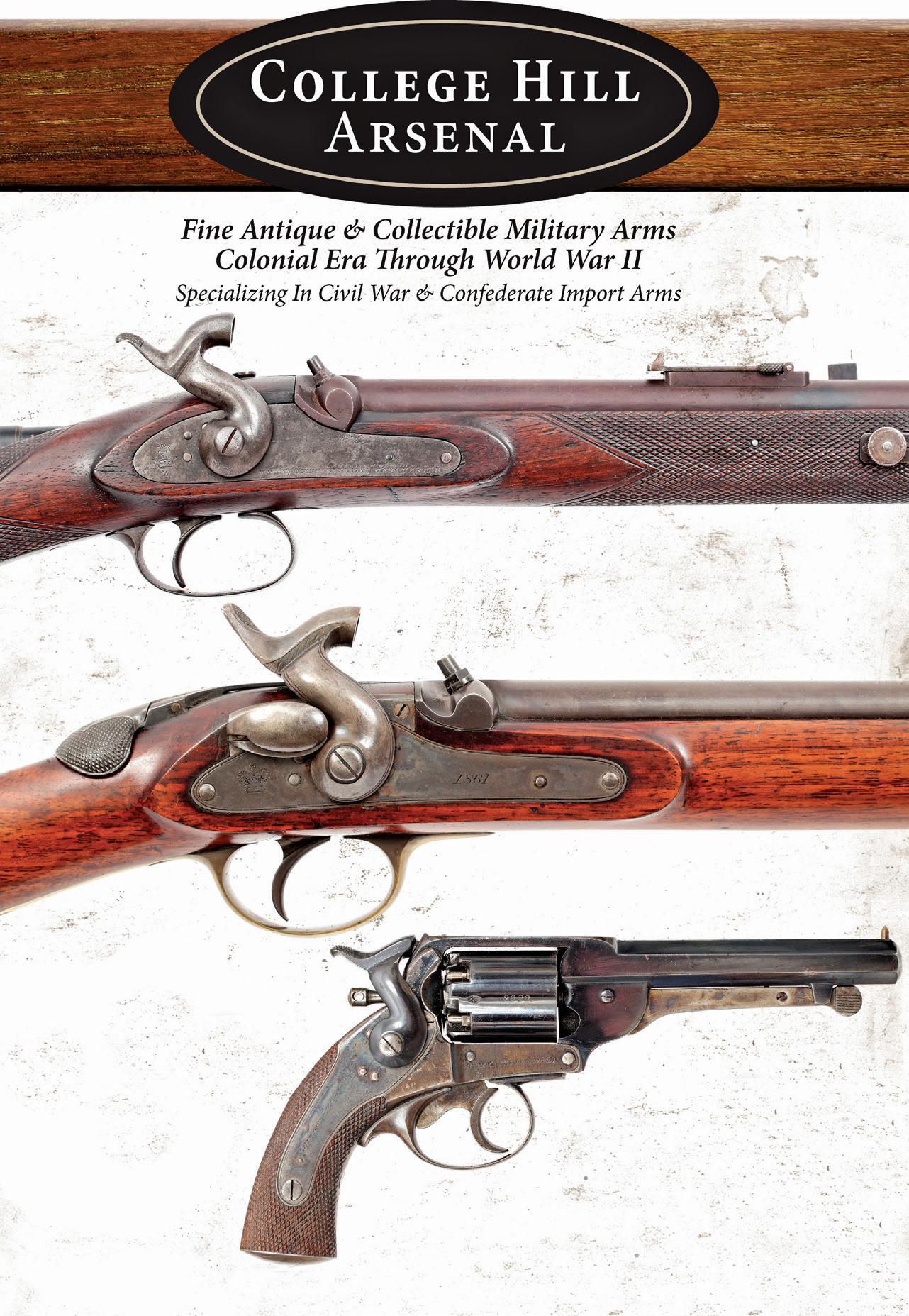
John Parker Lindsay received a similar patent, #30,332 on October 9, 1860, that covered a single trigger mechanism that could release two or more hammers in sequence. This was a more elegant solution to the single trigger and double hammer firing mechanism. The two men would soon design a refined version of the Walch revolver together. The revolver conceived by these two New Yorkers would eventually be brought to Oliver Winchester and the New Haven Arms Company to manufacture. The Walch Pocket Revolver almost prevented the Winchester Firearms Company from existing;
but we are getting slightly ahead of our story.

Like many designers and patent holders during the 19th century, Walch had plenty of ideas but no manufacturing facilities. To that end he entered into an agreement with the Union Knife Company of Naugatuck, Conn., to manufacture his first double-load percussion revolver design, the Walch “Navy” Revolver. This was a .36 caliber, six chambered revolver capable of firing twelve shots out of the double loaded cylinder chambers. The revolver was roughly 12 ¼-inches in overall length with a 6-inch octagonal barrel and utilized two triggers rather than the convoluted single trigger with two upper sections, as shown and described in Walch’s patent application.
The production of the Walch Navy revolver at the Union Knife Company was supervised by John Parker Lindsay, who would become famous (or infamous) for his Lindsay’s Patent U.S. Model 1863 Rifle Musket that used a double loaded chamber incorporated into a U.S. M1863 pattern musket with double hammers and a single trigger. While Flayderman’s Guide To Antique American Arms suggests that Lindsay was already producing his “Young American” pistols based upon the single trigger, double-hammer, double-loaded concept at the Union Knife Company before Walch came to the company, it seems more likely that the former Springfield Armory employee was initially engaged to produce the Walch contract revolvers at the Union Knife Company, more than a year and half prior to starting to produce his own Young American pattern pistols at the same facility. The Walch patent pre-dates Lindsay’s by some nineteen months, so it seems unlikely that Lindsay was already producing his firearms prior to meeting Walch. In fact, the pocket version of the
26 Civil War News March 2020 www.CollegeHillArsenal.com Tim Prince College Hill Arsenal PO Box 178204 Nashville, TN 37217 615-972-2418
The
Overall obverse view of a Walch Patent Pocket Revolver produced by the New Haven Arms Company.
Lindsay Young American pistol bears the February 8, 1859, patent date of Walch’s design along with the October 9, 1860, date of Lindsay’s design under its barrel. The second date appears to refer to both Walch’s bifurcated bullet design and to the elongated flash channels required to fire the front and rear loads, respectively.
Despite a small number of the .36 caliber Walch Navy revolvers being produced at Union Knife Company circa 1860, the guns met with little commercial
success. While exact production figures are unknown, most references suggest less than three hundred Walch Navy revolvers were manufactured. During the same basic period, Lindsay produced a similar number (possibly as many as four or five hundred) of his Young American pocket pistols and approximately one hundred of his larger sized Belt model pistols; both of which also seem to have been commercial failures.
By early 1861, the Union Knife
Company appears to have separated themselves from both Walch and Lindsay and returned their attention to producing the knives that were the heart and soul of their business, rather than speculating in the production of odd ball handguns. Walch was not deterred. A new pocket version of the Walch revolver was designed that appears to have been collaboration between Walch and Lindsay. The new revolver was .31 caliber and initially produced with a brass,
rather than an iron frame. The first 1,500 to 2,000 guns were produced with a brass frame, but the balance of production was made with an iron frame. The open top design used both a wedge and a screw in the bottom of the frame to secure the barrel to the frame. The revolver had a 3 ¼-inch octagonal barrel and a five chambered cylinder that allowed ten rounds to be fired. Like its predecessor, it retained the double hammer arrangement; however, the double triggers and triggerguard were abandoned in favor of a single spur trigger mechanism like the one used on Lindsay’s Young American pocket sized pistols, which was likely Lindsay’s own design. The ten percussion nipples on the rear of the cylinder alternated ignition of the two rounds in the chamber. The first nipple sent its flame into an extended flash channel that traveled along a small hump, much like an inverted cylinder flute, towards the chamber
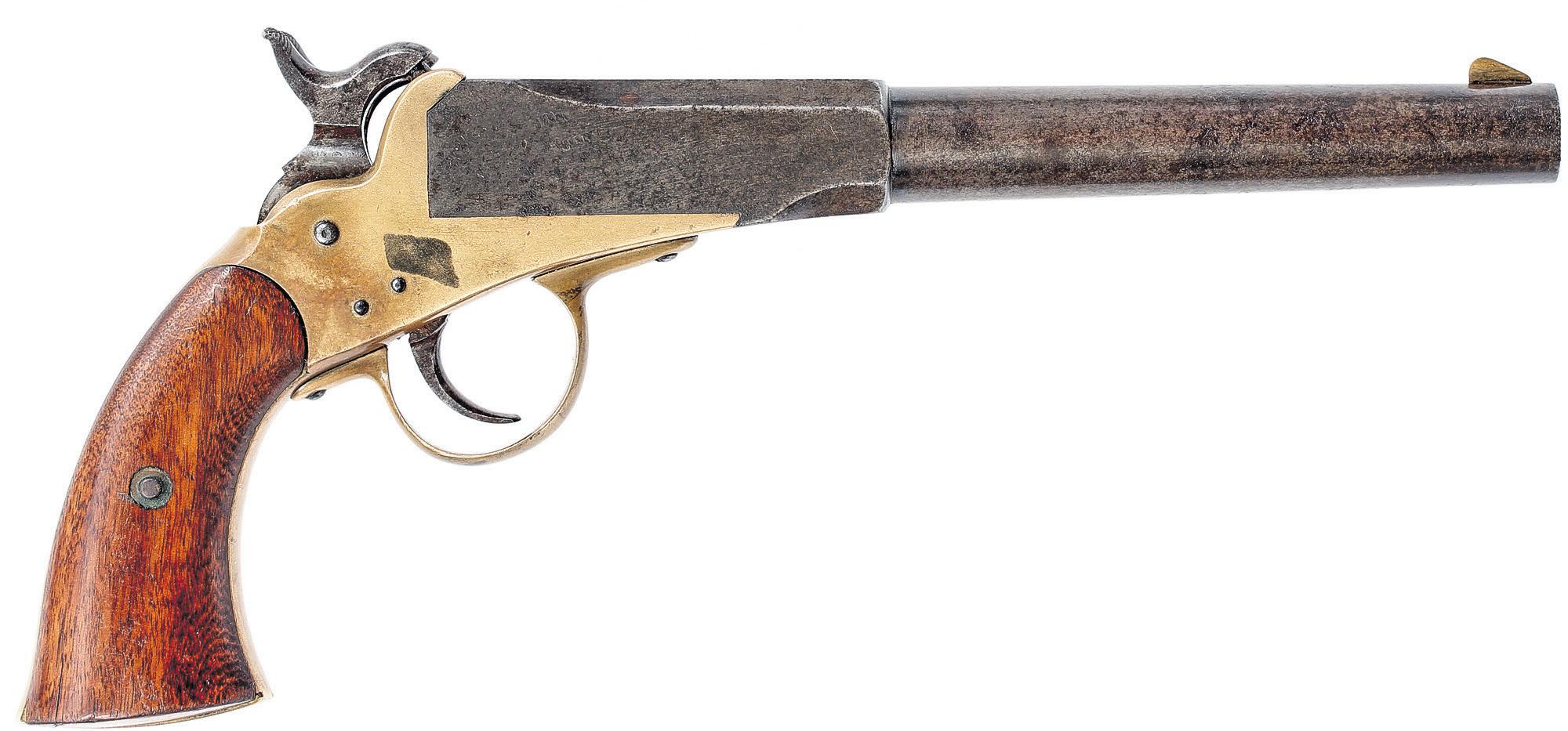

mouth, where it fired the front or first charge. The second nipple fired directly into the rear of the cylinder to detonate the rearmost second charge. As before, Walch had no capability to manufacture the new design, so he approached the New Haven Arms Company of New Haven, Conn., to manufacture the guns.

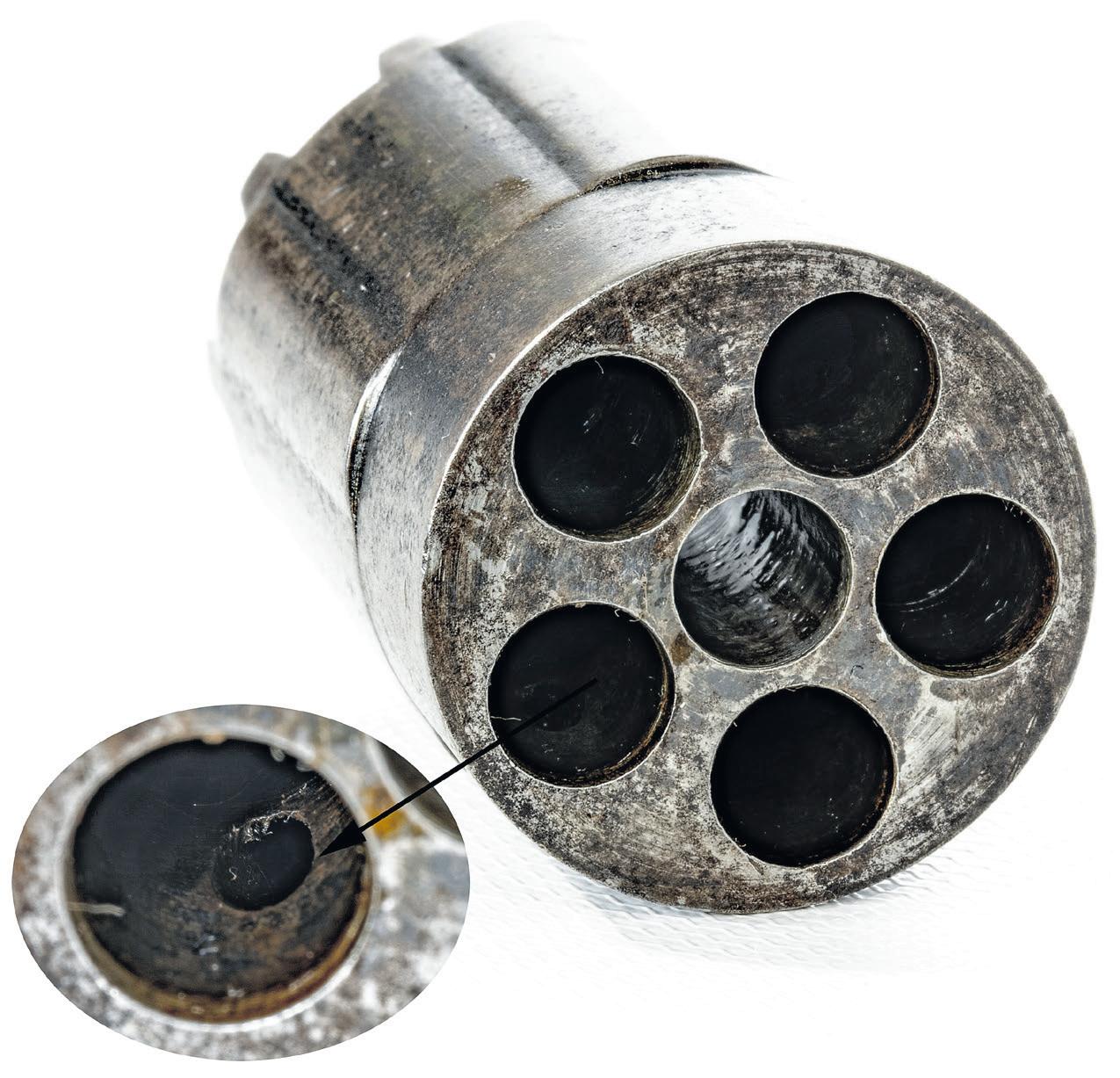

The New Haven Arms Company was in a state of flux at this time, in dire financial straits, and on the verge of financial collapse. The company had been formed in 1857 from the remains of the Volcanic Repeating Arms Company, which itself evolved from the first version of the Smith & Wesson firm. In all cases, the companies were trying to produce and market innovative repeating arms that were inherently hobbled by their low powered “Rocket Ball” cartridge.
The principle investor in the company was Oliver Winchester, a successful entrepreneur whose name was not yet synonymous
27 March 2020 Civil War News
View of the rear of a Walch Pocket cylinder, showing the arrangement of ten percussion nipples around five chambers.
Front view of the Walch Pocket 5-chambered cylinder with the inset showing the forward flash hole about half-way down the length of the chamber.
The barrel address of a Walch Pocket revolver, listing the name of his company and referring to his February 8, 1859, patents, but not mentioning that the New Haven Arms Company was the actual manufacturer. (All photos by Tim Prince)
View of a Walch Pocket revolver after the first hammer has been released to fire the front load in the chamber, with the second hammer remaining cocked to fire the rear load.
A large frame Lindsay “Young American” pistol that uses the same double hammer, single trigger mechanism as the Walch Pocket revolvers. These guns were produced at the Union Knife Company concurrently with the earlier Walch “Navy” revolvers.
with the firearms industry. As Winchester would opine in a letter to another major stockholder of the New Haven Arms Company in October 1862:
“…the company (New Haven Arms) commenced manufacturing the Volcanic firearms, starting a large lot of each size and in about 18 months thereafter began to turn out finished arms, and put them on the market. They at once found a strong prejudice against them among dealers, and [following] a few months vain efforts to sell them, became satisfied that there were radical defects which would prevent their ever becoming a salable article. We, of course, had no way but to finish up those we had commenced, as they would have been a total loss if we dropped them. This involved a large outlay. Most of that stock has been sold at a heavy loss, and nearly all of the costly tools and machinery for making them were rendered useless. While finishing up these arms (taking about two years), we perfected and patented certain improvements (Dec. 1860), obviating the objections to the old arms, and making a perfect thing as applied to the rifle.”
This was the situation that Walch found Winchester in when he approached New Haven Arms. The firm was cash strapped from the failure of the Volcanic
project, was sitting on a large investment in machinery that was now of limited utility, but saw the potential for their newly patented Henry rifle to save the company.

All New Haven Arms needed was an injection of capital to re-tool for producing the new model. As the company had a rocky history with its investors, it was not likely to find new capital from the old sources. As a result, Oliver Winchester agreed to manufacture the new pocket revolver design for Walch. As Winchester continued to explain in the same letter quoted above:
“At this point we were too much exhausted, as we felt, to proceed in getting up the tools and fixtures to manufacture the [Henry] rifle, but let them lay, and took a contract to make 3,000 revolvers for a party in New York [John Walch .31 caliber 10 shot revolvers, patent of Feb. 8, 1859] calculating to clear some $8,000 upon the same (amounting [to sales of] $26,000). But when the pistols were finished, the party failed to respond. We now have them on hand and consequently the capital they cost locked up in a lawsuit.”
As a result of Walch’s default on the contract with New Haven Arms, he had all but pushed the fiscally unstable company over the brink into total financial ruin.
Oliver Winchester’s company now had some additional $18,000 tied up in 3,000 Walch Pocket revolvers; worse than that, he was not able to offer them on the market as the revolvers themselves were tied up in a lawsuit! It would be nearly another year, in July 1863, before Winchester was able to start selling the revolvers. However, as before with the Walch navy, sales were lackluster. New Haven Arms tried to market the revolvers with a suggested retail price of between $15 and $18 each and did manage to get a sales agent to take 125 units in July 1863 at a price of $8.80 each. If the firm could sell the guns for that price, they would gross $26,400; some $400 more than the original business plan. However, the distributor had a hard time finding willing buyers and returned nearly two-thirds of the guns, 80 in all, unsold. How, when, and where New Haven Arms managed to sell their remaining Walch Pocket revolvers inventory remains unclear.
Robert Reilly in his book United States Military Small Arms 1816–1865 notes that some Walch Pocket revolvers were acquired by the 9th Michigan and 14th Wisconsin Volunteer Infantry Regiments, but he asserts that these were certainly personal purchases and not state or Federal government purchases. As handguns were not regularly
issued or carried by infantry, this seems quite logical. However, Flayderman states categorically that “One entire outfit, Company I of the 9th Michigan Infantry armed themselves with the gun, where it received favorable comment.” He continues, “Not all field reports were so laudatory.” As no citation is provided and I have not been able to confirm this purchase in any period document, I am somewhat skeptical that an entire infantry company carried these pocket revolvers, but it is possible. Such purchases were sometimes the type of action undertaken by a wealthy company commander who was willing to help equip his troops from his own pocket.
Thus, the story of one of the more bizarre revolver designs of the mid-19th century comes to a close. Walch’s default on the New Haven Arms contract almost caused that company to fail, and if it had done so, the Winchester Repeating Arms Company may have never been born. This strange story makes the Walch not only an important piece of Civil War era firearms
curiosa from a design standpoint but means that these revolvers belong in a collection and display of early “Winchester” arms, along with the Volcanic and Henry firearms produced by the New Haven Arms Company.
Tim Prince is a full-time dealer in fine & collectible military arms from the Colonial Period through WWII. He operates College Hill Arsenal, a web-based antique arms retail site. A long time collector & researcher, Tim has been a contributing author to two major book projects about Civil War era arms including The English Connection and a new book on southern retailer marked and Confederate used shotguns. Tim is also a featured Arms & Militaria appraiser on the PBS Series Antiques Roadshow.
Civil War Catalog

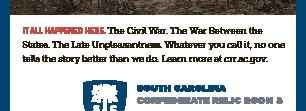
Featuring a large assortment of Civil War and Indian War autographs, accoutrements, memorabilia, medals, insignia, buttons, GAR, documents, photos, & books. Please visit our fully illustrated online catalog at www.mikebrackin.com

28 Civil War News March 2020 Subscribe at CivilWarNews.com
Free copy mail catalog Mike Brackin PO Box 652, Winterville, NC 28590 • 252-565-8810
“I have it Verry [sic] Nice Here”
by Bruce Allardice and Wayne Wolf
John
Seth Smith (1829–1922)
joined Company B, 5th New York Cavalry in August 1862. Promoted to corporal, he was discharged April 25, 1864, due to a gunshot wound to the elbow suffered at the battle of Hagerstown, July 6, 1863. A prewar wagon maker in Steuben County, New York, he wrote numerous wartime letters to his wife Martha (Brown) (d. 1886). When he died a local newspaper claimed he was “the oldest veteran of the Civil War” in the county.
In the first of these letters Seth Smith is clerking for the regimental sutler (the Colonel’s brother). The money a sutler can make ($200-300 per month) so dwarfs the pay of an army private ($13 per month) that he hopes to get a discharge and become a sutler on his own account. He complains of drunken officers costing the army many battles. The second letter has him in a Frederick, Md., hospital, attempting to get his discharge from the army. He is still suffering from his Hagerstown wound.
The “Col.” mentioned in the letters is Othniel De Forest (1826–64). In late 1863 Col. De Forest was court martialed for defrauding the government. He allegedly conspired with his brother Benjamin (1821–74) to purchase horses, then sell them to the regiment at inflated prices. He also was charged with selling the regimental sutlership, and earning $50,000 from the sutler’s profits. The colonel was dismissed from the service.1
wished me to come in and work for them. The sutler is the Cols. brother and the Colonel had me detailed the same day I wrote my last letter to you and I have been in to it since. He gives me one dollar per day extra of my government pay and I shall stay as long as DeForest is the man that I am clerking for. He is going to get me mustered out of the service if he can so I can stay with him. If I can get out of the service now I understand the ropes so I can make from $200 to $300 per month in the sutler business. The man that I am working for comes out every other day with goods. He comes on the cars from Alexandria, gets here at 9 o’clock, returns again at half past one and I stay here alone and sell out the goods and sometimes when he comes back I have $200, sometimes more. He has got a great confidence in me and I would not do anything to change his mind. It may turn out to my benefit as to our officers. There is too much drinking for the credit of the army and a great manny [sic] of our defeats are caused by whisky not by the
and I am sure you would not do ennything [sic] out of the way or ennything [sic] that I would not have you see me do. Sometimes when I am much exposed to cold and that I take about one gill of liquor if I can get it when it is bought by the soldiers it comes very high, one dollar and a half and I have never bought one gill nor one drop of liquor since I came to Virginia and it cost so much, men here does not give it away when they buy it and I think my present place is sufficient proof of my good behavior so put yourself at ease. I shall come home as good morals as I left. I think I got a letter from Nelt with yours. If I am mustered out I shall go home a short time then come back to the sutler business. It pays about three hundred percent.
Kiss little Charley for me. Tell him I sleep with him and Ma every night. Give my love to all. No more at present. Write often as you can for it seems lonely to me if I do not hear from you often. So no more at present.
Seth
U.S. General Hospital
Frederick City
Feb. 24, 1864

My Dear Wife, I received your letter last evening after I had got undressed for bed. I was glad to hear from you. I do wish you could get something that would stop those bad spells in your stomach. I am glad Ma is getting better. Tell her I should like to see her. O how much I think of home and how I long for the time to come home and be with you again but I shall get my discharge by and by. I am back in the hospital as a patient again, I am well and hearty. My arm is not getting enny [sic] better nor will it till I get my discharge. I am playing my card and it is going as well as I can expect. I haf [sic] to work slow and cautious and I think it will come all right in the end.
stands I have to be careful and not overdo the thing in neither case. I have it verry [sic] nice here, good bed enough to eat and no work to do.
They had a great time here the 22nd, Washington’s Birthday, gates open so all could go down town and had a grand march through the streets of the city. At evening had a Ethiopian3 entertainment in Barrack E. This barrack is fitted up on purpose and every few days they have one of those entertainments for the benefits of the Hospital. The performers are all patients here. I am in hopes that I shall get my pay as soon as the 10th of next month and then I won’t let it get cold in my pocket. I will express it to you immediately. I do not think of anything more at present. Give my love to Pa and Ma and to all of the rest. Tell them I shall be very glad to see them. Direct to Barrack N as at first write as
soon as you can. It seems so long between your letters. Sometimes I get uneasy. So good day & write soon.
Yours affectionately, Seth
Endnotes:
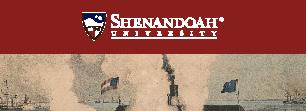
1. For more on the 5th New York Cavalry, see Vincent L. Burns, The Fifth New York Cavalry in the Civil War (Jefferson, NC, McFarland, 2014).

2. Evidently their son, who died young.
3. Blackface minstrel.
Bruce S. Allardice is Professor of History at South Suburban College in Illinois. He is a past president of the Civil War Round Table of Chicago.
Wayne L. Wolf is past president of the Lincoln-Davis Civil War Roundtable.

Civil War Artillery Book
New 392 page, full-color book, Civil War Artillery Projectiles –The Half Shell Book.

For more information and how to order visit the website www. ArtillerymanMagazine.com or call 800-777-1862.

$89.95 + $8 media mail for the standard edition.
Camp near Bristoe Station May 29, 1863
My Dear Wife, I have just received your letter. Was glad to hear from you and to hear that you are well, you and Charley2 and all the rest. I am well and enjoying good health. I am now in the sutler’s store. They
Rebs alone but by whisky and the Rebs together.
You are so afraid I will fall in to those bad practices of officers and soldiers. I tell you the truth manny [sic] times I am disgusted with them and to that extent that I am not much likely to fall into them. In you I have got the greatest confidence in you in the world
I have had a talk with the lieut. Commanding co. Invalid Corps to which I have been transferred. He has told me as soon as he gets his business so he can attend to it he is going to send me home and that is what will please me and as you will see by the corse [sic] I have taken I have 2 strings to my bow. One is to get my discharge by way of the Lieutenant and if that should by accident fail as I am a patient in the hospital from the Invalid Corps not fit for duty and not likely to be I shall get my discharge and as the matter
29 March 2020 Civil War News Subscribe online at CivilWarNews.com
Col. Othniel De Forest (1826–64). (Wikimedia commons)
To: Martha W. Smith / Painted Post / Steuben Co., New York
Soldiering On
On occasion the postman has brought me interesting things sent by my cousin Billy. Once the mailbox contained a book telling the story of a collateral ancestor of ours. Benjamin Church was a prominent citizen of Boston at the time of the Revolution. He served on the Committee of Safety with some men wellknown to American history and admired by us all. Uncle Ben, however, was a mole, a spy for General Gage. He was not tried (the reasons are complex) but exiled. The ship carrying him to the Caribbean was lost at sea.
Another of Billy’s uncles (just his, this time, not mine)
participated in another revolution: Ferdinand Burdell served in the Confederate army. After the war Ferdinand composed a brief account of his military service, a three-page, handwritten document, a copy of which Billy mailed to me. Ferdinand enlisted as a private, fought at Sharpsburg, then later joined the engineers. As Sherman was approaching Savannah in late 1864, Ferdinand was in charge of a crew building a lunette for mounting an artillery piece. The work was not finished and the gun was never mounted. “About daybreak of Dec. 21 1864 a Cavalryman came riding up to the work at a frantic rate,”
Ferdinand wrote, “& informed me that Hardee’s army had abandoned the City that night, & I must rush my Party to the Pontoon Bridge….”
A close call for Ferdinand and his men, but they did get out of Savannah before Sherman got in.
On the last page of the account this sentence caught my attention: “My party was placed under the direction of James M. Couper – Lieut. Engineers & sent to Abbeville SC to establish a line for a Military Rail Road from that point to Washington Ga.” This was sometime after January 8, 1865.
That’s right. In January 1865
there was a plan—or at least a hope—for a 50-mile railroad between these two towns. Ferdinand wrote that “the work was very soon abandoned.” He went on to other engineering tasks in the Carolinas.
But let’s get back to that railroad. I perused the correspondence between General P.G.T. Beauregard and other officers in early 1865, when Beauregard was commanding the Military Division of the West. The records do confirm the existence of such a plan or hope. What were these officers thinking? An assessment of the military situation, an examination of the map, and orders related to the movement of men and supplies may tell us.
Sherman was finishing his R&R in Savannah. His next specific objective, Charleston, or Augusta, or Columbia, was, of course, unknown to the Confederates; however, whatever his exact route, he would disrupt communications between the Western Theater and the east. Uncle Ferdinand’s hoped-for railroad was part of an effort to get men and supplies around Sherman’s path of destruction, to get aid to Lee, and to put an army between Sherman and Grant. The records provide insights about the Confederates’ struggle to carry on the fight.

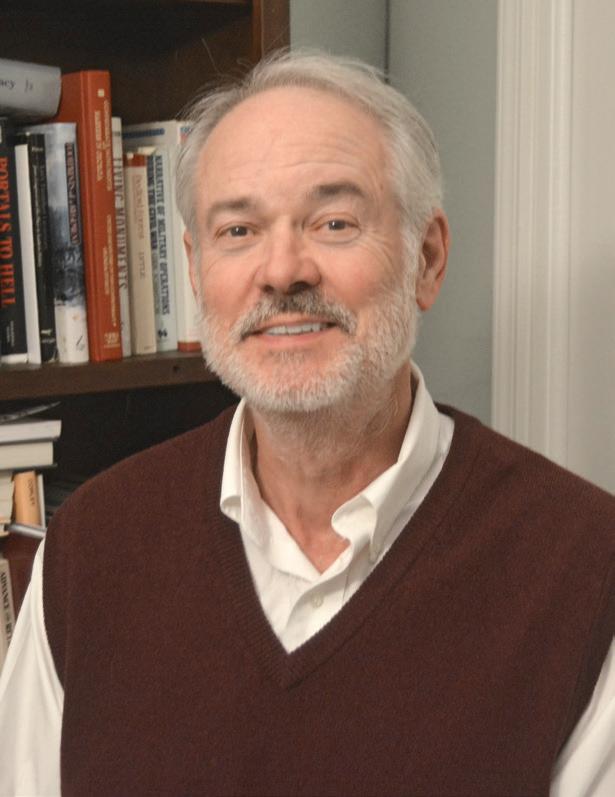
Fixing existing rail lines was essential. The Official Records contain orders and other communications pertaining to repairs necessitated by enemy destruction and by the extra-ordinary wear and tear to which the rails had been subjected during 45 months of war. The railroad from West Point, Ga., to Atlanta was one critical line. Another was the Georgia Railroad between Atlanta and Augusta, 150 miles to the east. Orders were made to repair the branch line running north from the Georgia Railroad to Washington, Ga. In February Beauregard warned that rolling stock on the line north of Columbia would have to be destroyed unless the gauge of the Charlotte-to-Danville line was widened.
The Confederacy was near the end of its tether. Where would it find the resources necessary to make these repairs? Iron could be impressed from some rail lines for the repair of others, but we know what happens when we rob Peter to pay Paul. Someone suggested pulling up iron from two branch lines in Georgia to use on the main lines. Beauregard objected. “It is impracticable at present to order the removal of the iron from the Mayfield and Washington Branch Roads. They
30 Civil War News March 2020
https://www.loc.gov/resource/g3861p.rr001410/ ?r=0.015,0.101,0.812,0.282,0
This map shows Confederate rail lines and other routes. It can be found at the Library of Congress website
. Users can zoom in and see the whole map in great detail. If one locates the towns named in the various communications one can see that the Confederates were attempting to establish communications with Virginia and North Carolina via the Piedmont region, which was relatively untouched by the war and out of Sherman’s path. (Alston and Huntsville are not shown on the map. Alston is near Prosperity between Newberry and Winnsboro; Huntsville, now defunct, was a short distance southeast of Laurensville.)
have become lines of communication of the first importance. Washington and Abbeville may become our future base of supply for the army in Virginia,” wrote Col. George Brent on February 6, speaking for his boss in a telegram to the Confederate army’s chief engineer.
The Washington-to-Abbeville line wasn’t the only new project suggested. On January 28, Beauregard sent a message to Adj. Gen. Samuel Cooper saying that it was “essential to military operations that the railroad from Milledgeville to Mayfield be speedily finished.” This line would connect the central part of the state to the Georgia Railroad. Cooper quickly squelched this notion, telling Beauregard to focus instead on the repairs to the West Point Railroad. In March Beauregard ordered the impressment of labor for widening the gauge of a North Carolina track.
A heavy hand was needed to garner the resources for these projects. On January 24 Beauregard authorized Capt. L.P. Grant to “impress for temporary use the necessary transportation to repair Georgia Railroad.”
On February 10 Beauregard authorized a Mr. W.M. Hight “to call upon the citizens adjacent to the Washington Branch, Georgia Railroad, for such lumber, wagons, and labor as they are willing to contribute for the repairs of the road, and for all of which the Government will pay a just compensation.” The message to Hight went on to state that “Capt. L.P. Grant…has been requested to furnish you iron, spikes, &tc., sufficient to place the road…in thorough repair.”
Railroad or no railroad, the men and supplies had to be transported. A message from Beauregard to Maj. Norman Smith on February 4 ordered a heavy-handed approach tempered with tact. The major was instructed to impress
“wagons and teams to run between Washington, Ga., and Abbeville, S.C….” The order called for 120 wagons and 480 mules and specified the numbers to be obtained from each of five counties along the line. Such action, the order read, “is at all times harsh and calculated to irritate and annoy….” Smith was therefore told to “select for this duty your best officers and instruct them to proceed with all possible delicacy….” The effectiveness of delicacy under the circumstances is not known, but we can guess. The citizens were to be paid with Confederate IOUs.
Let’s not forget, there is a river between Washington and Abbeville. On February 20 Beauregard ordered construction of a pontoon bridge over the Savannah. The pontoon train was en route, but flooring and sleepers would have to be made from material available at the crossing creating more annoyance and irritation, perhaps, for the locals.
On February 17 Beauregard was in Columbia, but leaving that very morning as Sherman approached. He sent a message to his assistant adjutant general in Augusta, advising that forces being gathered to stymie Sherman’s progress would concentrate in Chesterville [now Chester], a stop on the railroad between the South Carolina capital and Charlotte. Beauregard specified three possible routes* to Chesterville. Moving from the first option to the third, the proposed routes bypass Columbia by wider and wider margins, to the north and west, a path shifting as necessary to get around Sherman and unite with a force in his path.
So, as the war entered its final weeks, the Confederates were seeking ways to get supplies to Lee and concentrate against Sherman. We read orders about building one new railroad and repairing existing ones. Pontoon
GEORGIA’S CONFEDERATE MONUMENTS
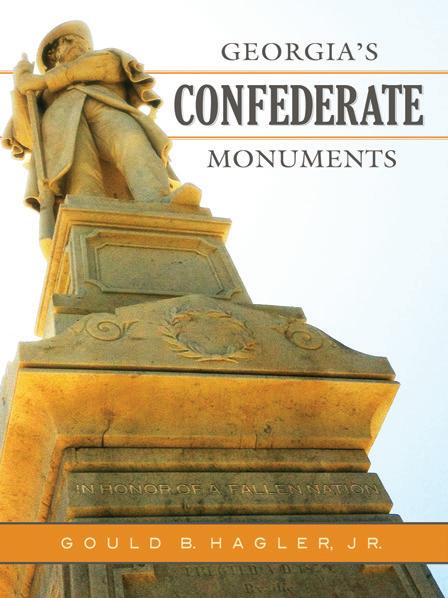 Gould B. Hagler, Jr.
Gould B. Hagler, Jr.
This unique work contains a complete photographic record of Georgia’s memorials to the Confederacy, a full transcription of the words engraved upon them, and carefully-researched information about the monuments and the organizations which built them. These works of art and their eloquent inscriptions express a nation’s profound grief, praise the soldiers’ bravery and patriotism, and pay homage to the cause for which they fought.
www.mupress.org
866-895-1472 toll-free
bridges were built. Lines of march were specified. Rations were ordered for points along the routes.
The books narrating the events of April and May had not yet been written. The men issuing these orders did not know what we know, but they surely understood their situation to be dire. What were they thinking? They must have been thinking that they were duty-bound to soldier on. The government in Richmond continued to function and was giving direction to the military leaders. Telegraph lines and couriers conveyed orders. Men were under arms, men who would follow orders and be led. Railroad trains were yet limping along the worn and shaky tracks to move men and supplies. There were still resources that could be marshalled, furnished by citizens with wagons and mules, citizens irritated and annoyed, but compliant with orders of impressment. The commanders still had hope, they carried on. Beauregard sometimes displayed an attitude that went beyond hope and entered the realm of fantasy. On February 3 he asked for re-enforcements from Virginia, with which he “would defeat, if not destroy Sherman’s army.” Later that month he wrote about crushing Sherman, concentrating against Grant, and then marching to Washington “to dictate a peace.”
That was Bory. Others were more realistic and, for that matter, not all the men were soldiering on. On February 4 an officer in Augusta, ordered to take his command of guards to the Savannah River crossing upstream, was told not only to protect the pontoon bridge but also to “arrest stragglers and deserters from the armies in South Carolina and Virginia.”
When the plan for the Abbeville-to-Washington railroad was dropped, Ferdinand Burdell soldiered on to Newberry, S.C., where the engineers threw a pontoon bridge across the Broad River, used by troops on their way to North Carolina and the battle at Bentonville. After this work, he rushed to Hillsboro, N.C., to survey roads leading to Virginia, “the Evident object being to make a clear way for Lee & [Johnston’s] army to connect.”
When he wrote his post-war account Ferdinand knew what we know now. By early 1865, he wrote, “we were about crushed out by the strength of overwhelming numbers and resources of war.”
In April he encountered some of Lee’s paroled men as they returned home. “They told us that
General P.G.T. Beauregard. (Library of Congress)
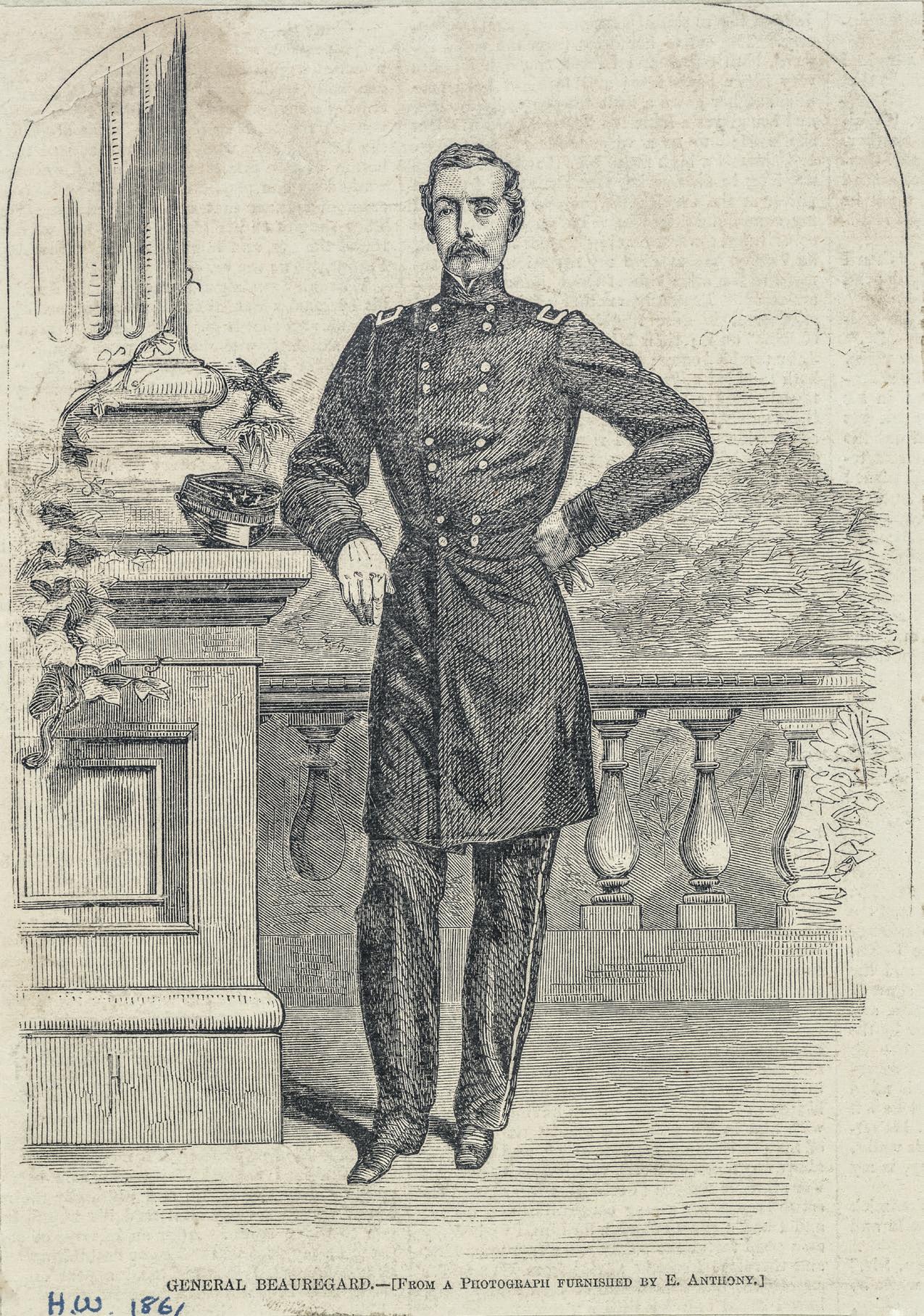
‘the war was over & to make for home’ – which we were not slow in doing.”
Ferdinand returned home to Augusta, where he and the others of his party surrendered and were paroled. “Thus Ended my bitter experience of 4 long weary years,” he wrote, “wrecked on the Shores of Defeat.”
*Route 1: Augusta, Edgefield, Newberry, and Chesterville. Route 2: Augusta, Edgefield, Ninety-six Depot, Huntsville, Unionville, and Chesterville. Route 3: Washington, Abbeville, Laurensville, Unionville, and Chesterville. (See map for the significance of this detail.)
Sources: All the correspondence referenced is found in the Official Records, Ser. 1, Vol. 47, Pt. 2, Sec. 2.
Gould Hagler is a retired lobbyist living in Dunwoody, Ga. He is a past president of the Atlanta Civil War Round Table and the author of Georgia’s Confederate Monuments: In Honor of a Fallen Nation, published by Mercer University Press in 2014. Hagler speaks frequently on this topic and others related to different aspects of the Civil War and has been a regular contributor to CWN since 2016. He can be reached at gould.hagler@gmail.com.
31 March 2020 Civil War News
In Honor of a Fallen Nation
Subscribe online at CivilWarNews.com
Publishers/Authors Updated Information Send your book(s) for review to: Civil War News 520 Folly Road, Suite 25 PMB 379 Charleston, SC 29412 bookreviews@civilwarnews.com
From the Editor
The February 2020 issue of Civil War News featured a frontpage story that listed Civil War books published in 2019. Onehundred and sixty one books made the list, although the paper suggested its list was probably incomplete. “If someone has a closer estimate or known quantity, let us know,” the paper apologized. Still, 161 is no small stack of books. I wanted to take a second and, as the saying goes, “run the numbers.” The article listed works by 39 publishers (plus a few self-published authors). Among the academic publishers, Louisiana State University Press led the way with 14 titles, followed by the University of North Carolina Press with 13. Our partners at Southern Illinois University Press also had 13 titles,
including one in the Engaging the Civil War Series that SIUP publishes with ECW. We highlighted that book, The Spirits of Bad Men Made Perfect: The Life and Diary of Confederate Artillerist William Ellis Jones by Constance Hall Jones, in our December 2019 ECW newsletter.
Leading the charge among publishers overall was Savas Beatie, with 17 titles on the list, including five titles in the Emerging Civil War Series, plus a great hardcover by ECW contributor Dave Powell that’s not part of the series, Union Command Failure in the Shenandoah. Of ECW authors, Dave had two books out during 2019, as did our colleague Steve Davis.
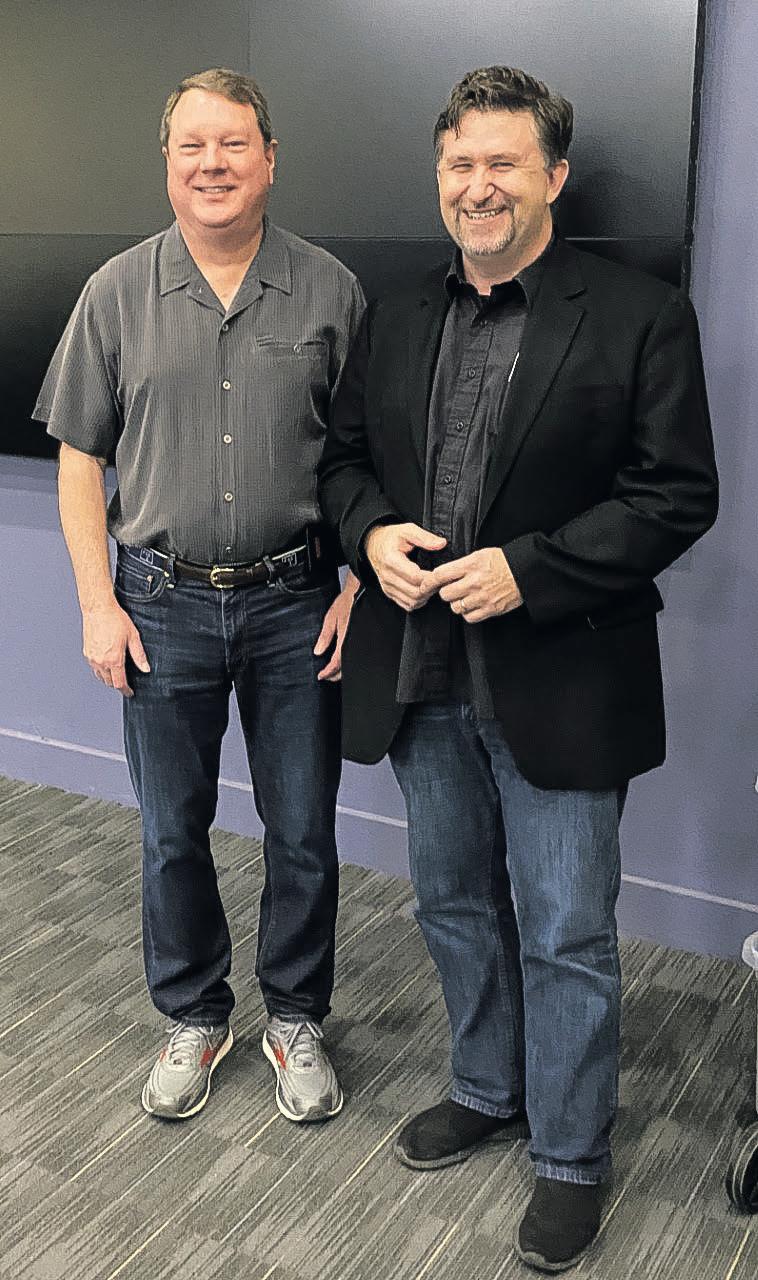
The very first name on the entire list, which was organized alphabetically by publisher, was ECW’s own Kevin Pawlak and his book Antietam National Battlefield. All told, ECW authors published 10 books during the year, and we can’t forget about Edward Alexander’s map.
Books are a huge part of the Civil War world culture, and they’re certainly a huge part of the culture here at Emerging Civil War. Twenty-six of our regular contributors have published books in the course of their careers, including seven contributors who published their first books because of their affiliation with us; two more first-timers are about to see print this spring.
I think of this robust list in the context of discussions earlier this year that ruffled the Civil War community in the wake of a controversial May 2019 Wall Street Journal article: Does the Civil War still matter? We explored that question in a series on the blog in conjunction with Civil War Times: https://emergingcivilwar. com/tag/do-we-still-care-series/.)
The relationship between that question and Civil War publishing is a rabbit hole too deep for us to get into in this limited amount of space, but remember, we as readers have a role to play in that dynamic, too. I often hear people lament, “If I bring one more book into the house, my wife will kill me....” However, if we stop bringing books into our houses, publishers will stop publishing and then maybe we will be asking ourselves, “Does the Civil
War still matter?” with a bit more urgency.
If nothing else, Civil War News list shows us that we live amidst an abundance of readable riches.
Chris Mackowski, Ph.D. Editor-in-Chief, Emerging Civil War

The Seventh Annual Emerging Civil War Symposium at Stevenson Ridge

Have you been following our Symposium Spotlight on the blog? We’re profiling the presenters who’ll be on the docket for our Seventh Annual Emerging Civil War Symposium at Stevenson Ridge, Aug. 7-9, 2020. Tickets are $175 each. This year’s theme is “Fallen Leaders.” You can find out more details on our symposium page: https://emergingcivilwar.com/2020-symposium/.
Emerging
Civil War News & Notes
Looking back at 2019, Edward Alexander realized he made maps for 11 upcoming publications. You can see some of Edward’s maps at his website, Make Me a Map, LLC (https://makemeamapllc.com/).
Steward Henderson will be busy in February. On Feb. 22, 2020, from 1 to 5 p.m., he will present a program titled “From Enslaved to Soldier” in Fredericksburg, Va. This is an African-American history tour of the Fredericksburg area that Steward created for Fredericksburg Tours (https:// www.fxbgtours.com/). The tour discusses slavery in the area, the escape of 10,000 enslaved during the first Union occupation, and the presence of a USCT division, featuring the 23rd USCT that comes back to fight in the Overland Campaign. Cost $45/ person for the tour and bus ride. Steward will deliver the tour, mostly on the bus, but there will be some walking.
Chris Kolakowski and his wife Alice relocated to Madison, Wisc., just before Christmas, and on Jan. 6, 2020, Chris became the new director of the Wisconsin Veterans Museum (www.wisvetsmuseum.com). An educational activity of the Wisconsin Department of Veterans Affairs, the museum tells the story of Wisconsin veterans of all branches from the Civil War to the present. It is the custodian of many Civil War-related artifacts, including the battle flags of Wisconsin units.
ECW Bookshelf
We’re especially excited about
the release of our newest book from Southern Illinois University Press as part of our Engaging the Civil War Series: Entertaining History: The Civil War in Literature, Film, and Song. Twenty-one historians and writers contributed twenty-seven essays to this collection, edited by Chris Mackowski. According to SIUP’s website: “Popular media can spark the national consciousness in a way that captures people’s attention, interests them in history, and inspires them to visit battlefields, museums, and historic sites. This lively collection of essays and feature stories celebrates the novels, popular histories, magazines, movies, television shows, photography, and songs that have enticed Americans to learn more about our most dramatic historical era.” We’re supplementing content in the book with a slew of online content, as well, so there’s plenty to explore.
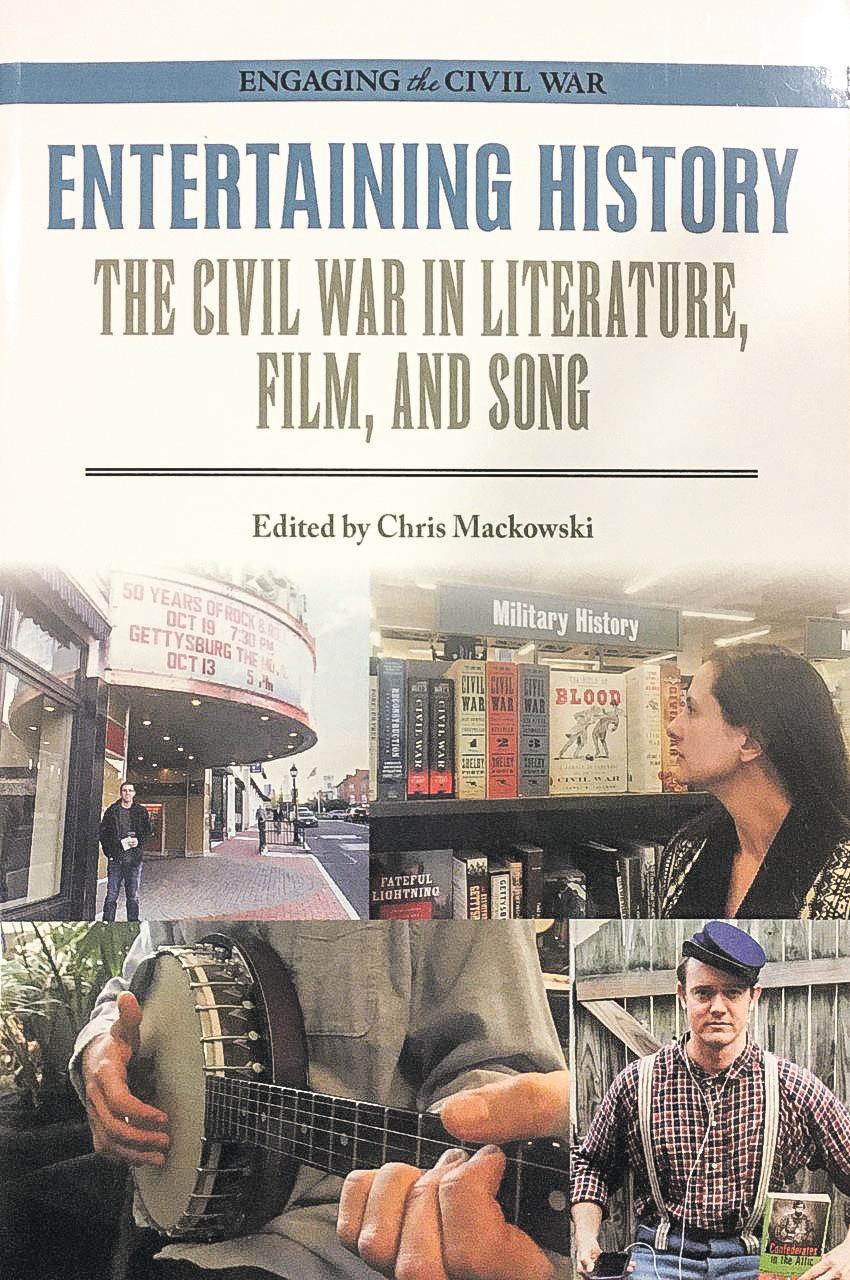
You can learn more about the book (and order a copy) and the SIUP website: http://www.siupress.com/ books/978-0-8093-3757-6.
Quint. We first profiled him in the February 2017 newsletter (https://conta.cc/2muYXI8). You can read his full ECW bio here: https://emergingcivilwar. com/author-biographies/editors/ ryan-quint/.
Read any good books lately?
Hampton Newsome’s The Fight for the Old North State. It’s extremely well-written, and covers a topic that hasn’t received much attention by historians before. I’m working on a review of the book to run on ECW. When I need to step back from the 1860s, I’ve been making my way through Roy and Lesley Adkins’ Gibraltar: The Greatest Siege in British History. Also very well-written. It’s a great book to reveal the scope of how extensive fighting went on in the name of the American Revolution.
With so many books out there, how do you go about deciding what to read and what to take a pass on? I like reading books on new topics, or new approaches. I’ve grown tired of reading the same story over and over again. Being the book review editor for ECW, I also try to ask myself if I’m even qualified to review a certain book that may come my way. If I don’t think I’m the right fit, I’ll send an email out to our cadre of reviewers. I think that’s a great part of the stable of people we have here; everyone’s got their own specialty so they can really look at a book and evaluate its merit.
“Entertaining History” is part of the Engaging the Civil War Series published by Southern Illinois University Press
10 Questions...with Ryan Quint

We have books on the brain this month! For our 10 Questions, we’re speaking with ECW Book Review Editor Ryan
You’ve been working at Historic Williamsburg. What have you been doing there? I work as part of Colonial Williamsburg’s Military Programs staff. During our programming season, generally March-November, that means daily demonstrations of musket or cannon firings. I also help interpret the Powder Magazine in town. Military equipment was stored there, and Virginia’s Revolution essentially got kickstarted there when the Royal Governor removed the gunpowder to prevent it from falling into the rebels’ hands. That’s simplifying the story to a degree, so I guess people will just have to come on down for the full version.
You spent an earlier part of your career in the Fredericksburg area, where there’s a lot of colonial and Civil War history. Now you’re in the middle of Virginia’s “Historic Triangle” on the Peninsula. What’s it like living in that landscape? Similarities/
32 Civil War News March 2020 www.emergingcivilwar.com
Chris Mackowski
ECW’s Chris Mackowski (right) and Civil War News Publisher Jack Melton spent some time together in mid-January.
ECW Book Review Editor Ryan Quint.
differences to Fredericksburg? Obviously living in the Historic Triangle, the focus is on the Colonial Period/American Revolution. You have to really dig to find the Civil War. For people who aren’t interested in the Civil War, that’s perfect for them, but I tell people I could work for Colonial Williamsburg for 100 years and I’d still be a Civil War historian, so that’s sometimes a challenge. The biggest difference I think is an atmospheric one. Fredericksburg is a breathing city, it’s alive. Walk down Caroline Street any evening and you’re bound to find something going on. Williamsburg is different. When Virginia’s capital moved to Richmond in 1780, the city of Williamsburg kind of went to sleep, and I’m not sure it’s ever woken up. There’s a section of town called New Town, and that has shops, and restaurants, etc., but you have to leave the historic area to get to it; it’s not integrated like Fredericksburg. I guess this is a long-winded answer to say I miss Fredericksburg, and I hope I get to return some day.
You’ve been at work for a while on a book about Dranesville. How’s that coming? Really well, actually. When I started the project, I still worked for the National Park Service, and sometimes I’d get home from work and the last thing I wanted to do was keep thinking about or writing about the Civil War, so goings were slow. But to kind of tie in with the previous questions, when I get home from Colonial Williamsburg, I’m eager to jump from the 1770s back into “my” period. I have almost the entire manuscript written, and I’m working on the conclusion now. I’ve never been very good at conclusions, so it’s taking some more time. Then comes edits and rewrites, but I see the light at the end of the tunnel.
You take a bit of good-natured ribbing from some of our ECW colleagues about Dranesville. Why do they bust on you about that? Most of ECW’s historians have worked for battlefield parks where tens of thousands of soldiers clashed, and where thousands died. So they’re used to these sweeping movements and grand assaults and their drama. Here I a small, brigade-sized action that lasted two hours and had, roughly, 270 casualties. As a result, I think to a certain degree they believe it’s not worth the energy. But I’m happy with that, because no one’s ever told this story before, at least not to the degree that I think it warrants. The few articles written about
the battle almost all used just the Official Records for their sources, and there hadn’t been any serious digging in the archives. There’s a surprising amount of primary accounts written about Dranesville, someone just has to take the time to find them. If my colleagues want to read the 400th book about the battle of Gettysburg released just this year, that’s their prerogative.
To conclude on that topic, I want to swing back to those 270 casualties. Frank English was one of them. He was 16-years old when he was killed at Dranesville. To his family, Dranesville was the most important battle in world history, and I’m excited I get to tell that story.
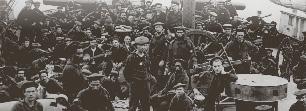
Lightning Round (short answers with a one-sentence explanation)
Favorite primary source?Official Records of the War of the Rebellion. Flawed, sure, but it’s still the first source I pull out every time I want to research something.
Favorite Civil War-related monument? The Pennsylvania State Monument at Gettysburg. Its grand-scale draws you in, but the names on all those plaques reminds you that the battle, and the war, were fought by individuals, each one with hopes and dreams.
Favorite unsung hero of the Civil War era? George B. McClellan. Sure, everyone likes to kick him and somehow think they could have done a better job than him, but he made the Army of the Potomac. You’ve got to lay the foundations somewhere, and he did that.
What’s a bucket-list Civil War site you’ve not yet visited? Chickamauaga. But I’ll be fixing that in March. Some friends and I are spending a long weekend hitting Atlanta, Kennesaw Mountain, and Chickamauga/ Chattanooga.
Favorite ECWS book that’s not one of your own? Richmond Shall Not Be Given Up by Doug Crenshaw. The Seven Days Battles are big, complex, and have the potential to confuse the hell out of people. Doug did a great job of boiling it all down.
ECW Podcast
The Emerging Civil War Podcast spent time in January with historian Dave Powell for a two-part conversation on leadership at Chickamauga. We focused on Federal leadership in our first podcast and Confederate
leadership in our second. Podcast episodes are available on our Patreon page: https://www.patreon.com/emergingcivilwar.
a full bio are available as part of the 2019-2020 ECW Speakers Bureau Brochure, available here: https://emergingcivilwar. com/upcoming-presentations/ speakers-bureau.
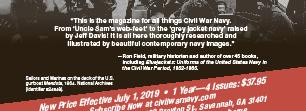
Emerging Revolutionary War News


“Although George Washington used the phrase ‘Victory or Death’ as the password for entry into his camps and for the crossing of the Delaware to Trenton, the same term can be applied to the victories that marked the turning of 1776 to 1777. In January 1777, after a win in Trenton, and after some deft maneuvering to escape from British General Lord Cornwallis in New Jersey, Washington and his forces won another stunning victory at Princeton. These twin victories are captured in the Emerging Revolutionary War Series book Victory or Death by historian Mark Maloy. For more information on this volume (and to stay current on all your American Revolutionary Era happenings), check out our website: www. emergingrevolutionarywar.org.
— MAKER — LEATHER WORKS



“Victory or Death” is part of the Emerging Revolutionary War Series.

ECW Speakers Bureau Spotlight
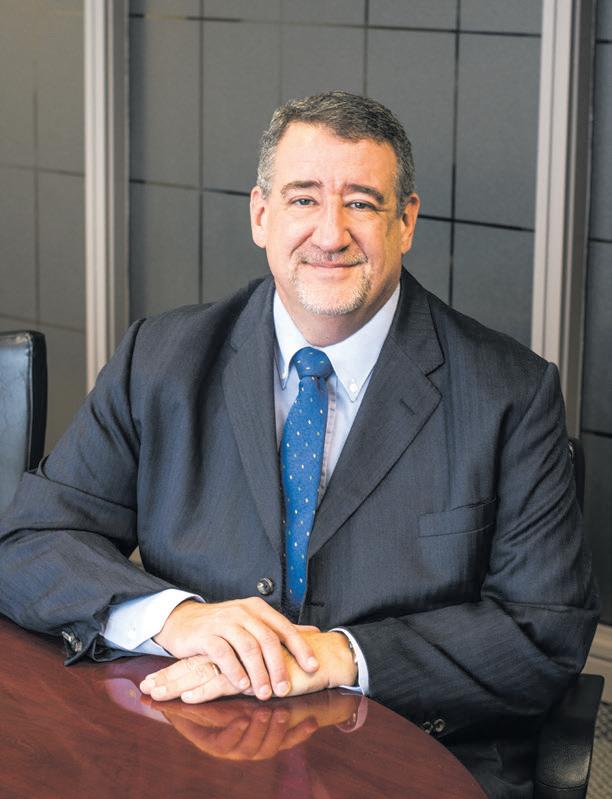
Eric J. Wittenberg is a wellknown and prolific Civil War author. His specialties are cavalry operations, the Gettysburg Campaign, and Sherman’s Carolinas Campaign of 1865. Eric is a native of southeastern Pennsylvania, and was educated at Dickinson College and the University of Pittsburgh School of Law. He is in high demand, and consequently has limited availability. Maximum advance notice is required.
Descriptions of Eric’s talks and

33 March 2020 Civil War News
Eric Wittenberg is one of the ECW’s most popular speakers.
Museum Quality “Raising The Standard” Made In The USA Visit us at www.DellsLeatherWorks.com • (845) 339-4916 Dedicated to the Common Soldiers Who Fought in The War Between The States AUTHENTIC QUALITY REPRODUCTIONS 31st Edition Since 1999 Accepting Discover, Visa, MasterCard and American Express
by W. Clifford Roberts
Of the more than 50 national reunions held by the United Confederate Veterans, the 6th Reunion in Richmond, Va., during the summer of 1896, may have been one of the more memorable gatherings of Southern veterans. It was here in the City Auditorium (now the Cary Street Gym of Virginia Commonwealth University) that the Sons of Confederate Veterans was founded, and the torch first passed to the next generation. It was also here in Richmond that the veterans gathered on the third day of their convention to lay the cornerstone of the Jefferson Davis Monument. To many of those present, however, the reception and disposition of the report of the Committee of Southern History on the first
The UCV Library of the Southern Cause The 68 Books viewed by Southern Veterans as a “True and Reliable History of the Late Civil War”
day of the reunion drew their intellectual interest.
Commanding General John B. Gordon of Atlanta, Ga., called on the Historical Committee to give their report to the thousands present in the Richmond Music Hall. To cries of “Lee!, Lee!, Lee!,” Stephen Dill Lee, chairman of the committee, rose and walked to the podium. For the past 16 years, the former Confederate Lieutenant General had served as President of the Agricultural and Mechanical College of Mississippi (modern-day Mississippi State University). Since the death of General Edmund Kirby Smith in 1893, he had also chaired this prominent UCV committee. With a growing concern felt throughout the hall that only a “correct” interpretation of Southern history
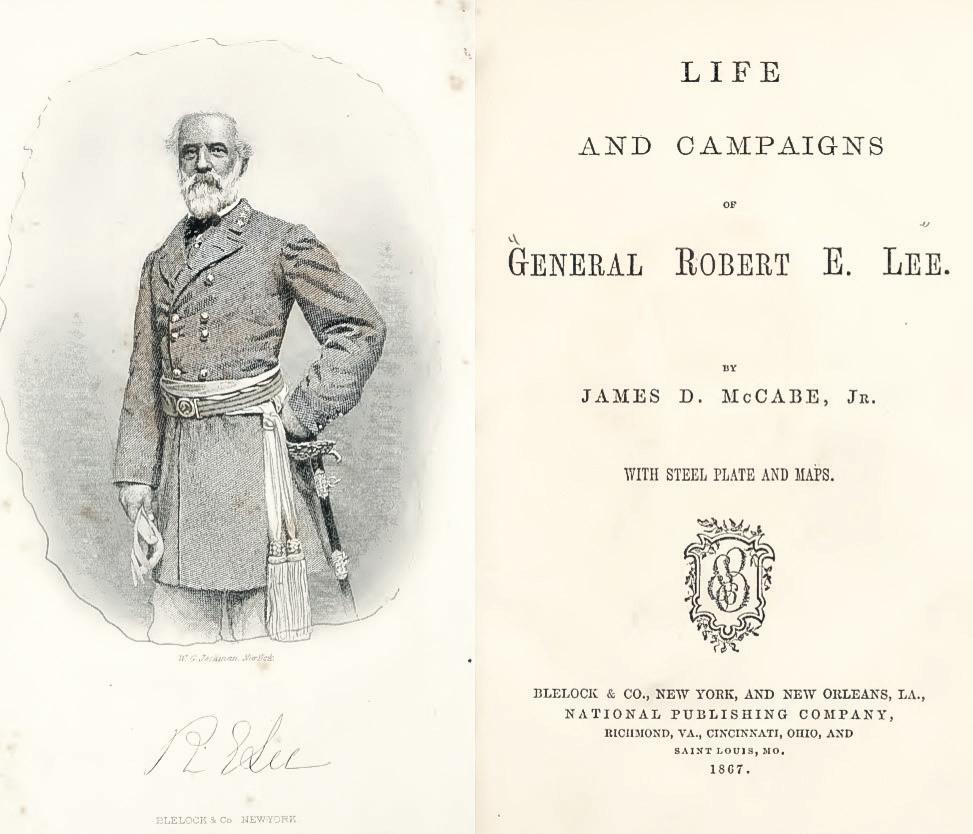
would instill the ethos of the Lost Cause to future generations, Lee explained that his committee of 12 former Confederate officers, including generals Stephen Lee, Clement Evans, Samuel French, and Ellison Capers, believed that “Southern pens shall vindicate Southern history.”
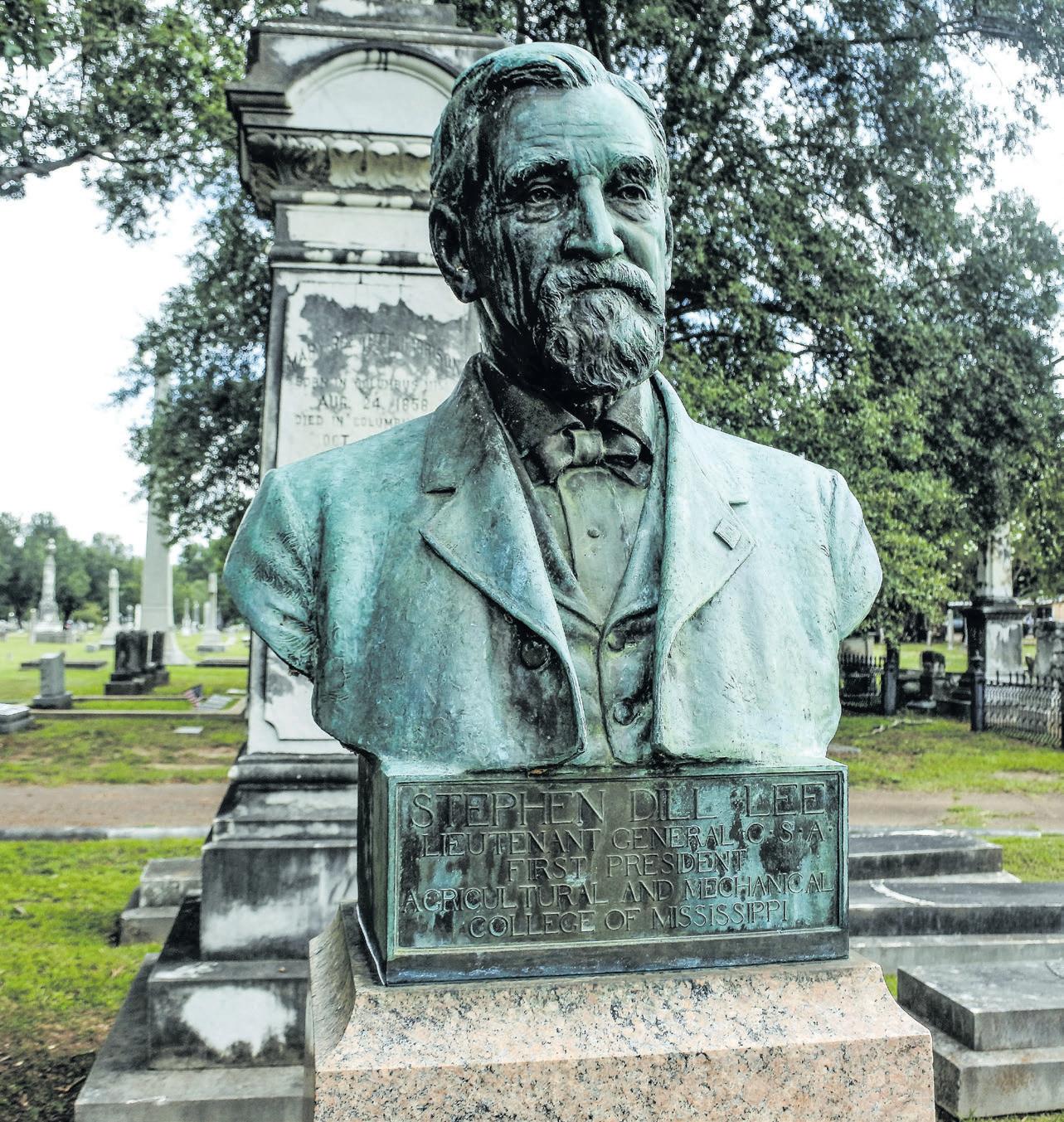
To thunderous applause, Lee’s committee called on each Southern legislature to create a chair of American History in one of their state universities. The committee reported that their review of Northern textbooks had found them, in most cases, “pronouncedly unfair to the South, her institutions, and her part in History.” They, in turn, endorsed 12 textbooks on American History, all written by Southerners. The two most influential turned out to be J. William Jones’ School History of the United States (1896) and Susan Pendleton Lee’s A School History of the United States (1895). The committee foresaw a vigorous new generation of Southern historians, whom they expected to write with eloquence, candor, patriotism, philosophy, and wisdom, as these authors would be entrusted with “the vindication of the South and of the Confederate soldier.”
Finally, Lee’s committee submitted a list of Civil War books thought proper for a public or private library. This is the first and perhaps only list of books endorsed by the United Confederate Veterans. Complete facsimiles of each of these books can be found today at Internet Archive (https:// archive.org.), but it is a rare library today that holds all 68 titles called for by Stephen D. Lee in 1896.


Sources: Report of the United Confederate Veterans Historical Committee; Which was Unanimously Adopted at the Sixth Annual Reunion, Held at Richmond, VA, 1896 (Richmond: J.L. Print, Company, 1896) pages 1-23.

Charles Reagan Wilson, Baptized in Blood; The Religion of the Lost Cause, 1865–1920 (Athens: University of Georgia Press, 2009) 139-141.
Cliff Roberts is the co-author of Atlanta’s Fighting 42nd: Joseph Johnston’s “Old Guard”, published in 2020 by Mercer University Press.
34 Civil War News March 2020
Selections from the UCV Library of the Southern Cause.
Seven books by John Esten Cooke made this 1896 list.
An excerpt from Carlton McCarthy’s Detailed Minutiae of Soldier Life.
An early biography of Robert E. Lee.
Stephen Dill Lee is buried at Friendship Cemetery in Columbus, Miss.
1. Southern Historical Society Papers, 14 volumes edited by J. William Jones, D.D., and 9 volumes edited by Robert Alonzo Brock. (Richmond: Southern Historical Society, 1874–1896) In 23 volumes as of 1896.
2. The Rise and Fall of the Confederate Government , Jefferson Davis (New York: D. Appleton & Company, 1881) In two volumes.
3. A Short History of the Confederate States of America, Jefferson Davis (New York: Belford Company, 1890).
4. A Constitutional View of the Late War Between the States , Alexander H. Stephens (Philadelphia: National Publishing Company, 1868) In two volumes.
5. The War of the Rebellion: A Compilation of the Official Records of the Union and Confederate Armies , United States War Department (Washington, D.C.: Government Printing Office, 1880–1896) 48 volumes as of 1896.
6. Is Davis a Traitor; or, Was Succession a Constitutional Right Previous to the War of 1861?, Dr. Albert Taylor Bledsoe (Baltimore: Innes & Company, 1866).
7. The Republic of Republics, Bernard Janin Sage (Philadelphia: William W. Harding, 1878).
8. Story of the Confederate States, Joseph Tyrone Derry (Richmond: B.F. Johnson Publishing Company, 1895).
9. The Southern States of the American Union , Jabez Lamar Monroe Curry (Richmond: B. F Johnson Publishing Co., 1895).
10. A Defense of Virginia, and Through Her, of the South, Robert Lewis Dabney, D.D. (New York: E.J. Hale & Son, 1867).
11. Military Annals of Tennessee, John Berrien Lindsley (Nashville: J.M. Lindsley & Company, 1886).
12. The Secret Service of the Confederate States in Europe , James D. Bulloch (New York: G.P. Putnam & Sons, 1884) In two volumes.
13. Memoirs of Service Afloat, During the War Between the States , Admiral Raphael Semmes (Baltimore:
The UCV Library of the Southern Cause
Kelly, Piet & Company, 1869).
14. Two Years on the Alabama , Arthur Sinclair (Boston: Lee and Sheppard Publishers, 1895).
15. The Narrative of a Blockade-Runner, Captain John Wilkinson (New York: Sheldon & Company, 1877).
16. History of the Confederate States Navy from its Organization to the Surrender of its Last Vessel , John Thomas Scharf (Albany, NY: Joseph McDonough, 1886).
17. Personal Reminiscences, Anecdotes and Letters of Gen. Robert E. Lee , Dr. J. William Jones, D.D. (New York: D. Appleton & Company, 1875).
18. Four Years with General Lee, Colonel Walter Herron Taylor (New York: D. Appleton & Co., 1877).
19. General Lee , General Fitzhugh Lee (New York: D. Appleton & Company, 1894).
20. Memoirs of Robert E. Lee; His Military and Personal History , General A. L. Long (London: Sampson, Low, Marston, Searle, and Rivington, 1886).
21. A Life of Gen. Robert E. Lee , John Esten Cooke (New York: D. Appleton & Company, 1876).
22. Life and Campaigns of General Robert E. Lee , James D. McCabe (New York: Blelock & Company, 1867).
23. The Life of Gen. Robert E. Lee, For Children, In Easy Words , Mary Lynn Williamson (Richmond: B.F. Johnson, 1895).
24. Popular Life of General Robert Edward Lee, Emily Virginia Mason (Baltimore: John Murphy & Co., 1872).
25. Life and Campaigns of Lieut.-Gen. Thomas J. Jackson , Robert Lewis Dabney, D.D. (New York: Blelock & Company, 1866) In two volumes.
26. Memoirs of Stonewall Jackson, by his widow, Mary Anna Jackson, Mary Ann Jackson (Louisville: Courier-Journal Job Printing Company, 1895).
27. Jefferson Davis, ex-President of the Confederate States of America: A Memoir , Varina Davis (New York: Belford Company, Publishers, 1890) In two volumes.
28. The Davis Memorial Volume; or, Our Dead President, Jefferson Davis, and the World’s Tribute to his Memory , Dr. John William Jones (Richmond: B. F. Johnson & Company, 1890).
29. Memoirs of William Nelson Pendleton, D.D. , Mrs. Susan Pendleton Lee (Philadelphia: J.P. Lippincott, 1893).
30. A Life of Matthew Fontaine Maury, U.S.N. and C.S.N. , Diana Fontaine Maury Corbin (London: Sampson Low, Marston, Searle, & Rivington Limited, 1888).
31. The Life and Services of Commodore Josiah Tatnall, Charles C. Jones (Savannah: Morning News Steam Printing House, 1878).
32. The Letters and Times of the Tylers, Lyon Gardiner Tyler (Richmond: Whittet & Shepperson, 1884) In three volumes.
33. Christ in the Camp; or, Religion in Lee’s Army , Rev. J. William Jones (Richmond: B. F. Johnson & Company, 1887).
34. Army of Northern Virginia, John William Jones, D.D. (Richmond: J.W. Randolph & English, 1880).
35. Jackson’s Valley Campaign , William Allan (Richmond: G.W. Gary & Company, 1878).
36. The Confederate Capital and Hood’s Texas Brigade , Angelina Virginia Winkler (Austin: Eugene Von Boeckmann, 1894).
37. The Army of Northern Virginia in 1862, William Allan (Boston: Houghton, Mifflin & Company, 1892).
38. The Battlefields of Virginia: Chancellorsville , Jed Hotchkiss & William Allan (New York: D. Van Nostrand, 1867).
39. Stonewall Jackson: A Military Biography, John Esten Cooke (New York: D. Appleton & Company, 1866).
40. The Life and Campaigns of Major General J. E. B. Stuart , Henry Brainerd McClellan (Boston: Houghton, Mifflin and Company, 1885).
41. General [Joseph E.] Johnston, Robert Morton Hughes (New York: D. Appleton and Company, 1893).
42. Narrative of Military Op-
erations , General Joseph E. Johnston (New York: D. Appleton & Company, 1874).
43. History of Morgan’s Cavalry, Basil W. Duke (Cincinnati: Miami Printing and Publishing, 1867).
44. The Campaigns of Lieut.Gen. N.B. Forrest, and of Forrest’s Cavalry , General Thomas Jordan & J.P. Pryor (New Orleans: Blelock & Company, 1868).
45. Leonidas Polk, Bishop & General, Dr. William M. Polk (New York: Longmass Green & Co., 1893) In two volumes.
46. The Military Operations of General Beauregard in the War Between the States 1861 to 1865, Judge Alfred Roman (New York: Harper and Brothers, 1884) In two volumes.
47. Advance and Retreat, General John Bell Hood (New Orleans: Hood Orphan Memorial Fund, 1880).
48. From Manassas to Appomattox; Memoirs of the Civil War in America , Lieutenant-General James Longstreet (Philadelphia: J.P. Lippincott Company, 1896).
49. A Memoir of the Life and Public Service of Joseph E. Johnston , Bradley T. Johnson (Baltimore: R. H. Woodward & Company, 1891).
50. The Defense of Charleston Harbor, Including Fort Sumter and the Adjacent Islands, John Johnson (Charleston: Walker, Evans, and Cogswell Company, 1890).
51. Gen. Albert Sidney Johnston , William Preston Johnston (New York: D. Appleton & Company, 1878).
52. Confederate View of the Treatment of Prisoners , Rev. John William Jones (Richmond: Southern Historical Society, 1876).
53. The Southern Side; or, Andersonville Prison , R. Randolph Stevenson, MD (Baltimore: Turnbull Brothers, 1876).
54. United States Bonds; or Duress by Federal Authority: A Journal of Current Events During an Imprisonment of Fifteen Months, at Fort Delaware , Rev. Isaac W. K. Handy (Baltimore: Turnbull Brothers, 1874).
55. A Memoir of the Last Year
of the War for Independence in the Confederate States of America , Lieutenant-General Jubal A. Early (Toronto: Lovell & Gibson, 1866).
56. Recollections of a Virginian in the Mexican, Indian, and Civil Wars , General Dabney Herndon Maury (New York: Charles Scribner’s Sons, 1894).
57. Detailed Minutiae of Soldier Life in the Army of Northern Virginia 1861–1865 , Carlton McCarthy (Richmond: B.F. Johnson Publishing Company, 1882).
58. Women; or, Chronicles of the Late War , Mary Tucker MaGill (Baltimore: Turnbull Brothers, 1871).
59. The University Memorial: Biographical Sketches of Alumni of the University of Virginia Who Fell in the Confederate War , Rev. John Lipscomb Johnson (Baltimore: Turnbull Brothers, 1871).
60. Memorial, Virginia Military Institute: Biographical Sketches of the Graduates and Eleves Who Fell During the War Between the States, Charles D. Walker (Philadelphia: J.B. Lippincott & Company, 1875).
61. Diary of a Southern Refugee, During the War, by a Lady of Virginia, Judith White McGuire (New York: E.J. Hale & Sons, 1867).
62. Richmond During the War; Four Years of Personal Observation by a Richmond Lady, Sallie A. Brock (New York: G.W. Carleton, 1867).
63. Wearing of the Gray, John Esten Cooke (New York: E.B. Treat, 1867).
64. Hammer and Rapier, John Esten Cooke (New York: Carleton Publisher, 1870).
65. Hilt to Hilt , John Esten Cooke (New York: G.W. Dillingham Co., 1869).
66. Surry of Eagle’s-Nest; or, The Memoirs of a Staff-Officer Serving in Virginia , John Esten Cooke (New York: Bunce & Huntington, 1866).
67. Mohun; or, The Last Days of Lee and His Paladins, John Esten Cooke (New York: F.J. Huntington and Co., 1869).
68. Memorials of a Southern Planter , Susan Dabney Smedes (Baltimore: Cushings & Bailey, 1887).
35 March 2020 Civil War News
American Digger Lowcountry Civil War & Artifact Show
MT. PLEASANT, SC—January
4-5, 2020. The artifact show season kicked off once again with the American Digger Lowcountry Show, featuring exhibitors and dealers from across the country. Traditionally a relaxing and laid

back show, this year’s attendance topped any show held here since American Digger Events, a part of American Digger magazine, took on its management in 2016. This year marked the show’s 25th continuous year. Over 1,200
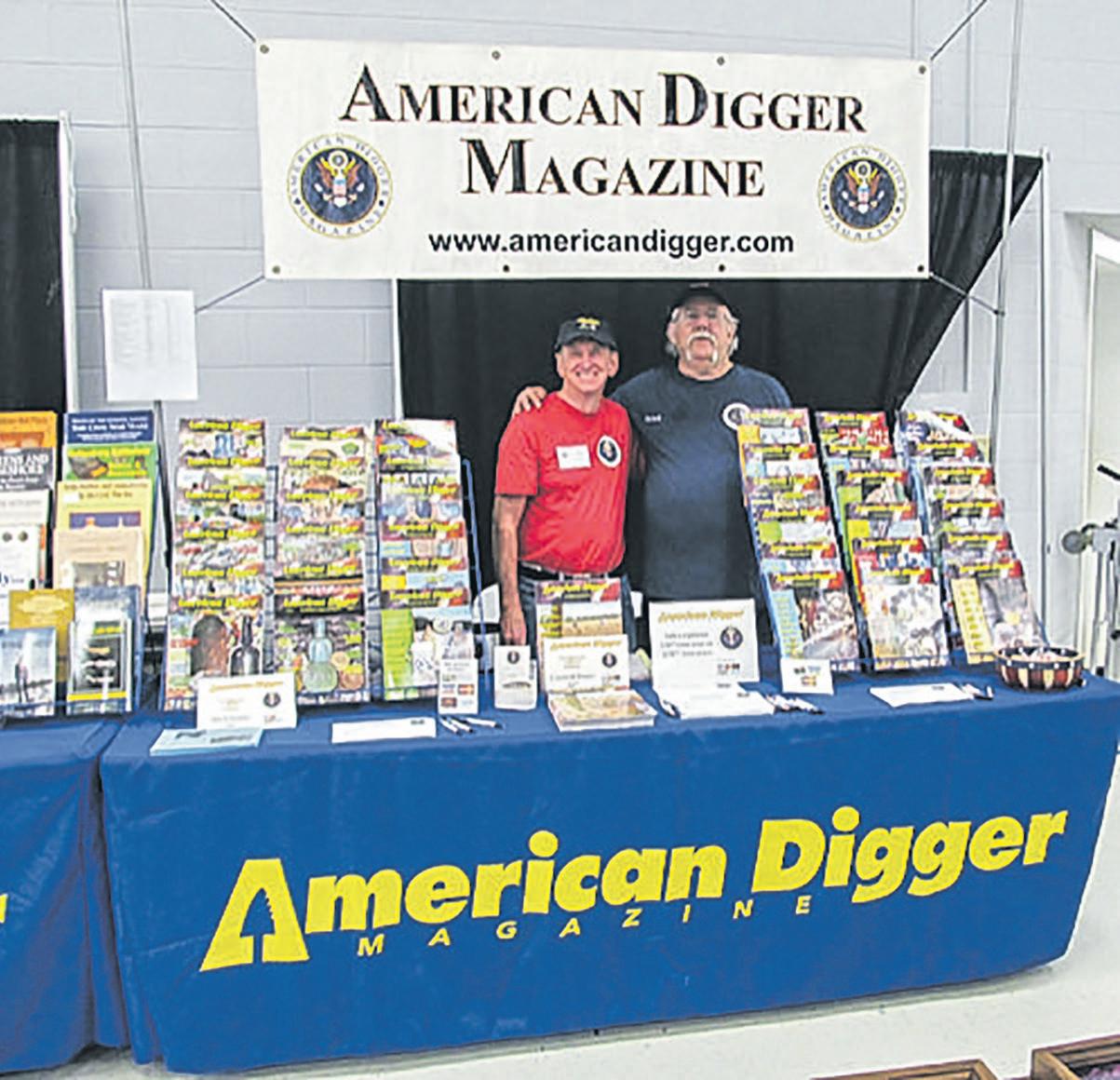
people came through the gate to enjoy 200 tables of historical displays and sale tables of artifacts, books, jewelry, weapons, paper, and Americana.

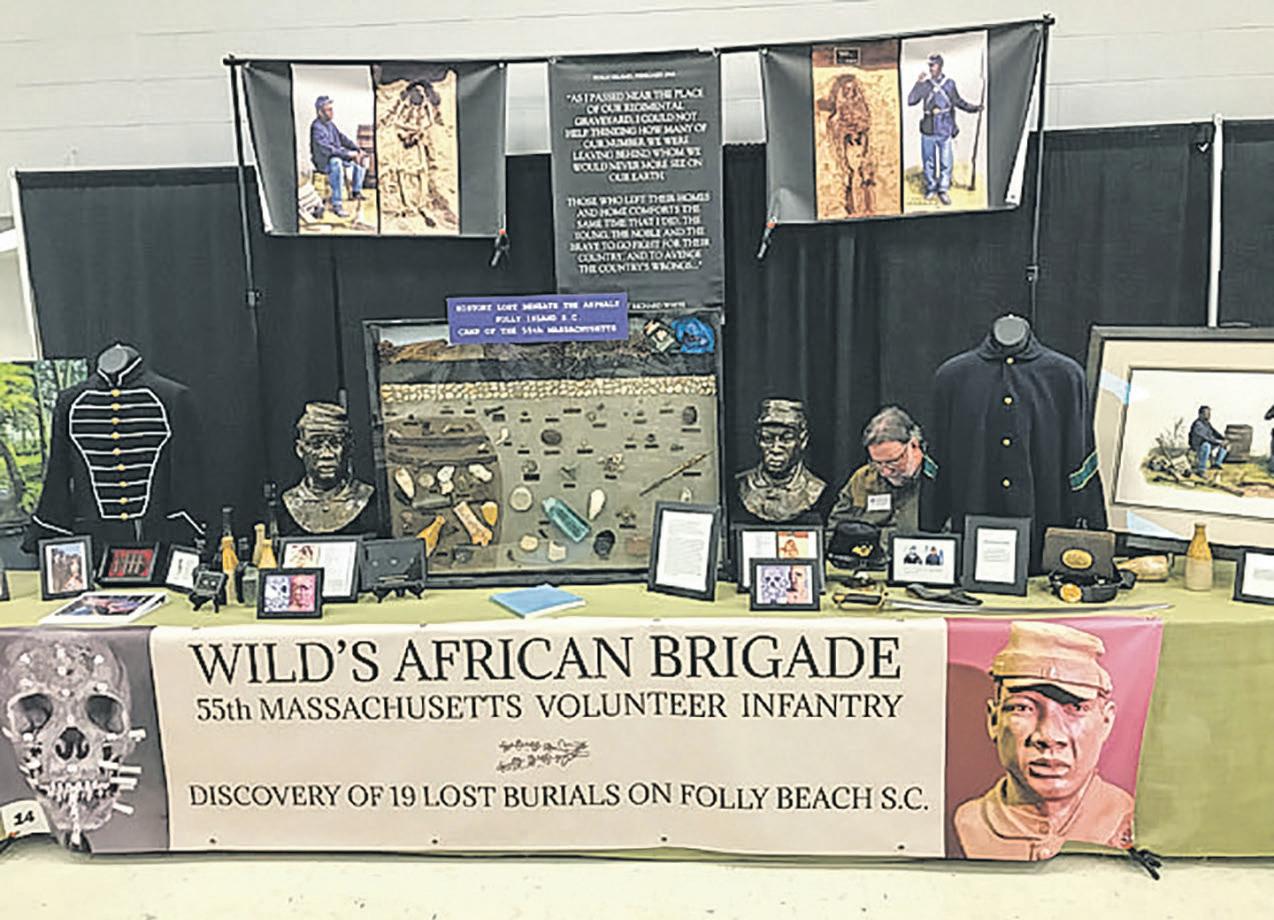
The larger crowds were in part due to aggressive promotion including news coverage on both radio and TV. Also, children under 12 received not only free admission but also a prize package that included Civil War bullets, fossils, arrowheads, and more, courtesy of Smoky Mtn. Relic Room.
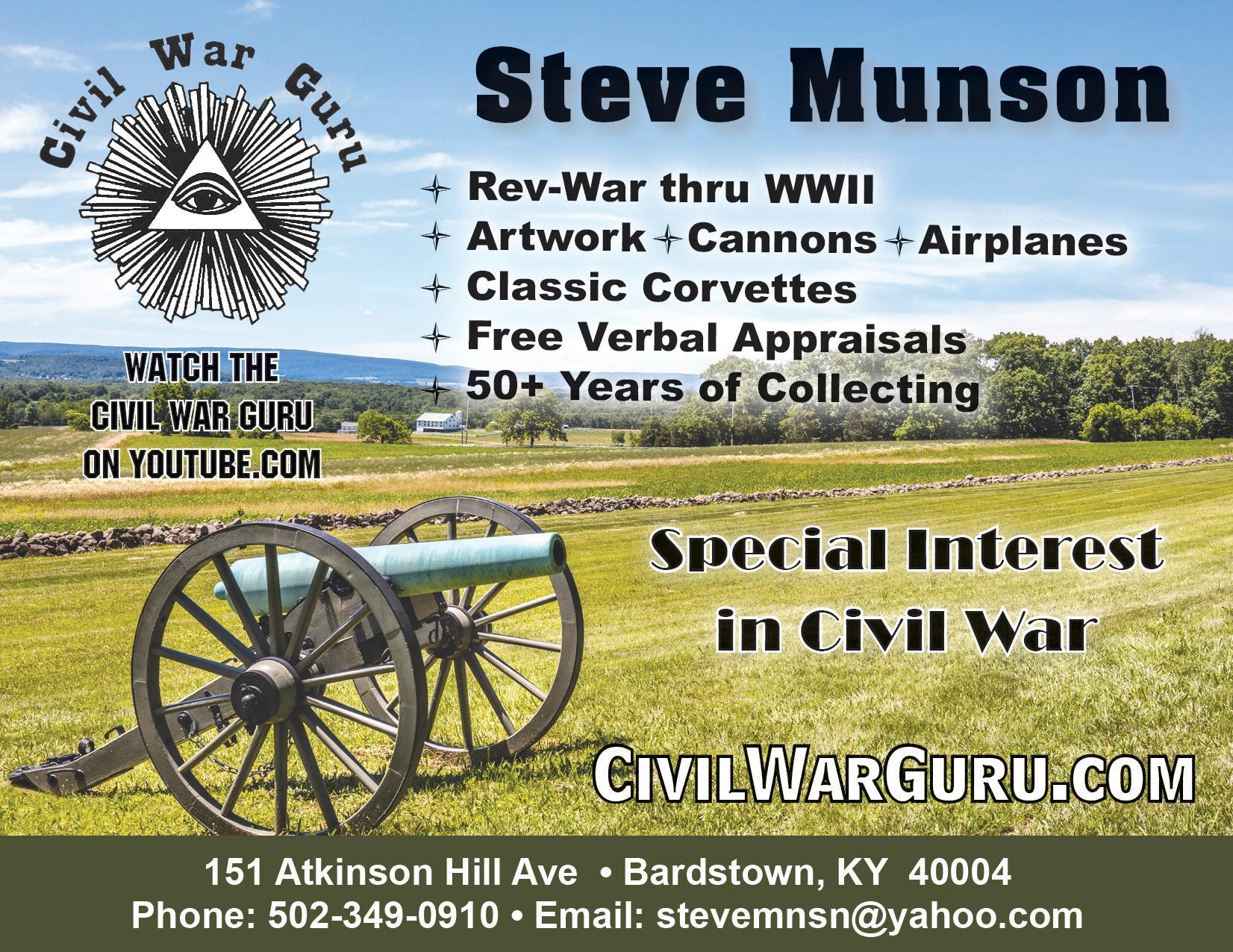
Awards were given as always, and the judging was very tight this year due to several new displays being presented. This year’s winners were: Most Educational: Clifford Krainik, The Slave Tag Project; Best of Show: Robert Bohrn, Wilde’s African Brigade; Best Dug: Jerry Bochex, 6th NC belt plate with hooks; and Best Non Dug: Mike Fisher, ID badge with photo of soldier wearing it. Show dates have already been announced for January 2 & 3, 2021 at the same location. To reserve your table space for next year, contact 770-712-7648 or email Anita at anita@americandigger.com.

36 Civil War News March 2020 48 E. Patrick St., Frederick, MD. 301-695-1864 / civilwarmed.org Divided by
by Compassion.
Conflict. United
Event promoter and publisher Butch Holcombe and Bill Hayes at the American Digger Magazine tables.
Best of show display, by Robert Bohrn.
Dave Topper used the event to introduce a new book, his first in over thirty years.
Crowds were at a record number at the event, held in Mt. Pleasant, SC.
Garry Adelman Speaks to the Atlanta Civil War Round Table

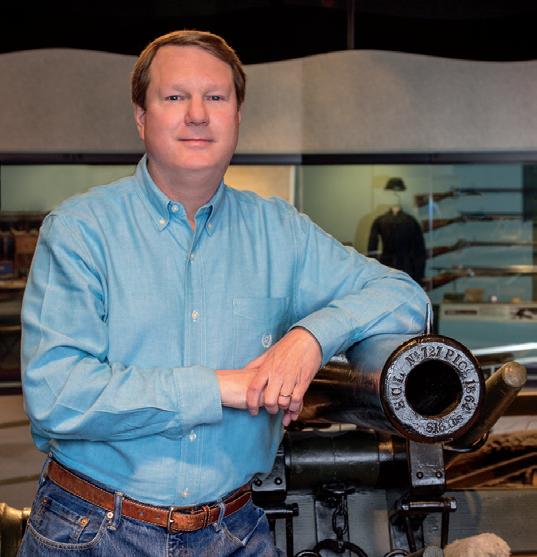
ATLANTA, Ga.—On Tuesday, January 14, 2020, historian Garry Adelman gave a presentation to the Atlanta Civil War Round Table at the Capital City Club downtown to a packed house of some 110 members and guests. His original title was “Civil War Artillery – the Long Arm of the Army,” but he changed it to “A Civil War Artillery Extravaganza.” Both titles were accurate, but an “Extravaganza” it was!

A graduate of Michigan State University and Shippensburg University of Pennsylvania, Garry Adelman is the award-winning author, co-author, or editor of 20 Civil War books and 50 related articles. He is vice president of the Center for Civil War Photography, and has been a Licensed Battlefield Guide at Gettysburg for 25 years. He has appeared on numerous productions shown on the BBC, C-Span, Pennsylvania Cable Network, and on HISTORY, and works full time as chief historian at the American Battlefield Trust.
Summary of Presentation
From the first shots in Charleston Harbor to the massive salutes that signaled the Civil War’s end, artillery played a crucial role throughout the conflict; the “long arm” continues to fascinate students, buffs, and engineers alike. Adelman offered a wide-ranging presentation that endeavored to cover the people, places, and technology that render artillery a topic of endless fascination. He broke down the main categories of cannon, what they fired, and showed numerous photos of each. From massed and masked battalions, to river and fortress batteries, to the terrible human consequence of cannon fire, and the tubes seen on battlefields today, Adelman covered it all for novices and experts alike. He covered the practical and the emotional sides in a manner you are unlikely to see anywhere else.
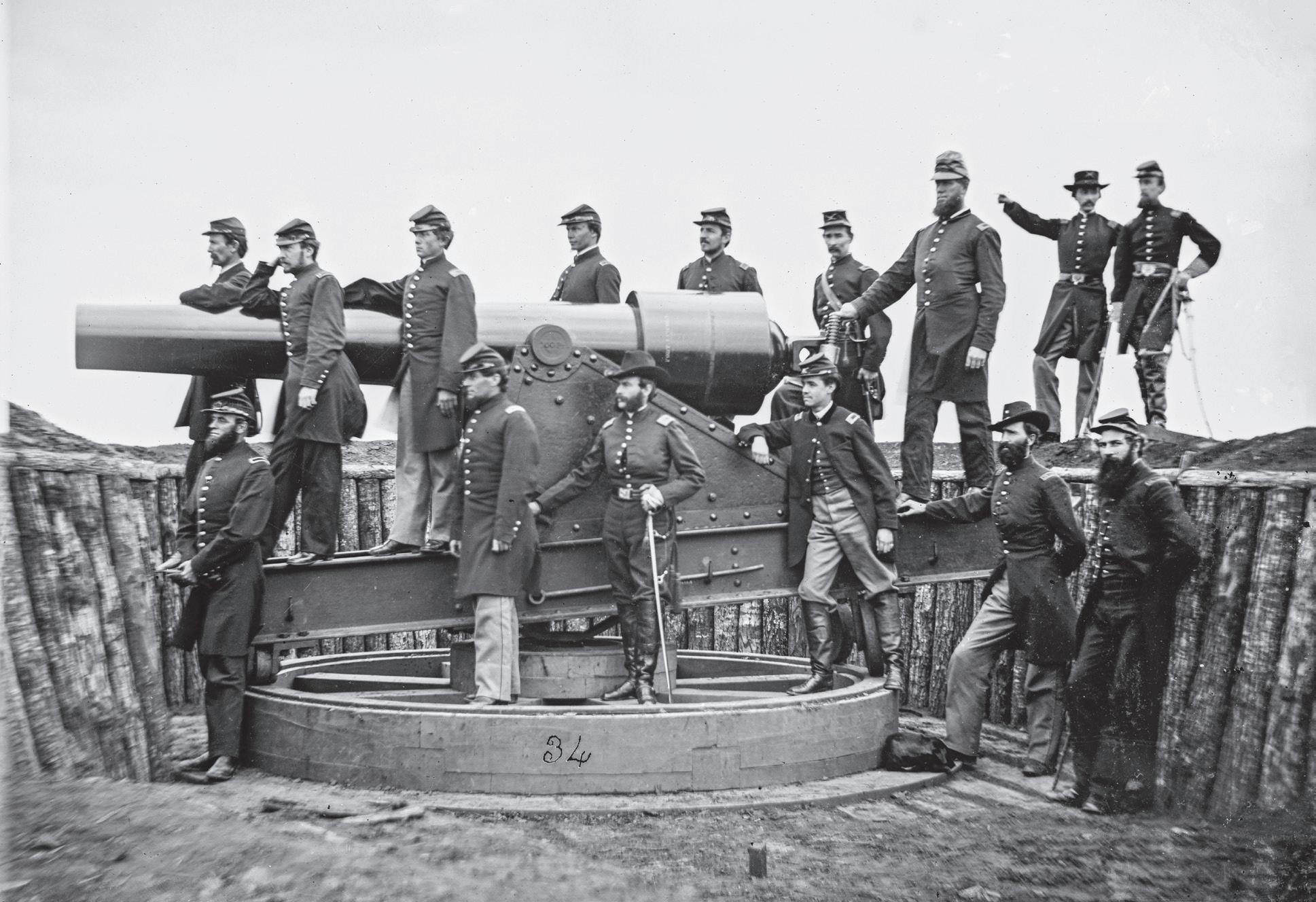
Garry’s energy is boundless… he used slides (148 in the space of 40 minutes this evening) to trigger his fount of knowledge on the subject, and zoomed in on period photographs rarely seen by the general public. The Atlanta Round Table was fortunate to have Garry visit us and offer this presentation. He received an engraved box with our logo, his name, the date, and an honorarium of $500 for the evening. In addition, a special raffle was held to give away an unfired 3-inch Hotchkiss case shot projectile, recovered in the 1970s by a relic hunter from the Battle of Allatoona Pass, Ga., site to a lucky member who attended the presentation.
CHARLESTON IN THE WAR
100 Signi cant Civil War Photographs: Charleston in the War features newly restored images of scenes in the famed city, taken 1860–1865. The cameramen include the better-known, such as George N. Barnard and George S. Cook, as well as some lesser-known ones: Samuel Cooley, Charles Quinby, the partners Haas & Peale, Osborn & Durbec.
Submitted by:
John A. Dietrichs President, ACWRT 2019-2020

100 Signi cant Civil War Photographs: Charleston in the War features newly restored images of scenes in the famed city, taken 1860–1865. e cameramen include the better-known, such as George N. Barnard and George S. Cook, as well as some lesser-known ones: Samuel Cooley, Charles Quinby, the partners Haas & Peale, Osborn & Durbec. Text by Stephen Davis and Jack Melton accompanies each featured photograph, describing the pictured scenes and the history surrounding them. e selected images depict a variety of settings: that portion of Charleston known as e Battery, the “Burnt District” (the area of the city destroyed by the Great Fire of December 1861), the Charleston Arsenal, and the many churches that allow Charlestonians to call theirs “the Holy City.” Special sections of this book are devoted to the huge Blakely guns imported from England by the Confederates and close-ups of Barnard’s views. e history of Civil War Charleston goes back to e Defense of Charleston Harbor (1890) by John Johnson, Confederate major of engineers, and to Reminiscences of Forts Sumter and Moultrie in 1860-’61 (1876) by Capt. Abner Doubleday, Federal second-in-command. Since then Charlestonians have contributed to the history of their city, notably Robert N. Rosen and Richard W. Hatcher III. e historical text surrounding 100 Signi cant Photographs draws on these and other works. A unique feature is its reliance upon the writings of actual participants, such as Augustine T. Smythe (1842–1914) and Emma Edwards Holmes (1838–1910).


Text by Stephen Davis and Jack Melton accompanies each featured photograph, describing the pictured scenes and the history surrounding them. The selected images depict a variety of settings: that portion of Charleston known as The Battery, the “Burnt District” (the area of the city destroyed by the Great Fire of December 1861), the Charleston Arsenal, and the many churches that allow Charlestonians to call theirs “the Holy City.” Special sections of this book are devoted to the huge Blakely guns imported from England by the Confederates and close-ups of Barnard’s views.
As a contribution to this literature, 100 Signi cant Civil War Photographs: Charleston in the War o ers rewards for all readers, from the casual novice to the serious student.
The history of Civil War Charleston goes back to The Defense of Charleston Harbor (1890) by John Johnson, Confederate major of engineers, and to Reminiscences of Forts Sumter and Moultrie in 1860-’61 (1876) by Capt. Abner Doubleday, Federal second-in-command. Since then Charlestonians have contributed to the history of their city, notably Robert N. Rosen and Richard W. Hatcher III. The historical text surrounding 100 Signi cant Photographs draws on these and other works. A unique feature is its reliance upon the writings of actual participants, such as Augustine T. Smythe (1842–1914) and Emma Edwards Holmes (1838–1910).
As a contribution to this literature, 100 Signi cant Civil War Photographs: Charleston in the War o ers rewards for all readers, from the casual novice to the serious student.



IN

160 pages, Over 100 Photos, Maps, Index, Bibliography, Softcover. ISBN: 978-1-61850-167-7
$19.95 + 3.50 S&H Order online at www.HistoricalPubs.com or call 800-777-1862
37 March 2020 Civil War News
DAVIS & MELTON 100 SIGNIFICANT CIVIL WAR PHOTOGRAPHS CHARLESTON
THE WAR
CHARLESTON IN THE WAR
Stephen Davis JACK W. MELTON JR.
Officers of 3d Regiment Massachusetts Heavy Artillery pose with a 100-pounder Parrott rifle at Fort Totten, Washington, D.C. (Library of Congress)
John Dietrichs, Atlanta Civil War Round Table President, presents Garry Adelman with a personalized wooden box with the round table’s logo.
Garry Adelman’s PowerPoint presentation contained rarely viewed artillery images.
CIVIL WAR BOOK,___ B mv 11:
Civil War News book reviews provide our readers with timely analysis of the latest and most significant Civil War research and scholarship. Contact email: BookReviews@CivilWarNews.com.
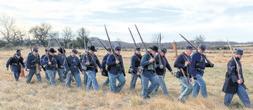


A Look at Secession as a Global Movement in the Antebellum Era

Liberty and SlaveryEuropean Separatists, Southern Secession and the American Civil War. By Niels Eichhorn. Index, Bibliography, Endnotes. 202 pages, 2019. LSU Press, www.lsupress.org. $45.00
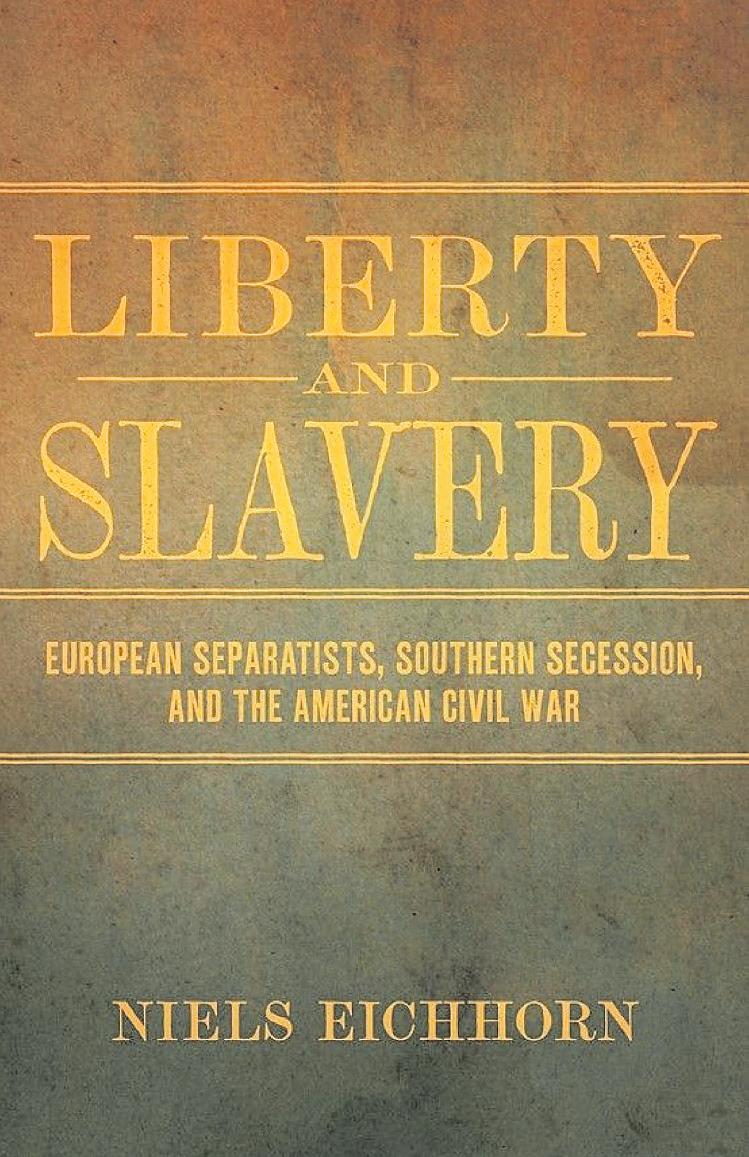
Reviewed by Tom Elmore

A Good Book—A Great Museum
The Story of Civil War Medicine: Divided by Conflict, United by Compassion, by Terry Reimer. B/W and color photographs, maps, 74 pp., The NMCWM Press, $12.95 softcover.
Reviewed by Meg Groeling
Continuing the recent, and much welcomed, trend of books looking at the American Civil War as a global event is this one that examines various separatist movements throughout Europe in the first half of the 19th century. While the quest for Irish independence is well known, many of the ones featured here, including the Hungarian and Polish are not as famous.
The author, a history professor at Middle Georgia State University, looks at these various movements and tries to show what they had in common with each other and the quest for independence in the southern United States. Ultimately, he fails. While European secession movements were centered on ethnic groups that had legitimate cultural, linguistic, or religious differences, the secession movement in the South was based primarily on economics and politics.
Eichhorn tends to gloss over things and often mentions people,

places, and events without full or proper context in either the text or the notes. This reviewer had to look up several things that were mentioned in passing. Conspicuously missing is any mention of the Italian unification movement, a major headache for many European leaders in the 19th century. The book also lacks maps, that would have helped a reader understand the geo-politics in Europe at the time or any images of the people and events mentioned.
Perhaps most disappointing is that the author did not try to show any parallels between the 19th century secession movements and the ongoing debate over the future of the European Union and its powers over member states. The fact that there is no comparison between events of the 19th century and 21st century Brexit or the recent Scottish independence movement, is a lost opportunity.
Ultimately, European secession movements had come to fail by the mid-to late-1800s due to lack of money, organization, numbers, and international support. Many movement leaders were arrested, exiled, or executed. It would not be until the 20th century that Ireland, Hungary, and Poland took their places among the nation-states of the world.
Eichorn’s flawed book serves as an introduction to this often overlooked aspect of history, but not much else.
Tom Elmore will be spending much of March 2020 sharing tales of Columbia, S.C.,’s Celtic past while enjoying many pints of Guinness.
The second book in this series is The Story of Civil War Medicine: Divided by Conflict, United by Compassion. Authored by Terry Reimer in 2004, it has been reprinted by the NMCWM Press. This book serves as an introduction to both Civil War medicine and the National Museum of Civil War Medicine, Inc. The main structure of this thoroughly modern old-fashioned museum is in downtown Frederick, Md. It extends to the Pry House on the Antietam battlefield, then moves south to Washington, D.C., to the Clara Barton Office of Missing Soldiers.
Each museum is different in the story it tells as well as in its geographic location. Weaving together a history of Civil War medicine with a history of the creation of the museum, Reimer’s book gives a thorough overview of both.

At the main museum office in Frederick, the letters of Private Peleg Bradford, 1st Main Heavy Artillery, are highlighted. Visitors can follow him from his first illness in camp to being wounded in battle. His recovery in the Union hospital system shows the average care most soldiers received. This museum site also hosts conferences and award ceremonies as well as being part of a vital, thriving downtown Frederick.
The Pry House and Hospital, a large, open-air museum near the
Antietam battlefield, is where Dr. Jonathan Letterman’s medical and logistical innovations were used for the first time at a significant Civil War battle. The dual focus at this site includes the effect war had on the civilians in the battlefield area. The Pry family itself never recovered financially from the battle and its aftermath. An annual Plein Aire painting weekend anchors the variety of events hosted by this site.
The Clara Barton Missing Soldiers Office Museum is a fascinating place with its own story. Found accidentally prior to demolition, the entire three floors are curated to tell the story of Miss Clara Barton and her efforts on behalf of Union soldiers. The space, located in downtown Washington, D.C., has multiple uses. It has hosted beer tastings, wine-and-food pairings, musical events, and receptions for historians and authors. The novel, effective use of museum space adds to its public value.
The Story of Civil War Medicine offers a brief-but-accurate overview of medical practice before and during the war. Highlighted,
of course, are the changes in battlefield care implemented by Major Jonathan Letterman. This small volume, packed with photos and facts, is worth far more than the $12.95 cost. It ends with practical information concerning taxes, stewardship, employment, volunteer and educational opportunities, and directions to and from each site.
Both books are reprints and thank goodness for that. May more information become available, and may the reprint process continue. Our gratitude is both personal and professional.
Meg Groeling received her Masters degree in Military History, with a Civil War emphasis, in 2016, from American Public University. Savas Beatie published her first book, The Aftermath of Battle: The Burial of the Civil War Dead, in the fall of 2015, and she has written First Fallen: the Life of Colonel Elmer Ellsworth, which Savas Beatie has contracted for publication sometime within the 2020-2021. She is a regular contributor to the blog Emerging Civil War.
38 Civil War News March 2020 Digital Issues of CWN are available by subscription alone or with print plus CWN archives at CivilWarNews.com
The 2020 Civil War Dealers Directory is out. To view or download a free copy visit: www.civilwardealers.com/dealers.htm Want To Advertise In Civil War News? Email us at ads@civilwarnews.com Call 800-777-1862 CW N Civil War News Inside this issue: H Day Remembrance Day, 2019, Gettysburgnificent “Gettysburg Address.” – Abraham Lincoln, November 19, 1863.----
What It Meant to be “Disabled” During and After the Civil War

Bodies in Blue: Disability in the Civil War North. By Sarah Handley-Cousins. Photographs, notes, index, 204 pp., The University of Georgia Press, www.ugapress.org, $39.95.
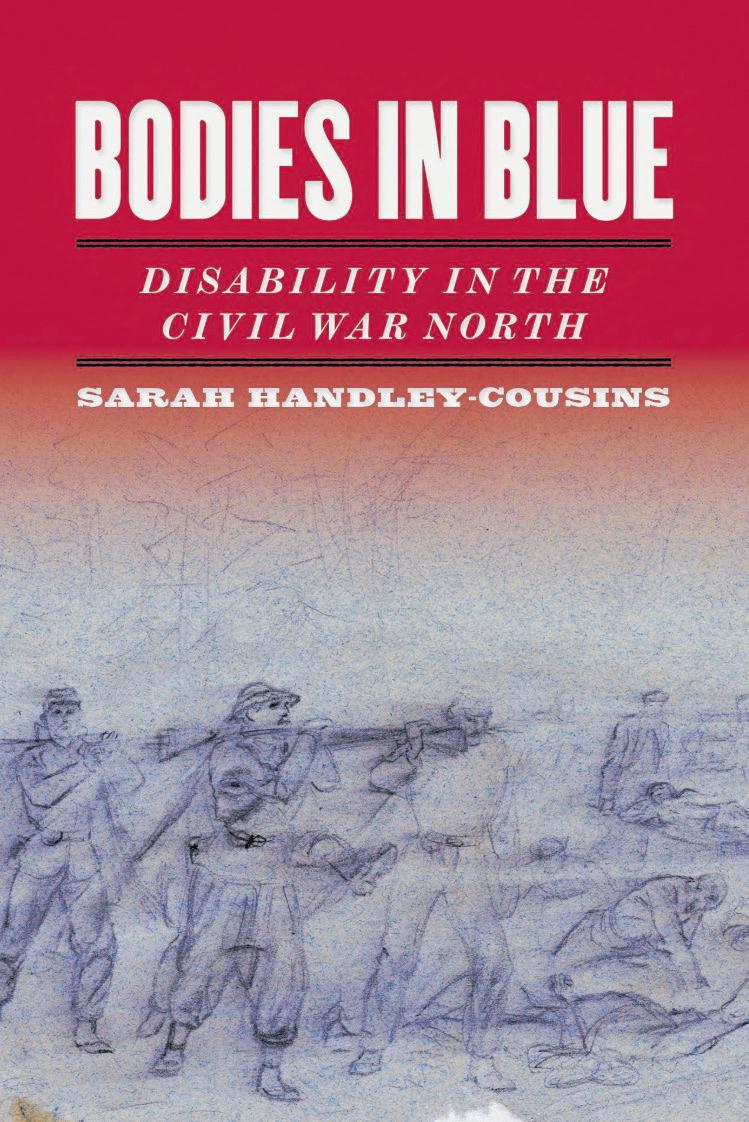
Reviewed by Paul Taylor
the reader a broader social and cultural understanding than heretofore of war-related disabilities in the Civil War North; an understanding that goes well beyond amputations for that obviously visual wound did not raise the same questions about legitimacy and manliness as less clearcut injuries, whether physical or psychological.
Within each chapter, and by using specific cases culled from the war’s medical and pension records, she examines conditions that ranged from the physical and mental, temporary to chronic, as well as from illness to injury.
Major Study of America’s Major Memorials
Civil War Monuments and the Militarization of America
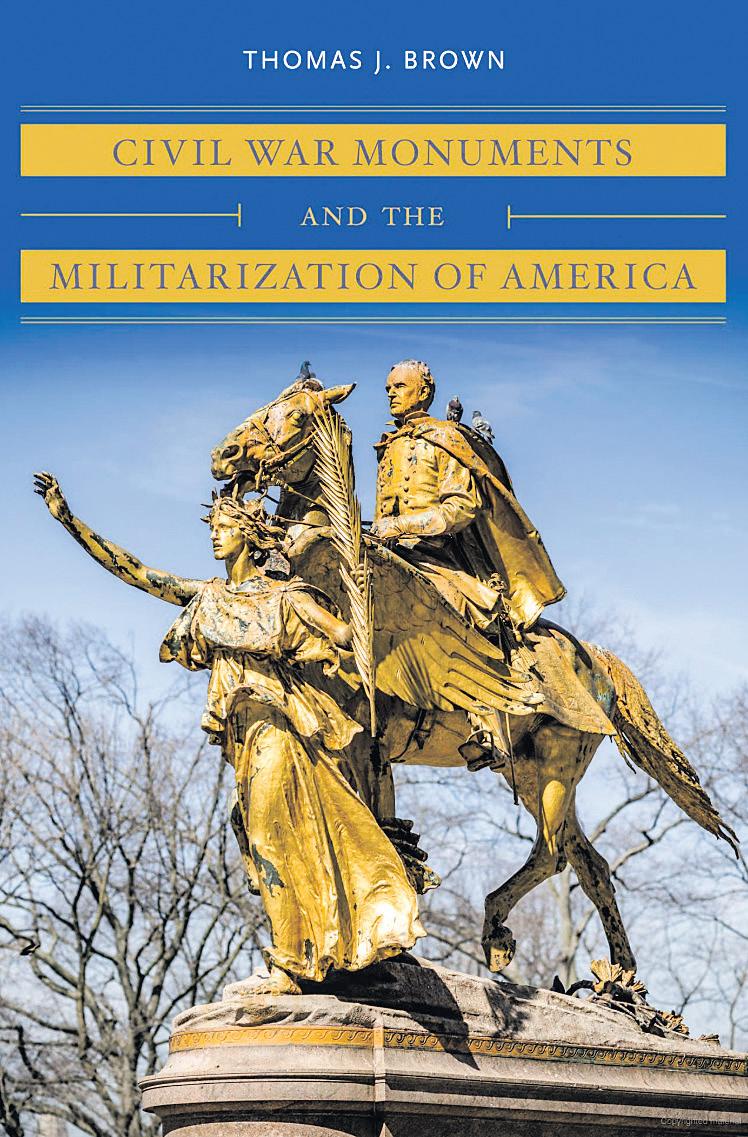
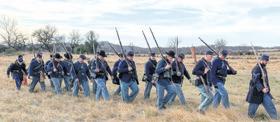

By Thomas J. Brown. Photos, endnotes, index, bibliography, 384 pp., 2019. The University of North Carolina Press, www.uncpress.org, $29.95 paperback.
Reviewed by Gould Hagler
As the physical characteristics varied, so did the messages they conveyed. Many, especially the early ones, were principally expressions of the profound grief felt by millions. Others praised the soldiers’ valor and were dedicated to the survivors as well as to the fallen. Some celebrated triumph; others praised and justified a cause that was lost. Some expressed thanks for peace and sectional reconciliation. A few contained an anti-war message.
monuments, erected in the last two or three decades, were the work of “defiant whites.” Not ordinary men from ordinary American towns who wished to honor their ordinary ancestors who fought and died, but “defiant whites.” Brown’s documentary research is very thorough, but nothing in the book indicates he has spoken with any of the people who built these monuments.
Any Civil War film or TV show that strives for historical accuracy always shows the horrors of a field hospital limb amputation. From the safety of our living rooms, we, the viewers, are enthralled by the lack of sanitation and pain medication as we await the wounded soldier’s inevitable anguished cries. We wonder how those men could endure such agonies and their resulting disability. Within our collective consciousness, that missing limb is what comes to mind when we think of how a disabled Civil War soldier struggled quietly through life in the post-war years.
In Sarah Handley-Cousins’ absorbing new work on the nature of Civil War disability, she lays this fact out as a baseline, but then sets forth to explain how the war damaged men’s bodies and minds in a myriad of other, often-understudied ways. For example, the author examines what happened officially within government and then, culturally, within the soldier’s local society when he claimed to be disabled but bore no obvious physical scars. Furthermore, we learn how his claims played out within the era’s notions of what the author terms “martial masculinity” as well as the era’s definitions of honorable manhood. HandleyCousins explains how the era’s standards for martial masculinity dictated the proper manner in which a disabled warrior should behave. Men who failed this subjective cultural test garnered society’s opprobrium.
In this concise book’s six chapters, the author’s goal is to give
The author rightly considers illness to be within the parameters of disability. Soldiers who were seriously ill could not march or fight which thus disabled them, and circumscribed their utility to the military. The War Department even categorized serious illness as a disability and discharged men under that reason. Lastly, the Pension Bureau viewed the effects of debilitating illness to be a pensionable category. As the author points out, disability and illness were not synonymous, but neither were they mutually exclusive.
Disabled soldiers often faced an uphill battle in their fight for benefits. Despite the government’s lofty rhetoric about patriotic sacrifice, it often seemed that the primary goal of surgeons, officers, and civilian bureaucrats was to prevent disabled soldiers from becoming dependent “paupers,” which arose from the era’s ideas about what proper masculinity should entail. The result was that many ill or disabled Union soldiers became wholly at the mercy of the military justice system and medical authorities.
Both the pension bureau and the public became entangled in a bitter battle of mistrust.
In spite of a burgeoning Federal bureaucracy that, like today, often seemed to place fiscal savings over proper care of its wounded warriors, those men soldiered on, living lives as dignified and meaningful as their circumstances allowed. Kudos to Sarah Handley-Cousins for shining a bright light into a previously dark corner of Civil War history.
Paul Taylor is an award-winning author of seven books pertaining to the Civil War era. His forthcoming book is titled “My Dear Nelly”: The Selected Civil War Letters of General Orlando M. Poe to Eleanor Brent Poe and will be published by Kent State University Press.
In this carefully researched and well written work, University of South Carolina’s Thomas J. Brown offers readers a detailed survey of monument-building from the Civil War to the present.
The book’s five chapters and its epilogue contain in-depth discussion of these works of art and the changing American society that produced them. The many excellent photographs allow us to examine the memorials for ourselves and better comprehend their meaning.
Brown’s book focuses more on Northern memorials than on Southern ones, and is heavily weighted toward the grand works created by famous artists with names like French, SaintGaudens, and Borglum, works that were often part of grand civic spaces.
For the scores of memorials that are covered, readers are led from their genesis to their final completion and beyond. We learn about the visions of artists seeking the commissions; the organizations raising the money and picking the sculptors; and the verdicts of art critics and others with positive and negative views of the works.
The monuments, of course, took numerous artistic forms. There were statues of anonymous soldiers, military commanders (often mounted), civilian leaders, and allegorical figures. Other memorials took the form of obelisks, arches, fountains, pyramids, and a few “utilitarian” structures such as libraries.
Little of the book relates to the second part of the title, the militarization of America. There is no analytical discussion of this militarization, or even a definition. As the term has no single definition, the reader expects to be told what the author means, precisely, when he asserts that America was militarized, but this expectation is unmet. The book does not present a systematic argument connecting monument-building with militarization.
Sometimes issues of race and (less often) gender enter the discussion. No doubt these can be relevant questions. Even so, the author from time to time strains a bit. He writes that “The Newburyport [Massachusetts] statue signaled a deepening concentration on race as the fundamental bond between the community and its armed champions.” Three paragraphs later this same point is repeated. The bronze soldier looks like the flesh-and-blood soldiers who left Newburyport for war. That is to say, he is white. Is this in any way remarkable? Is the author over-interpreting? Sometimes a cigar is just a cigar.
In the book’s epilogue, “Toward a New Iconoclasm,” Brown presents an account of recent controversies that have resulted in the removal, by his count, of 33 Confederate monuments in 23 communities. For the most part this discussion is straightforward and objective. However, there are signs of subtle bias. One sentence reads: “This iconoclasm indicated that ordinary Americans who sacrificed their lives at the call of the state were morally wrong.” Does this iconoclasm so indicate? Or does it rather indicate that the icon-breakers held this opinion about the soldiers’ actions? There is a difference.
In the same epilogue we read that the recent Confederate
The author skillfully weaves the myriad elements of this complex story into a learned—and highly readable—narrative through which we journey from the 1860s to the present day. As we travel we discover much about the ways Americans have remembered the Civil War and how remembrance has changed over the decades.

Finally, I like a book that sends me to the dictionary. “Filiopietistic,” “choragic,” “diaphanous,” “himation,” and “pasquinade” are now part of my lexicon. But “quadrigia”? How does this medical condition, which results in the inability to bend a finger, relate to Civil War monuments? Ahhh, it’s a (tiny and uncharacteristic) typo, I learned as I kept searching; a “quadriga” is a fine thing to put on a monument, if you can afford it.
Gould Hagler is a retired lobbyist living in Dunwoody, Ga. He is a past president of the Atlanta Civil War Round Table and the author of Georgia’s Confederate Monuments: In Honor of a Fallen Nation, published by Mercer University Press in 2014. Hagler speaks frequently on this topic and others related to different aspects of the Civil War and has been a regular contributor to CWN since 2016. He can be reached at gould.hagler@gmail.com.
39 March 2020 Civil War News Subscribe at CivilWarNews.com Want To Advertise In Civil War News? Email us at ads@civilwarnews.com Call 800-777-1862 CW N Vol. 46, No. 48 Pages, January 2020 $3.50 Civil War News America’s Monthly Newspaper For Civil War Enthusiasts Inside this issue: 14 Through The Lens H Day Remembrance Day, 2019, GettysburgThe world will little note, nor long remember what we say here, but it can never forget what they did here. –and units by conducting marchgraves occurs each year, as well.tors are down from its 2000 peak were about 50,000 Civil War re--Teacher Don Mullen, portrays (Garry Adelman, American Members of the 14th Brooklyn carry the uniform of Frank Santella in Remembrance Day parade. (Todd Welsh)

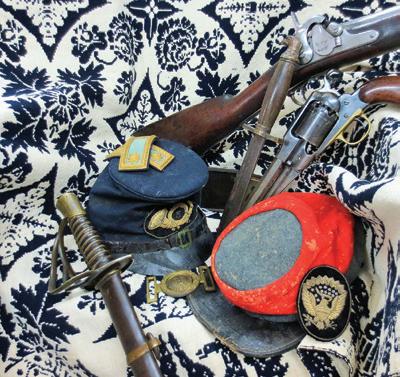

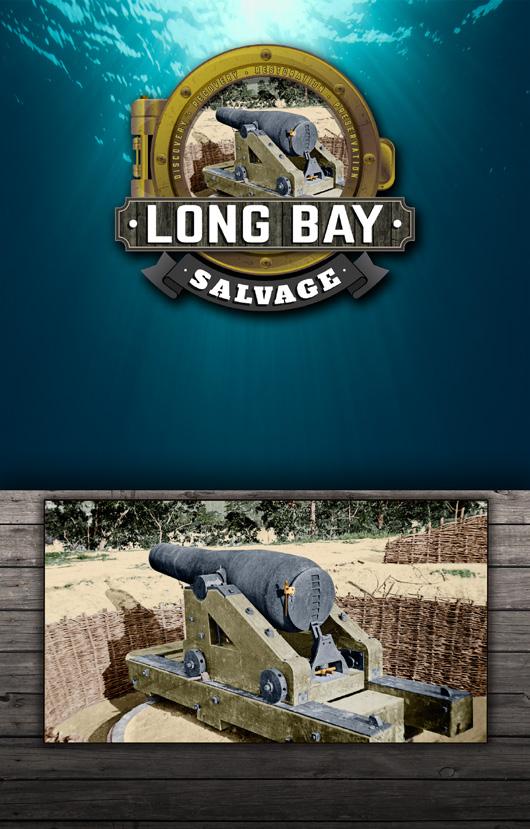

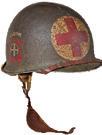



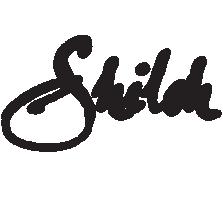







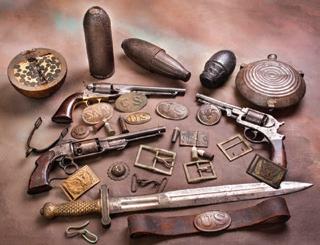

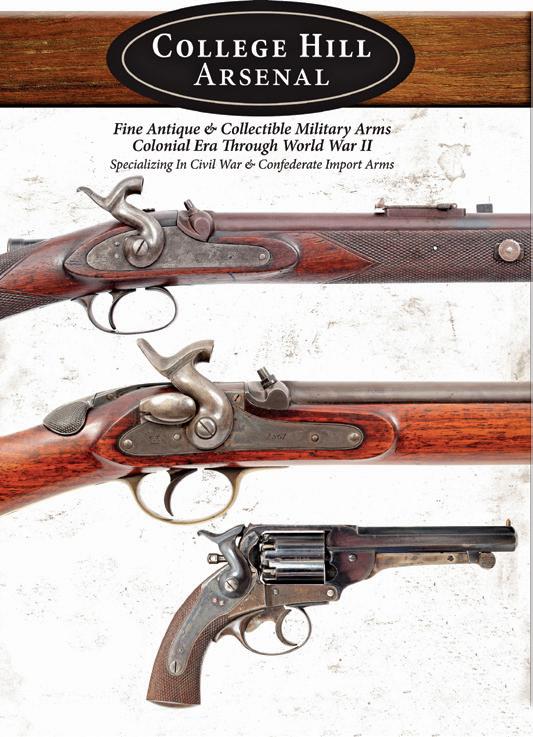

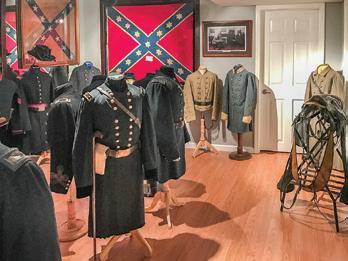

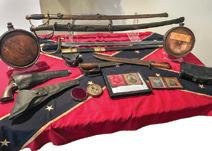


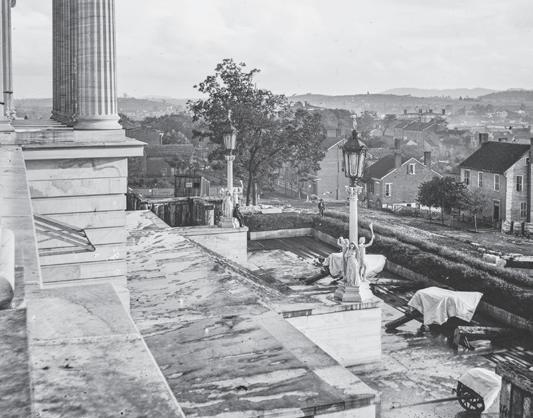

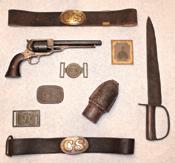
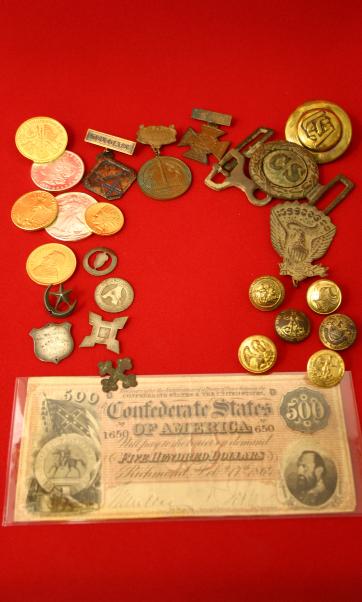
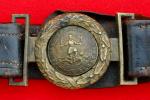




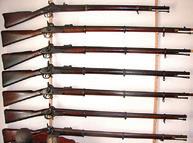









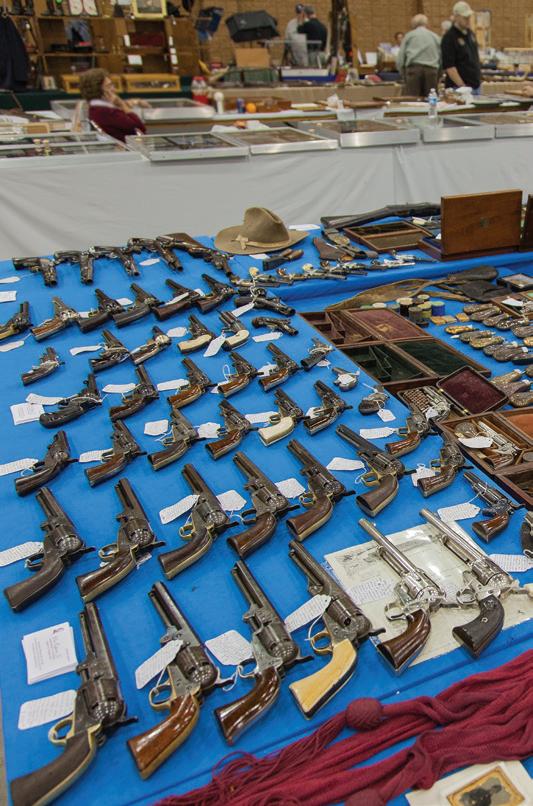


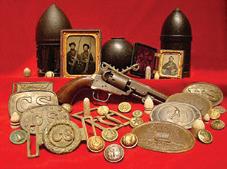


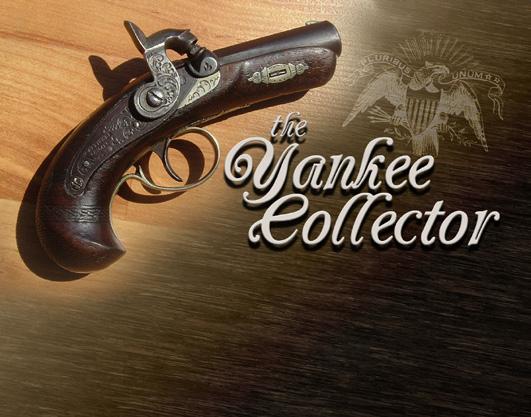



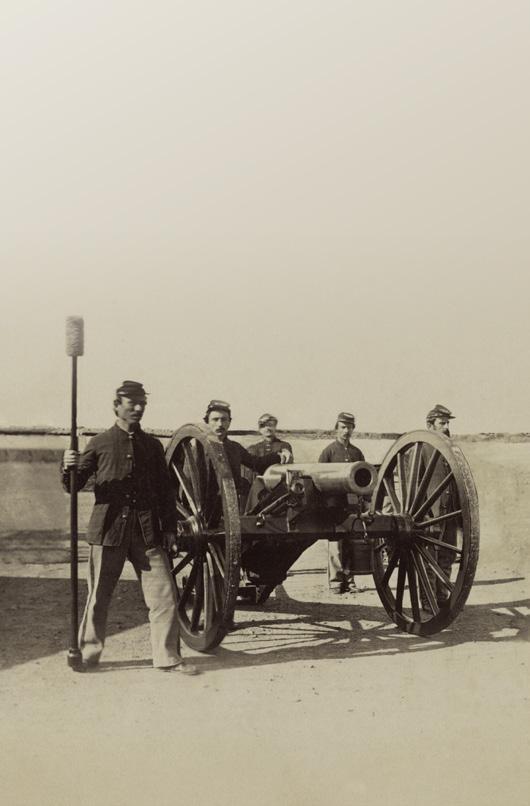

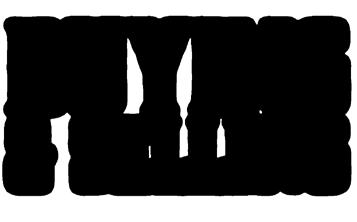



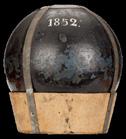





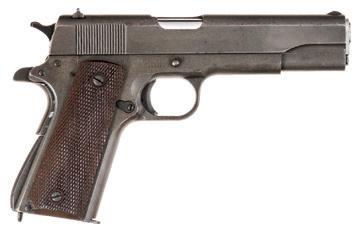







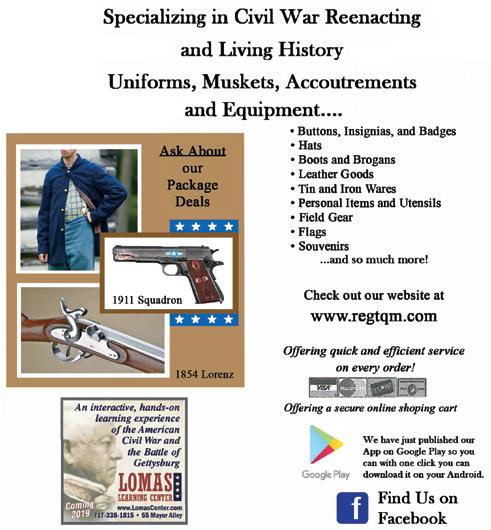
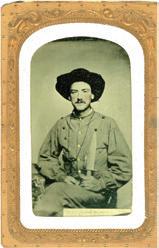


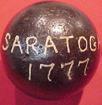

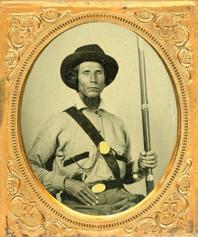

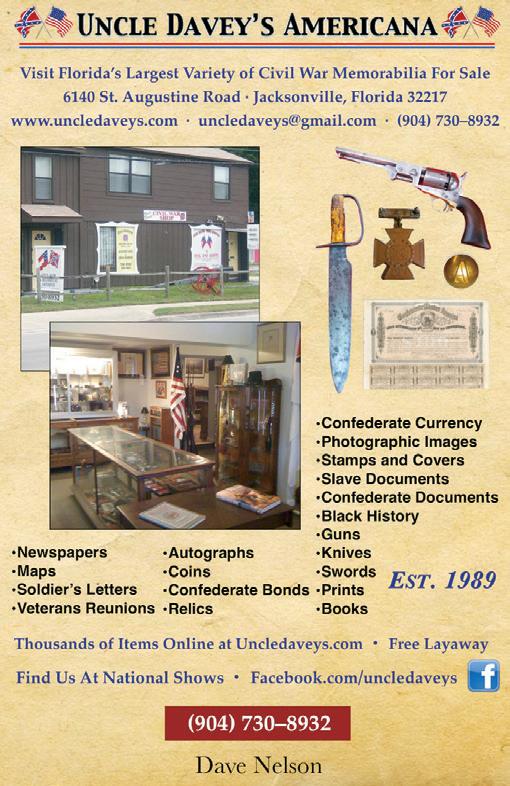


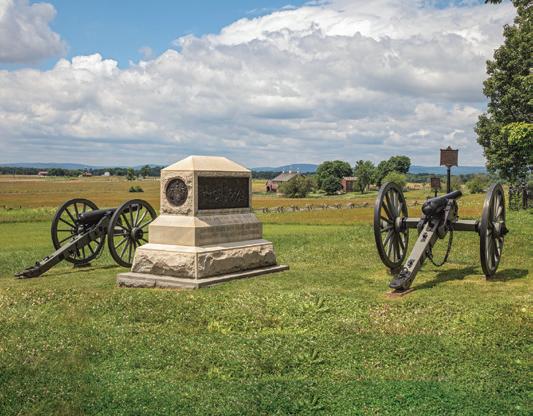
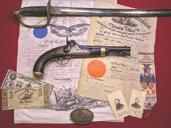














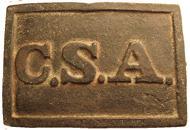







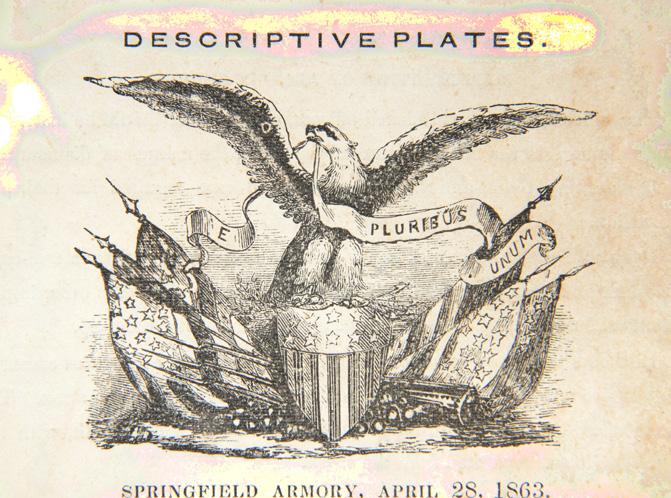






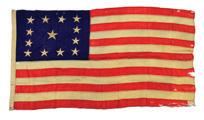




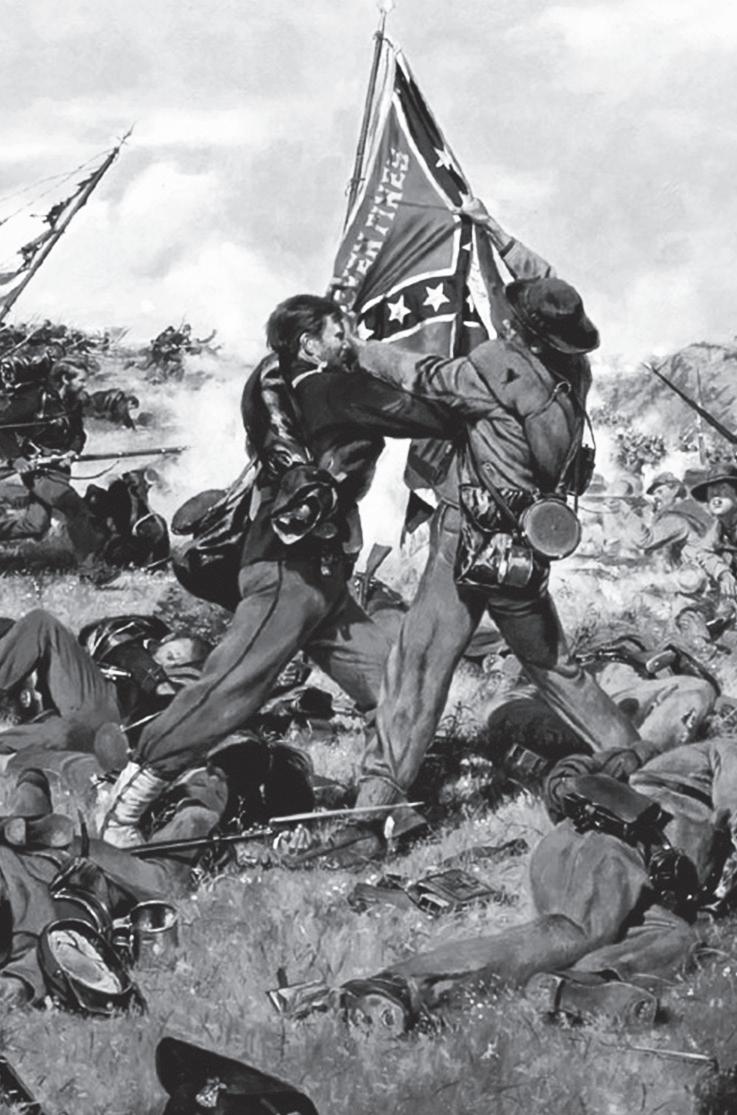




40 Civil War News March 2020 CivilWarShop.com Offering the Finest Investment Grade Military Memorabilia since 1981 Buy – Sell – Trade Certified Appraisal Services Life Member Company of Military Historians Lynn and Will Gorges, Proprietors 3910 US Hwy. 70 East New Bern, NC 28560 (252) 636-3039 • civilwarshop@gmail.com www.CivilWarShop.com Long Bay Salvage LLC specializes in the recovery and restoration of authentic Civil War Cannon with an emphasis on 10-Inch Columbiads, what has become a rare piece of Civil War history. Long Bay Salvage also works with historical entities (government and private) to recover and conserve large historical artifacts with a specialty in large field and naval artillery pieces. Glenn Dutton 770-351-7565 Rufus Perdue Perdue 843-315-9818 PLEASE CONTACT US FOR MORE INFORMATION www.LongBaySalvage.com Promoters of Quality Shows for Shooters, Collectors, Civil War and Militaria Enthusiasts Military Collectible & Gun & Knife Shows Presents The Finest Mike Kent and Associates, LLC • PO Box 685 • Monroe, GA 30655 (770) 630-7296 • Mike@MKShows.com • www.MKShows.com Northwest Georgia Trade Center 2211 Dug Gap Battle Road Dalton, GA 30720 February 1 & 2, 2020 Chickamauga (Dalton) Civil War Show Williamson County Ag Expo Park 4215 Long Lane Franklin, TN 37064 December 5 & 6, 2020 Middle TN (Franklin) Civil War Show l Shiloh Buying & Selling Authentic Civil War Artifacts 2405 Oak Grove Road Savannah, TN 38372 731-438-3541 ShilohRelics.com History@shilohrelics.com owner Rafael Eledge .com Dealing in the Finest Authentic Militaria Since 1995 with an Emphasis on the American Civil War Pistols, Muskets, Carbines, Rifles, Bayonets, Swords, Uniforms, Headgear, Belt Buckles, Cannon, Buttons, Bullets, Artillery Implements Etc. MidWestCivilWarRelics.com Bowie Knifes, Civil War Swords, Confederate D-guards, Antique Firearms, Dug Relics, Buckles & Belts, Identified Relics, Letters, Documents, Images, Currency, Uniforms, Head Gear & Flags. 3500 Shacklett Rd • Murfreesboro, TN 37129 tom@stonesrivertrading.com • (615) 336-2188 StonesRiverTrading.com Tom Hays Proprietor We carry all types of relics, dug & non-dug, Confederate & Federal. 100% Guaranteed. A strong emphasis on dug relics, but also a full line of non-dug relics of all types. Over 30 years experience with a full time, online store since 1997. We also have a shop located five miles from Stones River National Battlefield that is open by appointment. www.CollegeHillArsenal.com Tim Prince College Hill Arsenal PO Box 178204 Nashville, TN 37217 615-972-2418 Mid West Civil War Relics MidWestCivilWarRelics.com Allen Wandling Phone: 618-789-5751 Email: awandling1@gmail.com Museum Quality Civil War Union & Confederate Artifacts! We handle the Best Antique Bowie Knifes, Civil War Swords, Confederate D-guards, Antique Firearms, Dug Relics, Buckles & Belts, Identified Relics, Letters, Documents, Images, Currency, Uniforms, Head Gear & Flags. Preston Bain Nashville, TN (615) 397-5186 www.NashvilleRelics.com Nashville Civil War Relics “Old times there are not forgotten” Coles Civil War Shop.com Come by and see me at the shop or place an order online. email hmcole2@comcast.net Mac Cole 13119 River’s Bend Blvd. Chester, Va 23836 wk - 804-681-0945 cell-804-314-9940 Hours Mon - Fri 10-5 Sat - 10-3 P.O. Box 342 Thompsons Station, TN 37179 615-585-0115 Email: brubon2@bellsouth.net Franklin Relics www.AmericanRelics.net Allen Phillips 1014 Reservoir St., Suite B Harrisonburg, VA 22801 A P.O. Box 342 Thompsons Station, TN 37179 615-585-0115 Email: brubon2@bellsouth.net Franklin Relics Specializing in Accoutrements, Edged Weapons, Firearms and Uniforms FranklinRelics.com Bruce Hohler Proprietor Specializing in Buttons, Buckles, Currency, Hat Devices and other Military Artifacts. www.AmericanRelics.net Allen Phillips 1014 Reservoir St., Suite B Harrisonburg, VA 22801 American Relics Phone: 540-476-1969 Email: americanrelicsnet@gmail.com www.CivilWarBadges.com Everitt Bowles, Owner • 770.926.1132 1036 Washington Avenue Woodstock, Georgia 30188 The Largest Selection of GAR & UCV Hundreds of Memorabilia Items from Rev War through Vietnam Secure & Easy Guaranteed Authenticity of Every Item Vin Caponi Historic Antiques Vin Caponi, Jr. 18 Broadway Malverne, NY 11565 Store: 516-593-3516 Cell: 516-353-3250 rampantcolt@aol.com http://www.vincaponi.com We carry a very large inventory of Colt and Civil War firearms including muskets, carbines, rifles and accoutrements. Our inventory of historic antiques and firearms begin at the early collectors level and range all the way up to the advanced 8895 Town and Country Circle • Knoxville, TN 37923 Phone: 865-693-3007 info@armyoftennesseerelics.com Civil War Artifacts Nick Periut Proprietor ArmyofTennesseeRelics.com Buying and Selling High Quality Images, Belt Buckles and Plates, Artillery Shells, rare Bullets and Buttons! Richard Gersten (708) 786-8630 PO BOX 31113, CHICAGO, ILLINOIS 60631 www.YankeeCollector.com Specializing in Early Americana, Civil War American Indian, Old West, WW I & II Guns, Swords & Memorabilia www.uniondb.com 34 York St Gettysburg, PA 17325 Phone: 717-334-2350 • Email: bsynnamon@gmail.com Specializing in Authentic Civil War Artifacts The Union DrUmmer Boy A Museum Where You Can Shop! Contact Glenn Dutton at: glennjdutton@aol.com or 770-351-7565 BUYING & SELLING Field & Heavy Artillery Cannon, Shells, Fuses & Etc. Rare Accoutrements Michael Simens HistoricalArms.com Tel: 440-744-9088 mail@HistoricalArms.net The Only Complete Beaumont-Adams CS Naval Rig Michael Simens HistoricalArms.com Tel: 440-744-9088 • mail@HistoricalArms.net Magnificent Swords Georgia Presentation To William J. Hardee. Later Confederate Lieut. General. We Buy, Sell, Authentic And Appraise World-Class Historical Artifacts Fine Antiques & Militaria Military Items 1650-1945 Armor Swords Firearms Bayonets Equipment Accoutrements www.csarms.com PO Box 602 9150 John S. Mosby Hwy. Upperville, Virginia 20185 Shop Phone: 540-592-7273 Email: sophiacsarms@aol.com C.S. Arms, Inc. Specialize in U.S. & British Militaria www.OldSouthAntiques.com Old South Antiques, THE CONFEDERATE Old South Antiques, LLC Hickory Hill Mansion, 9222 Wickham Manor Way, Ashland, VA 23005 CARSON SQUEEGIE JENKINS 321.505.7524 WWW.SQUEEGIE.NET DESIGN SERVICES PRINT MEDIA ILLUSTRATIONS PACKAGE DESIGN CORPORATE BRANDING PRINT & MAGAZINE ADS LOGO DESIGN TEXTILE/ T-SHIRTS BROCHURES EVENT POSTERS BUSINESS CARDS 3D RENDERINGS MARKETING NEW BUSINESS START-UP PACKAGES AVAILABLE The Historical Shop Margaret & Cary Delery Box 73244 Metairie, LA 70033 Phone: 504-467-2532 c.j.delery@att.net www.historicalshop.com Since 1978 selling rare Americana Historical Shop The e Early American items through the Civil War artifacts, autographs, photography, currency, bonds, historical displays, military items, and more…… P.O. Box 160 • Kingston, TN 37763 Phone: 803-431-1798 Email: vann@veteransattic.com www.VeteransAttic.com Vann Martin United Confederate Veterans, Grand Army of the Republic, Civil War Photographs and other Civil War items. David K. Parks Military Antiques PO Box 180674 Utica, MI 48318-0674 Phone: 586-871-6462 Email: dkpma@comcast.net Offering a large selection of Civil War and Historical Memorabilia ranging from the Revolutionary War to World War (emphasis on the American Civil War). On line catalog regularly offers over 700 items from nearly every category of collecting. www.RelicsOfHistory.com Civil War Military Longarms a Specialty ConfederateArmsCompany.com 1209 Victor II Blvd., Morgan City, La. 70380 Cell: 985-518-1802 • Email: leegray@LHprinting.com Lee Gray Confederate Arms Company PO Box 129 Dover, TN 37058 Buying & Selling: Images Artillery Firearms Dug Relics Edged Weapons Non-dug Artifacts John & Nikki Walsh Fort Donelson Relics FortDonelsonRelics.com Full Line Civil War Artifact Dealer Email: john@fortdonelsonrelics.com vann@veteransattic.com www.VeteransAttic.com United Confederate Veterans, Army of Republic, Civil War Photographs other Civil items. War and Historical Revolutionary War American Civil offers over 700 of collecting. www.RelicsOfHistory.com “Reproduction Antique Spectacles to suit all sights” Authentic reproduction Civil War era eyeglasses to fit your lifestyle. Historically accurate, ophthalmic quality eyeglass frames suitable for reading, distance, bifocals, progressive lenses, sunglasses & nonprescription tinted lenses. Made for full time wear. “Spectacles are most overlooked, most obvious way to spoil an otherwise fine impression.” Thomas Valenza, Optician When you are ready to complete your impression, visit us online for detailed information about our spectacles: www.HistoricEyeWearCompany.com Prices start at $139.95 862.812.4737 Unidentified Union soldier wearing oblong spectacles (Library of Congress) Above Right: Lieutenant Adam J. Slemmer, defender of Fort Pickens (U.S. Army Heritage & Education Center) The Best Civil War Era Spectacles Buying and Selling original Civil War Confederate & Union Buttons, Belt Buckles, and Accoutrements. NCCivilWarRelics.com PO Box 2122 Morehead City, NC 28557 Phone: 252-671-7770 Email: sales@nccivilwarrelics.com or AGaskins1@ec.rr.com Allen Gaskins North Carolina Civil War Relics Robert Jones • 119 Frances Ave. • Stanhope, NJ 07874 Phone: 973-810-2976 • Email: Bob33rd@optonline.net We sell original Civil War artifacts, both excavated and non-excavated. There is also a selection of mid-19th century antiques. Yankee Rebel Antiques www.YankeeRebelAntiques.com Proprietor, Robert Jones, is the author of seven books on Civil War subjects: The Civil War Canteen Civil War Artillery – A Pictorial Introduction Children at the Battle of Gettysburg –Their Unforgettable Summer The Civil War Canteen Second Edition, Battle of Gettysburg –The Relics, Artifacts & Souvenirs, The Civil War Soldier – His Personal Items, War Canteen – Third Edition He has also written articles for North/South Trader Civil War magazine. Order his books online at http://www.lulu.com/spotlight/civilwarbooks Promoters of Quality Shows for Shooters, Collectors, Civil War and Militaria Enthusiasts Military Collectible & Gun & Knife Shows Mike Kent and Associates, LLC • PO Box 685 Monroe, GA 30655 (770) 630-7296 • Mike@MKShows.com • www.MKShows.com February 1 & 2, 2020 Chickamauga (Dalton) Civil War Show November 14 & 15, 2020 Capital of the Confederacy Civil War Show December 5 & 6, 2020 Middle TN (Franklin) Civil War Show l l Firearms & Militaria Auctioneers or Better! On Expensive Items and Valuable %0 Seller’s Commission The Tradition Continues - New Facility, Same Family and Great Location We are pleased to announce the purchase of the former Auction Facility of World-Renowned Hall-of-Fame Auctioneer James Julia. climate controlled and secured space dedicated to the promotion, presentation and handling of fine firearms collections. Our Fall 2019 Firearm Auction generated nearly $5.5 Million in sales for our consignors - Our largest to date! Call our offices to be part of our next Premier Firearms Auction Consignments Now Being Accepted 199 Skowhegan Rd Fairfield, ME 04937 207-453-2114 civilwar@poulinauctions.com Website: poulinauctions.com Stephen Poulin, ME Lic 1115 Presentation Sword of Gettysburg Hero General Alpheus Williams (est. $20,000 30,000) Sold $41,125 Sold $41,125 Rigdon & Ansley Confederate Revolver Carried By Captain Luther M. Clements, Co. F, 41st Alabama (Est. $25,000-35,000) Unique 1864 Sold $7,635 Sold $41,710 Sold $36,425 Confederate Keen-Walker Brass Frame Breech Loading Percussion Carbine (Est. $20,000-30,000) Sold $23,500 Sold $23,500 Fine Cook & Brother Athens Georgia Confederate Percussion Carbine (Est. $20,000-25,000) ROCK ISLAND AUCTION COMPANY REAL ART REAL HISTORY REAL IRON Exceptional Springfield Armory Rare and Exceptional Double Cased Pair of Early Squareback Factory Engraved Colt 1860 Army Patriotic Lady Grip, Case and The 2020 Civil War Dealers Directory is out. To view or download a free copy visit: www.civilwardealers.com/dealers.htm The 2020 Civil War Dealers Directory is out. To view or download a free copy visit: www.civilwardealers.com/dealers.htm
The Inside Story of the 16th Michigan Infantry
The 16th Michigan Infantry Regiment In The Civil War: Revised and Updated. By Kim Crawford. Appendix, Notes, Bibliography, and Index, 404pp., 2019. Michigan State University Press, msupress.org.
 $40.95 Cloth.
$40.95 Cloth.
Reviewed by David Marshall
Visionary Leader or Curmudgeon?
The 16th Michigan Infantry Regiment was originally formed by Colonel Thomas Stockton and called Stockton’s Independent Regiment. The original controversy of this unit concerned that the founding officer had been a slave owner, was related by marriage to Confederate General James Longstreet, was a Democrat, and started by him over the protests of Michigan’s governor, Republican Austin Blair, even though President Abraham Lincoln wanted the Colonel to lead the regiment in the spring of 1861. These men were from places like Detroit, Saginaw, Lansing, and many other small towns and fought with the Army of the Potomac in many important battles and campaigns such as Gaines’ Mill, Second Bull Run, Gettysburg, The Overland Campaign, and was at the surrender of Gen. Robert E. Lee at Appomattox Court House.
The high point of the success of the 16th Michigan was on Little Round Top, July 2, 1863,
during the Battle of Gettysburg. Here, Crawford makes excellent points depicting a second significant controversy about this regiment. Lt. Col Welch and some men panicked when the Texans and Alabamians flanked them; instead of holding their ground as they had done in earlier battles, more than forty men departed without command, leaving an estimated 200 men while this crucial moment of the battle raged. While this happened Col. Patrick O’Rorke and the 140th New York, came to the assistance of the 16th Michigan in this brief and intense fight, O’Rorke was killed but the Confederates who had just outflanked the 16th Michigan now found themselves flanked. Additionally, the author points out that when the 16th Michigan’s line broke, their brigade commander, Colonel Strong Vincent, was moving toward them to halt their breaking from their line. At that moment he was hit by a bullet that struck him in the groin and fatally wounded him. If Welch had held his position, then all his men would have been viewed as heroes.
While Colonel Welch would pay with his at Popular Groves Church, or Peeble’s Farm, Va., on Sept. 30, 1864, redeeming his personal reputation, a kind of code of silence concerning what happened at Little Round Top was accepted by the regiment’s survivors. In the end, the regiment’s original Colonel Stockton never received his promotion to brigadier general but was successful in business and in life. One of the combatant’s youngest volunteers, George Sidman was issued the Medal of Honor on April 6, 1892. The surviving soldiers were extremely successful in politics and in business.
This book tells an exciting story from the start of the conflict until the war ended. Throughout his writing, Crawford constantly provides contextual analysis that supports revelations about the totality of the combatant’s experience. The collection of letters, journals, and memoirs, selected
and used throughout allows students and academics to walk in the shoes of the soldiers, relate to their experiences in camp, during marches, and in battle as well as better appreciating the decisions made in this struggle. Additionally, the author reveals the diversity of men who made practical decisions that allowed them to contribute to the Union cause.
The 16th Michigan Infantry In The Civil War was originally written in 2002 by Kim Crawford, then revised, updated and published by Michigan State University Press in 2019. It contains 88 helpful photographs and illustrations of the many brave men who fought with this regiment. The author provides a brief overview of the battles that these soldiers fought in, followed by an examination of these men’s contribution to the army’s success and failures. His vivid descriptions of the combat at Little Round Top held me spell-bound.
This is historical writing at its best. The writer takes the readers through the regiment’s entire term of service and on into the postwar years. This is a finely-crafted regimental history. I would have preferred to see a list of maps for easy reference. The roster is presented in a simple alphabetical order rather than the more standard company by company listing. Neither of these criticisms detracts from this fine history. The writing is entertaining, informative, and well sourced; after every chapter I wanted another. Additionally, it contains an important appendix with a roster of the 16th Michigan Infantry Regiment plus valuable notes, and an index. The author has used a huge variety of primary and secondary sources to provide a fantastic chronicle that relates the untold Civil War story of a Michigan regiment. Students and scholars will greatly appreciate the research and scholarship of this excellent writer. Expensive but worth the purchase.
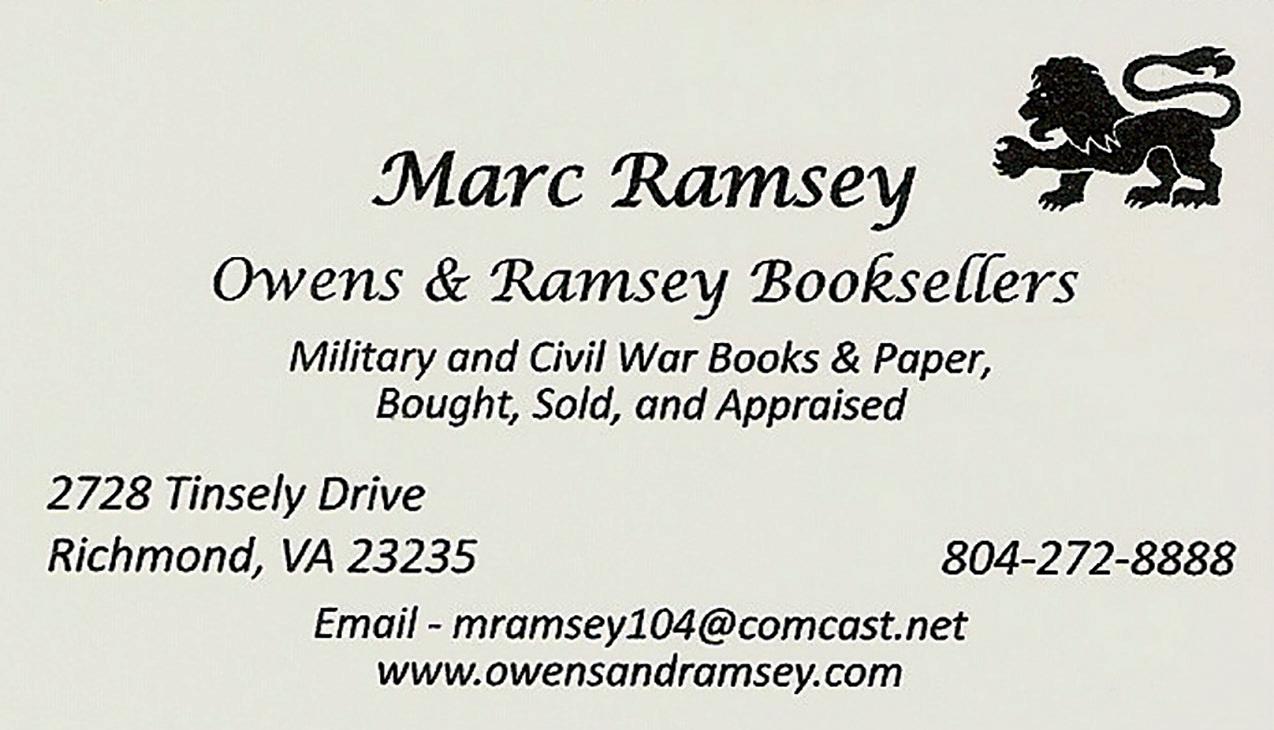
David Marshall is a high school American history teacher in the Miami-Dade School district for the past thirty-three years. A lifelong Civil War enthusiast, David is president of the Miami Civil War Round Table Book Club. In addition to numerous reviews in Civil War News and other publications, he has given presentations to Civil War Round Tables on Joshua Chamberlain, Ulysses S. Grant, Abraham Lincoln, the Battle of Gettysburg, and the Common Soldier.
The Life and Loves of Thaddeus Stevens. By Mark S. Singel. Illustrated, bibliography, index, 199 pp., Sunbury Press, 2019, $19.95 softcover.
 Reviewed by Wayne Wolf
Reviewed by Wayne Wolf
In this short volume, the author chronicles the life of Thaddeus Stevens of Pennsylvania, the fiery politician who was the uncompromising opponent of slavery and the apostle of equality for all men. From his earliest days on the Gettysburg City Council and as a new congressman representing the congressional district of President James Buchanan, he was viewed by his contemporaries as unwaveringly self-reliant, fiercely committed to his own moral compass, and consistently a defender of the disadvantaged and oppressed. But he was also a hater. He detested Masons, Southern plantation owners, and those who sought compromises to save the Union.
The focus of his crusading work was the promotion of equality and the abolition of the peculiar institution. This zeal earned him the labels of “The Old Commoner” and the “Scourge of the South.” His fanatical ideas, marked by passion and no compromise, were precisely the reason the South felt secession their only salvation after the election of Abraham Lincoln; a new President who even Thaddeus Stevens felt too soft on slavery.

Where did this passion come from? Two incidents that may have helped shape Stevens’ mission in life were the murder of Dinah, a pregnant mulatto woman in Gettysburg, and the possible consort of Stevens. The press of the day questioned his involvement in her murder and the stigma of his possible connection to this case lingered for decades. Secondly, his long-standing love affair with Lydia Hamilton Smith, Stevens housekeeper, a mulatto woman and probable common law wife. A much more complete analysis of these “loves” of Stevens can be found in Fawn Brodie’s Thaddeus Stevens—Scourge of the South. Here she characterizes Stevens’ indignation as serving him well, “instead of love, and a sense of injustice was his substitute for hope.” Stevens eventually saw his lifelong mission realized by the passage of the 13th and 14th Amendments, losing only the political battle to convict Andrew Johnson in his impeachment trial. Mark Sigel does a competent job of reviewing Thaddeus Stevens’ life, yet fails to provide more than a superficial rehashing of the highlights of his career. Brodie’s book is far more comprehensive as is also Richard Nelson Current’s Old Thad Stevens: A Story of Ambition. Two historical errors are present. Kentucky was not a “secesh” state but remained in the Union; President Andrew Johnson was from Tennessee not Kentucky. Additionally, the votes of Democratic senators to acquit Johnson in the impeachment trial are not mentioned. Despite these few shortcomings, the book can be recommended for those who want a cursory overview of Stevens’ life rather than true analysis or comprehensive answers.
Wayne L. Wolf is Professor Emeritus at South Suburban College, past president of the Lincoln-Davis Civil War Roundtable, and the author of numerous books and articles on the Civil War. His current research is lost letters that reveal the intimacies of a soldier’s life.
41 March 2020 Civil War News Loyal Legion of the Confederacy CSA National Defense Medals & other banned internet items Civil War Recreations WWW.CWMEDALS.COM cwmedals@yahoo.com 1 Smithbridge Rd., Unit 61, Chester Heights, PA 19017
The Search Continues
Prologue to Change: African Americans in Medicine in the Civil War Era, by Robert G. Slawson,
MD.
Bibliography and Index. 50 pp., The NMCWM Press, $14.95 softcover.
Reviewed by Meg Groeling
healers properly within their time. Medical training was scarce under the best of circumstances, and many of these men trained in colleges that no longer exist or whose records have disappeared altogether. Gleaning information from official records, diaries, letters, and newspaper accounts, Slawson teases forth the stories of these unusual people. Some had diplomas, some experience.
More educated than their African American peers, many were also involved in anti-slavery and abolitionist societies. Some do not even have images to reproduce.
Collection of Letters Give Detailed View of Illinois Soldiers’ Experiences
In Their Letters, In Their Words: Illinois Civil War Soldiers Write Home. Edited by Mark Flotow. Maps, photos, notes, appendices, index. 302 pp. Southern Illinois University Press, 2019. www.siupress.siu. edu. $26.50.

Reviewed by Jonathan W. White
Every historian knows that, without reprints, we would all be floundering around waiting for digital copies or wringing our hands in frustration. We are lucky to live in a time of almost instant reproduction of primary sources and the quick turnaround of print-on-demand. Dr. Robert G. Slawson’s Prologue to Change: African Americans in Medicine in the Civil War Era is one of the treasures that has returned to readers through the reprint process.
Initially released in 2006, Slawson’s book has been reprinted by the National Museum of Civil War Medicine (NMCWM) as part of their ongoing effort to return to the public valuable and exciting parts of Civil War medical history. The information Prologue contains has been enlarged upon since the first printing. What little is there, compared to other books about Civil War surgeons, truly highlights the difficulty inherent in obtaining information about the contributions made by black men during the war.
Thirteen professionals have been established as definitely belonging to the Union army in a medical capacity. Author Slawson provides a brief history of medicine to place these

One by one, each man is highlighted: known medical school graduates, possible medical school graduates, doctors without a degree, those who became commissioned officers in the Union Army where the rank of a surgeon was Major, and those who served as contract surgeons. Remarkably, a small window into African-American life opens. The reader is introduced to individuals who “against overwhelming odds and restrictions made personal accomplishments and contributions to society.” according to Carl W. Mansfield, MD, FACR, FACNM, in his Foreward. What makes this short book so surprising is putting it into context. So little work has been done on medicine in the Civil War compared with military and social topics that the subject alone makes this book a rarity. When added in that this book examines the lives of black men who have beaten almost every odd and still managed to remain unknown should, for every reader, deepen the appreciation of the rediscovery of these rare few.
This book should never again go out of print.
Meg Groeling received her Masters degree in Military History, with a Civil War emphasis, in 2016, from American Public University. Savas Beatie published her first book, The Aftermath of Battle: The Burial of the Civil War Dead, in the fall of 2015, and she has written First Fallen: the Life of Colonel Elmer Ellsworth, which Savas Beatie has contracted for publication sometime within the 2020-2021. She is a regular contributor to the blog Emerging Civil War.
In Their Letters, In Their Words is a wonderful book; I wish it had been in print when I was working on my own books about common soldiers (one on their dreams, and one on their views of emancipation). Editor Mark Flotow has pulled together a remarkable collection of excerpts from Illinois soldiers’ letters describing nearly every aspect of their experience during the Civil War, sleeping and eating, combat, prison life, disease, drill and discipline, camp life, encounters with southern civilians (both white and black), and more. Buried within the letters are engaging stories, such as when Union soldiers found a piano in abandoned Confederate earthworks near Jackson, Miss. Very few letters are published in their entirety. Instead, the editor reproduces excerpts from letters written by 165 soldiers and sailors, organizing the excerpts into topical chapters that cover various aspects of military service. Some excerpts are only a few words, while others run a page or more. Most range from a couple of sentences to a paragraph. The editor provides brief background information with each excerpt, such as the name, regiment, and home county of the author; the name and relationship of the recipient; and when and where the letter was written. An appendix provides a brief biography of each soldier-author.
The correspondence provides pointed commentary on politics
and the war. Much of what they wrote will be familiar to readers of Civil War News, but their uncensored language can be poignant. Wrote one soldier stationed near Cairo, Illinois: “I dont think I can get use to this nasty river water it is so yellow it looks like Piss and tastes worse I have had the Military Shits for a day or two and feel weak.” Another soldier described how the girls of his community encouraged enlistments. One young lady called upon a man she “used to go and see” and “asked him to put down his name. fancy the poor fellow as he hung between yes and no but the former did come and who could have refused a girl they loved.” The soldier then added, “not I.” Another soldier expressed his deep infatuation for a southern belle in 1861 but three years later wrote, “there are some Lovely young Ladies here but I have lost all my former (Love) for that class of God’s Creation.”
While the organization of the book enables readers to look for writings on particular subjects, it also has its drawbacks. Sometimes the excerpts are repetitive. It can also be difficult to feel like you are getting to know any of the soldiers well because their words are spread out throughout the volume. When I came upon particularly captivating excerpts, I often found myself thumbing through the index to locate other writings by the same soldier.
At times, essential context is missing because of how the letters have been split apart into multiple excerpts. For example, on Oct. 31, 1864, one soldier wrote
his brother, “You must be for the Union or against it.” This letter appears in Chapter 2 (“Illinois Citizens Become Soldiers”). Upon reading it, one recognizes that the letter must be about the presidential election of 1864, just over a week away. But in order to understand the excerpt, one must check the index and find other pages with excerpts from the same soldier. It turns out that other portions of the same letter appear in two separate places in Chapter 8 (“Officers, Generals, and ‘Old Abe’”). The second excerpt gives the soldier’s views of Gen. William T. Sherman. Finally, in the third excerpt the reader finds the soldier’s views of Lincoln and the presidential election. These excerpts should not have been separated, they clearly belong together.
Most of the penmen were ordinary soldiers and are completely unknown today. Taken together, their writings offer a wonderful social history of the Civil War and will be essential reading for anyone working on common soldiers. The book is also recommended for undergraduate courses on the Civil War.

Jonathan W. White is associate professor of American Studies at Christopher Newport University and is the author or editor of ten books, including Midnight in America: Darkness, Sleep, and Dreams during the Civil War (2017) and “Our Little Monitor”: The Greatest Invention of the Civil War (2018), co-authored with Anna Gibson Holloway. Visit his website at www.jonathanwhite.org.
Deadline for submissions and advertising is the 20th of each month for the following CWN issue.
Civil War Artillery Book
42 Civil War News March 2020 Digital Issues of CWN are available by subscription alone or with print plus CWN archives at CivilWarNews.com
New 392 page, full-color book, Civil War Artillery Projectiles –The Half Shell Book. For more information and how to order visit the website www. ArtillerymanMagazine.com or call 800-777-1862. $89.95 + $8 media mail for the standard edition.
Before making plans to attend any event contact the event host. Deadlines for Advertising, Editorial or Events Submissions is the 20th of each month.
We strive to add all events submitted to us but do not guarantee that your event will be published. There is a 100 word maximum for each event. Email events to: ads@civilwarnews.com

Feb. 22-23, South Carolina. Reenactment
The Battle of Aiken reenactment will take place at 1210 Powell Pond Road, Aiken. Camps and demonstrations all weekend with battles each day. $15/ adult. For information; battleofaiken.org.
March 6-7, Mississippi. Midsouth Military History and Civil War Show

The 53rd annual show and sale will be held at a new location in 2020 at I-55 & Church Rd. in Southhaven, just 15 minutes from downtown Memphis. Admission is $10, kids 12 and under free. For information; MidsouthMilitaryHistory@gmail.com or 901-832-4708.


March 7, Pennsylvania. Civil War Lecture
Join us for a lecture on South Mountain Communities during the Civil War, at the Shippensburg Historical Society, 52 W. King St., Shippensburg. 10 a.m. Free, donations welcome. For Information; shippensburghistoricalsociety.org
March 21, Pennsylvania. Preservation Luncheon

Author Bradley Gottfried will speak on “The Days in the Saddle: The Cavalry at Gettysburg” at the Grand Army Museum, 9130 Academy Rd., Philadelphia, Pa. 19114 For reservations or information; garmuslib@verizon.net or 215-289-6484.
March 21-22, North Carolina. Reenactment
Bentonville Battlefield State Historic Site is host to the largest reenactment held in the state of North Carolina every five years. Visitors will learn about the battle that happened Mar. 19-21, 1865, which was the last major Confederate offensive in the war as Gen. Joseph Johnston fought the advancement of Gen. Sherman’s march across the South. Included are many free programs and 2 reenactments which are ticketed events. For tickets, schedule of events and more information; 910-594-0789 or https://www.johnstoncountync.org/155th-bentonville-reenactment.
March 28, Virginia. Civil War History at the Virginia Museum of Civil War
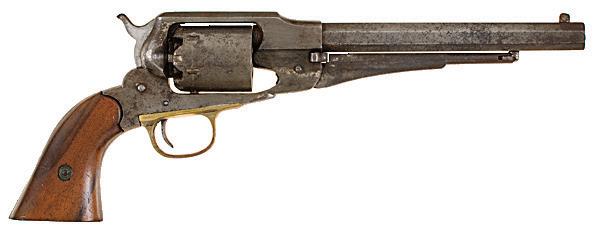



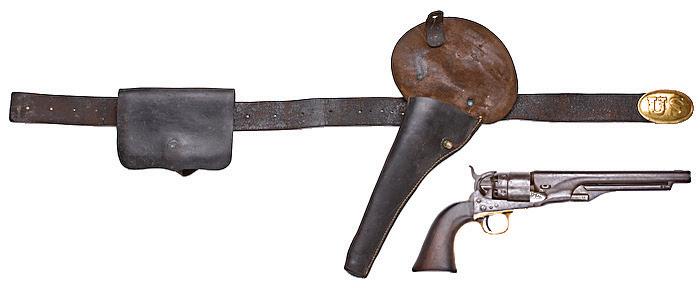
Family fun, exploration and hands on activities for all ages. Learn Army drills, dance the Virginia Reel, enjoy 19thcentury games and crafts and take a guided tour through the battlefield and so much more. Visit General Grant’s Store for books and souvenirs. Special event rate: $5, pre-registration open Jan. 27 through March 20 required for participation. For information; 866-515-1864.
April 2-4, Georgia. GBSHHA Congress
The General Barton Stovall History & Heritage Association will be holding their 19th annual Congress in Cartersville, Georgia. The event features two days of battlefield tours, a historian night, and a banquet. Information about the Congress is at www.generalbartonandstovall.com.
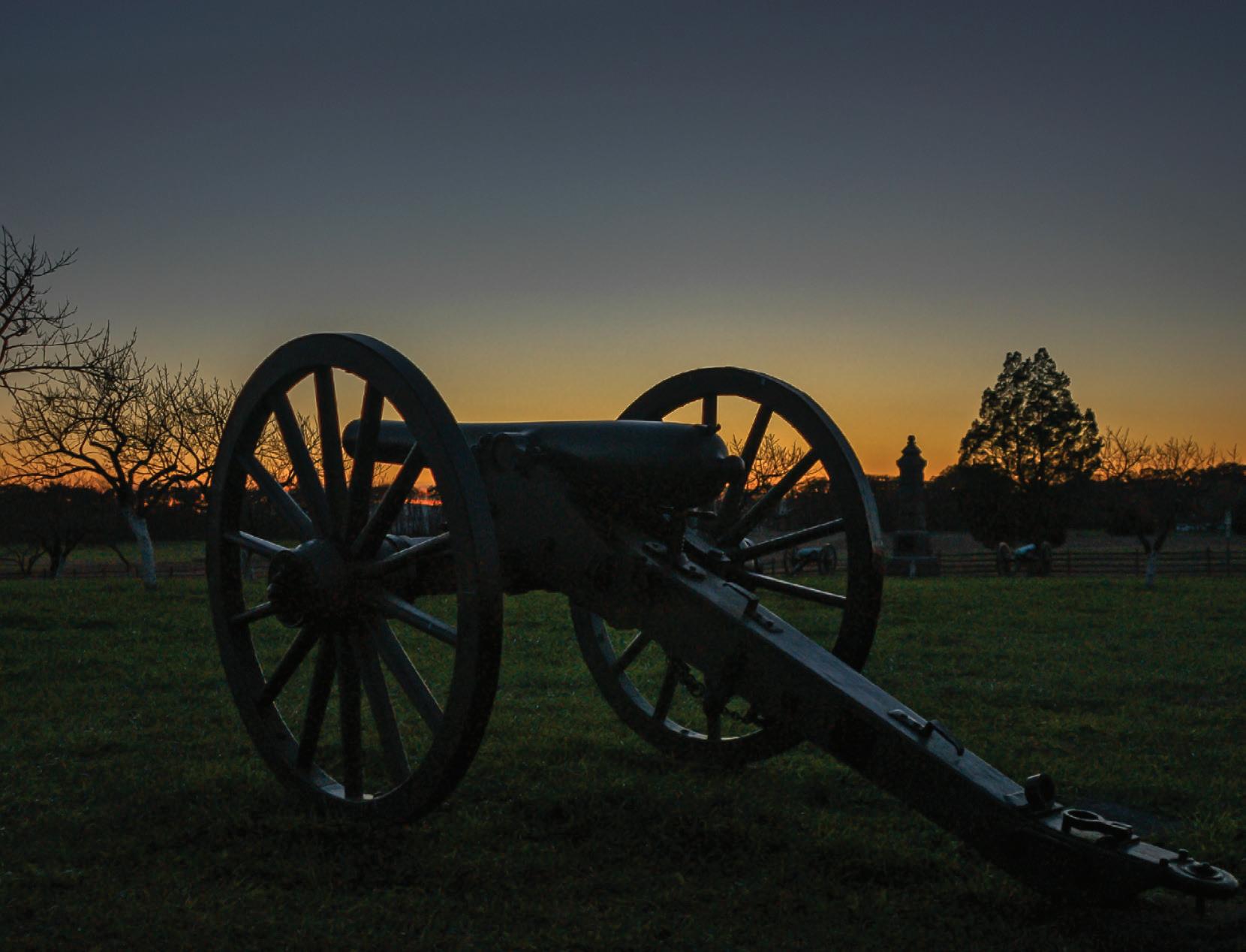
April 3-5, Maryland. Civil War Conference
“Lincoln Assassination Studies: Snapshots from the Big Picture,” 21st Annual Conference. Tours and lectures sponsored by the Surratt Society, in Clinton. $225, tours priced separately. For information; surrattmuseum.org
April 4, All States. Park Day. Sponsored by the American Battlefield Trust

Annual volunteer cleanup and repair at Civil War sites across the country. For information; battlefields.org/events/ park-day.

April 4, Virginia. Shenandoah University’s McCormick Civil War Institute in Winchester
The McCormick Civil War Institute will host its 2020 Spring Conference from 9 a.m. - 4 p.m. “The Civil War on the
Join Chambersburg Civil War Seminars & Tours for the largest and most comprehensive study of the Chickamauga & Chattanooga campaigns yet attempted! Five expert historians will cover diverse topics along with four full days of intensive battlefield touring led by David Powell with program coordinator Eric Wittenberg. We’ll visit Bridgeport and Stevenson, AL; LaFayette, GA, Davis’s Crossroads, Chickamauga, Reed’s Bridge, Jay’s Mill, Brock Field, Kelly Field, Brotherton Field, Horseshoe Ridge, Lookout Mountain, National Cemetery, Orchard Knob, Ringgold & more!
July
April
43 March 2020 Civil War News
Call for a FREE Brochure! 717-264-7101 ext. 206
Upcoming Conference 1777 Philadelphia Campaign
GATEWAY TO THE DEEP SOUTH: Chickamauga & Chattanooga
30-May 3, 2020 Limited seating!
Carolina
Civil War Period Arms & Equipment Michael Dyches www.CarolinaAntiqueArms.com Phone: 864-871-5325 Email: mdyches.ogma@gmail.com
22-26, 2020 Based in Ringgold, GA www.CivilWarSeminars.org
Antique Arms
Water.” Featuring nationally recognized Civil War scholars John M. Coski, Anna Gibson Holloway, Karen Needles, Jonathan W. White and Jonathan A. Noyalas (Shenandoah University). Registration fee of $50 ($25 for students with valid id) covers all presentations and lunch. For information or to register visit www.su.edu/MCWI, or call 540-665-4501, or email jnoyalas01@su.edu.
April 5, Pennsylvania. Symposium
Annual Meade Society History Symposium at the Conservatory at West Laurel Hill Cemetery, Bala Cynwyd, Pa. at 12 p.m. Speakers on the topic – The War with Mexico; Training Ground of the Civil War. Contact: Jerry McCormick 215-848-7753; or gedwinmc@msn.com.
April 23-26, New Jersey. Company of Military Historians Meeting
The 2020 meeting, held at the Crowne Plaza-Princeton, 900 Scudders Mill Rd., Plainsboro, NJ., will begin with the welcome reception on Thursday followed by a field trip to visit Washington’s Crossing, the Old Barracks Museum and Princeton Battlefield on Friday. Nine lectures covering many periods of American military history and material culture along with a 20-table exhibit / flea market room and expanded silent auction. Register online at: https://tinyurl.com/register-4-CMH2020. For more information; lesandjuanita1@hushmail.com, 845-754-8827.
April 24-26, North Carolina. Confederate Prison Symposium
23rd Annual Salisbury Confederate Prison Symposium sponsored by the Robert F. Hoke Chapter 78, United Daughters of the Confederacy. Event begins Fri. afternoon with 3 lectures, displays, Friendship Banquet, music, and recognition of veterans. Registration $70 per person when postmarked by April 3, $80 afterwards. $15 charge for refunds after April 10. No refunds after April 17. Mail checks to Robert F. Hoke Chapter 78, UDC, PO Box 83, Salisbury, NC 28145-0083. For information; Sue Curtis 704-637-6411, southpawsagain@gmail.com.
April 24-26, Virginia. Central Virginia Battlefields Trust’s Annual Conference
“First Days - A Focused Look at the opening days of combat at Fredericksburg, Chancellorsville, Wilderness, & Spotsylvania Battlefields”
Registration and Details: https://www.cvbt.org/cvbt-annual-conference
Join CVBT for a three-day event (or pick and choose which tours to attend) as we explore “the firsts” at the battlefields where we focus our preservation efforts. Historians Frank O’Reilly, Greg Mertz, Kristopher D. White, Chris Mackowski, and Chris Kolakowski will be leading tours and presentations!
April 25, Illinois. Civil War Show and Sale
Zurko Promotions presents The National Civil War Collectors Spring Show and Sale which will be held at the DuPage County Fairgrounds in Wheaton. Hours: 9 a.m. to 4 p.m. Admission is $9, Free parking. For information; www.chicagocivilwarshow.com.
April 25-26, Indiana. Sassafras Tea Festival & Civil War Living History
Sponsored by the Jennings County Historical Society. Two days of reenactments, mock battles, Blue Grey Ball, first person interpreters, night firing, working blacksmith shop and more. Open Sat. 9 a.m. to 5 p.m.; Sunday 9 a.m. to 4 p.m. For information; jenninghistoricalsociety@gmail. com or call 812-346-8989.
May 1-2, Gettysburg. Spring Seminar
The Association of Licensed Battlefield Guides of Gettysburg will offer its Spring Seminar. “ Overlooked and Often Not Visited: Ridges, Farms, and Other Sites”, including Battle of Hunterstown, Bliss Farm, and much more. For information; 717-337-1709 or https://gettysburgtourguides.org.
May 2-3, Ohio. Civil War Show and Sale
The 43rd Annual Show in Mansfield at the Richland County Fairgrounds. Friday dealer setup. One of the most impressive artillery living history displays you will ever see. Living history units representing Rev war through WWII. Over 750 tables. Admission is $7, kids under 12 free. For information; email: info@ohiocivilwarshow.com or visit www.ohiocivilwarshow.com.
May 15-17, Georgia. Reenactment
The 156th Anniversary “Battle of Resaca” reenactment will be held on over 650 acres of the original battlefield. Camping allowed in or near the breastworks. Amenities include straw, hay and firewood; food and ice on site. The planned activities include main battles both days at 2 p.m., period dance, medical demo’s, and more. A portion of the proceeds will be donated to the preservation efforts of the Friends of Resaca Battlefield, Inc. A $150 bounty will be paid to the first fourteen cannon and crews registered by May 1st. Reenactor registration fee is $10 due by May 1. For more information, www. georgiadivision.org or Battle of Resaca, P.O. Box 0919, Resaca, GA 30735.
May 15, Virginia. Director’s Guided Battlefield Tour
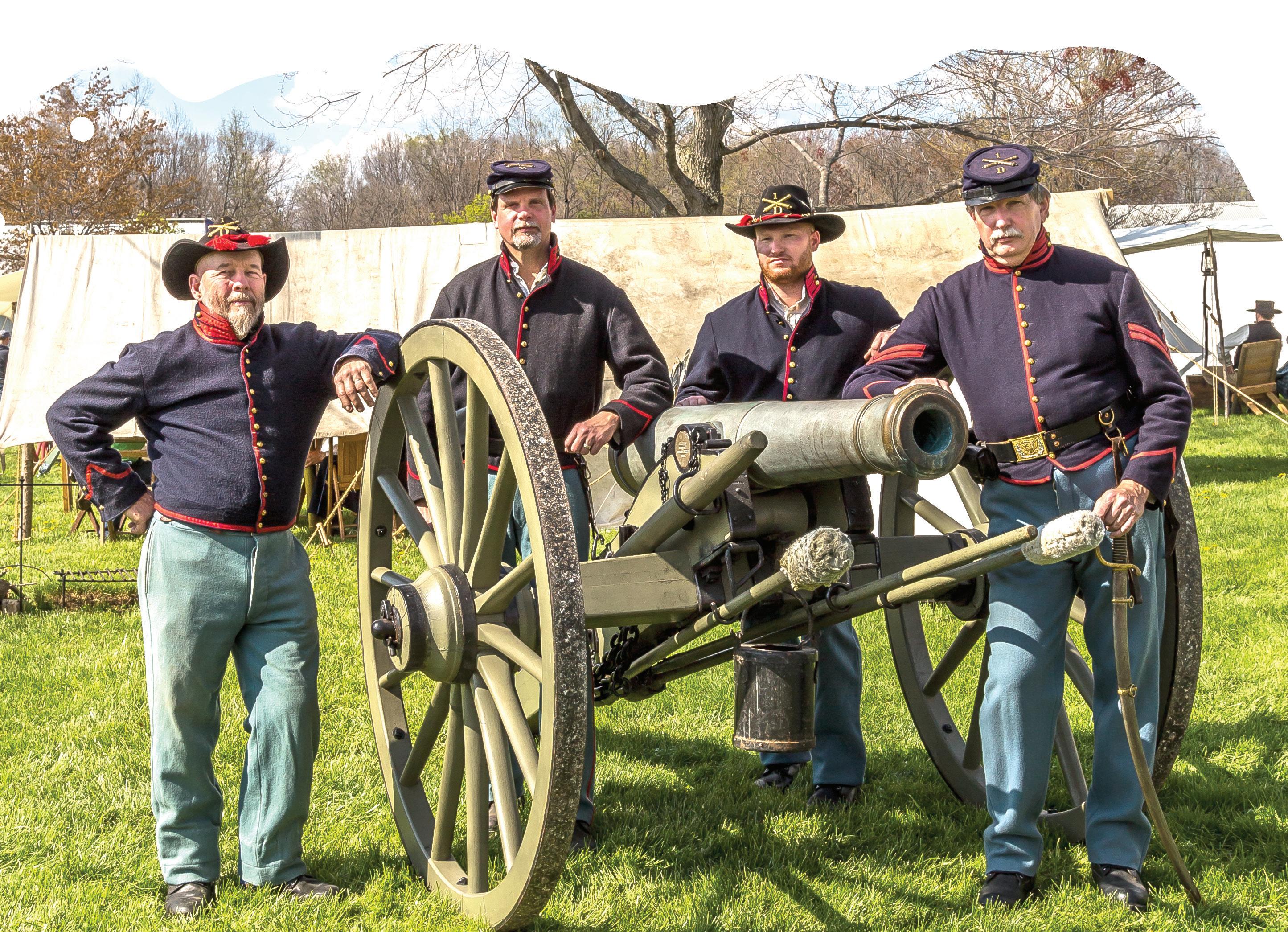
Explore the battlefield with Civil War Historian and Site Director, Lt. Col. Troy D. Marshall, who will explain the action as it took place 156 years ago. Hear the accounts of battle in the words of the soldiers who were there. Tour includes a visit to the Bushong Home, the movie “Field of Lost Shoes” and the “Bloody Cedars.” Tour hours 2-4 p.m. Tour includes the New Market Battlefield State Historical Park and Driving personal vehicles to nearby Days Inn. Wear comfortable clothes and walking shoes. For more information; 866-515-1864 or email nmbshp@vmi.edu.
May 15-17,
Virginia. Period Firearms
Competition
The North-South Skirmish Association 141st National Competition near Winchester. Over 3,000 uniformed competitors in 200 member units compete in live-fire matches with muskets, carbines, revolvers, mortars and cannon plus costume competitions and historical lectures. The largest Civil War live-fire event in the country. Free admission, large sutler area, and food service. For more information visit the N-SSA web site: www.n-ssa.org.
May 16-17, Virginia. Annual Reenactment
Join us for the 156th Anniversary Battle of New Market reenactment, one of the oldest continental reenactments in the nation, on original battlefield property. Visit demonstrations and living history presentations before and after battles each day. Explore artillery cavalry, musket firing, camp life, medical corps and much more. Variety of food vendors and souvenir shops on Sutler Row. Admission $10 / 10 and older, 9 and under are free. 866-515-1864 for advance tickets.
May 24, Pennsylvania. Memorial Day Observance at Historic Laurel Hill Cemetery
Recreating the Original G.A.R. Decoration Day Service of 1868: The traditional Decoration Day service of the Grand Army Meade Post #1 will be recreated at Laurel Hill Cemetery, 3822 Ridge Ave. Philadelphia at noon. For information, 215-228-8200 or awaskie01@gmail.com for Dr. Andy Waskie.
May 30, Georgia. Living History
Anniversary living history and civilian program at the Battle of Pickett’s Mill Battlefield Historic Site located at 4432 Mt. Tabor Church Rd., Dallas, Ga. Hours are 9 a.m. - 4 p.m. $6/adult. For information; explore.gastateparks.org/ info/214024?c=17413216.
May 30 & 31, Pennsylvania. Living History
Join us for this annual event recognizing the participation of 120 members of the Pennypacker family, including Governor Samuel W. Pennypacker, a Private in the 26th Pa. Emergency Militia. See soldier life and civilian demonstrations, artillery fire, troop inspections, dress parade, music and speakers. Children can participate in the Be a Soldier Kid Enlistment each day. Pennypacker mansion is open for tours. Food vendor onsite. Hours: Sat. 10- 5; Sun. 10-4. Free to the public. Reenactment units: Fee $2/person before May 1, $10/person after. Free straw, firewood, water and cake. For Information: 610-287-9349 or www.ppmcivilwar.org.
History Comes Alive
May 8 & 9, 2020
Friday:
Living history for local schools. Come and share your knowledge of the Civil War with Columbia and Montour County school children. Dinner provided for all participants.
Saturday
Living history all day.
• Unit bounties paid
• Free registration
• Artillery and Cavalry welcome
• Sutlers welcome
• Large gun show also on the Fairgrounds
For more information and registration forms contact Eric Stahley at ecstahley@gmail.com
Bloomsburg Fairgrounds 620 W 3rd St • Bloomsburg, PA 17815
44 Civil War News March 2020
June 6-7, Virginia. 23rd Annual Reenactment – The Action at Wilson’s Wharf
Fort Pocahontas was the site of the May 24, 1864 Action in which United States Colored Troops defended the fort they built against an assault by Fitzhugh Lee’s Confederate Cavalry. Open to the public 10-4 Saturday and 10-3 Sunday: $10/adults, $8/students. Battle reenactments 1 p.m. both days; Civil War living history including family activities. For reenactors: shaded campsites on the James River, Friday officers’ social, Saturday buffet dinner provided, evening dance and artillery fire. Discounted early registration by May 29. For more information visit www.fortpocahontas.org.
July 6-10, Virginia. Civil War Camp Days


Enroll your little history buff in an economical, educational, and exciting hands-on learning opportunity in the Day Camp at the Virginia Museum of the Civil War. Open to boys and girls ages 7-12. Each day will focus on a different theme. All the while teaching your kids what life was like for Confederate and Union soldiers, VMI Cadets and civilians on the home front. Play games, eat the food and drill as they did. Walk in history’s footsteps at the Civil War Day Camp. $80 for the full week. For more information or registration; 866-515-1864.
June 27-28, Pennsylvania. Civil War Show
Sat. 10 a.m. – 5 p.m., Sun. 9 a.m. – 2 p.m. Eisenhower Hotel & Conference Center Allstar Expo Complex, 2638 Emmitsburg Road, Gettysburg. The Gettysburg Battlefield Preservation Association’s Artifact and Collector’s Show features more than 200 vendors and over 300 tables of artifacts, swords, firearms, correspondence, books, photographs, documents and much more. Daily admission: Adults: $8. Children 12 and under free. Vendors contact: bsynnamon@gmail.com or call 717-334-2350. For more information visit www.uniondb.com or www.gbpa.org. Email: info@gbpa.org.
July 4-5, Pennsylvania. Reenactment
The 2020 reenactment of the Battle of Gettysburg will be hosted by the Gettysburg Battlefield Preservation Association and will be held at the Daniel Lady Farm. For updates visit https://www.gbpa.org/news/gbpas-daniel-ladyfarm-host-2020-battle-gettysburg.
July 20-24, Virginia. Civil War Camp Days
Enroll your little history buff in an economical, educational, and exciting hands-on learning opportunity in the Day Camp at the Virginia Museum of the Civil War. Open to boys and girls ages 7-12. Each day will focus on a different theme. All the while teaching your kids what life was like for Confederate and Union soldiers, VMI Cadets and civilians on the home front. Play games, eat the food and drill as they did. Walk in history’s footsteps at the Civil War Day Camp. $80 for the full week. For more information or registration; 866-515-1864.
July 22-26, Georgia. Gateway to the Deep South: Chickamauga & Chattanooga
Featuring tour guide & leading authority David Powell with special guest Eric Wittenberg as we visit Bridgeport and Stevenson, AL; LaFayette, GA, Davis’s Crossroads, Chickamauga, Reed’s Bridge, Jay’s Mill, Brock Field, Kelly Field, Brotherton Field, Horseshoe Ridge, Lookout Mountain, National Cemetery, Orchard Knob, Ringgold & more! Based in Ringgold, GA. More details www.CivilWarSeminars.org or call 717-264-7101.
July 25-26, Tennessee. Civil War Show and Sale

American Digger® Magazine’s Chattanooga Civil War & Artifact Show, Camp Jordan Arena, 323 Camp Jordan Pkwy., East Ridge, Tenn. Info: 770362-8671 or 716-574-0465; email anita@americandigger.com or kesmas@ localnet.com.

Aug. 15-16, Minnesota. Reenactment

“Pipestone Civil War Days,” 850 N Hiawatha Ave, Pipestone. Camps, music, talks and demonstrations 8 a.m. - 4:30 p.m. Sat., 8 a.m. - 4 p.m. Sun. Battles to be held on both afternoons. For info; pipestoneminnesota.com/cwd.
Aug. 15, Virginia. Jacob Bushong’s Birthday Party
Join our living historians as we celebrate the birthday of Jacob Bushong whose home stood at the center of the fighting during the Battle of New Market. Explore 19th-century traditions, enjoy cake and ice cream, games, music, dancing and fun from 11 a.m. – 3 p.m. Walk in history’s footsteps and discover what home life was like during the years before the Civil War. This event is free! For information; 866-515-1864.
Sept. 19, Pennsylvania. Living History
“Camp William Penn and Historic La Mott Day,” 10 a.m. - 4 p.m. Opening ceremony at 7322 Sycamore Ave. Visit USCT and PA 53rd re-enactors’ camp
and hear about Civil War medicine. Tour Museum at 1618 Willow Ave, and Community Center at 7420 Sycamore Ave, with tables and historical displays re La Mott. Lectures on about Camp William Penn and the soldiers. There will be cartridge making demos and historic impersonators. Guided walking tours and printed programs will be available. Family friendly. For information; 215 885-2258 or pt@usct.org.
Sept. 26, Illinois. Civil War Show and Sale
Zurko Promotions presents The National Civil War Collectors Fall Show and Sale which will be held at the DuPage County Fairgrounds in Wheaton. Hours: 9 a.m. to 4 p.m. Admission is $9, Free parking. For information; www. chicagocivilwarshow.com.
Deadlines
45 March 2020 Civil War News Order online at www.HistoricalPubs.com
Ads or Events to ads@civilwarnews.com
for Advertising or Editorial Submissions is the 20th of each month. Email
“The best little book on Barnard”
The American Civil War was the rst war in which both sides widely used entrenchments, repeating ri es, ironclad warships, and telegraphed communications. It was also the rst American War to be extensively photographed. Mathew Brady, Alexander Gardner and Timothy O’Sullivan are famous for having made iconic photographs in the Civil War’s eastern theater. George N. Barnard deserves to be ranked in this top tier for his photographic work in the war’s western theater. A civilian photographer hired by Gen. William T. Sherman’s chief engineer to take pictures of forti cations around Atlanta, Barnard took several hundred of them in and around the city in the fall of 1864. His most famous is the site of Union Maj. Gen. James B. McPherson’s death in the battle of Atlanta, July 22, 1864. Thus far, no comprehensive, de nitive listing has been made of the photographer’s work. For this book we have chosen a hundred images we deem “signi cant.”


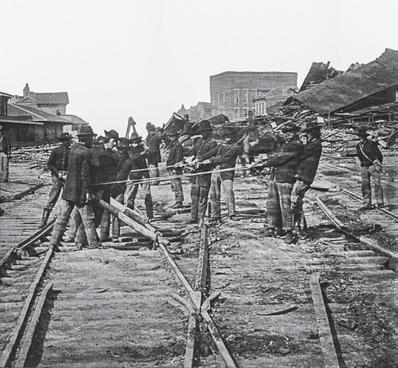


Ordering info: $19.95 plus $3.50 s&h South Carolina residents add 9% sales tax
Mail a check to: Historical Publications LLC 520 Folly Road, Suite 25 PMB 379 Charleston, SC 29412




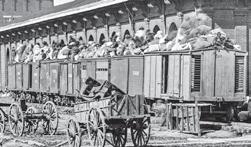

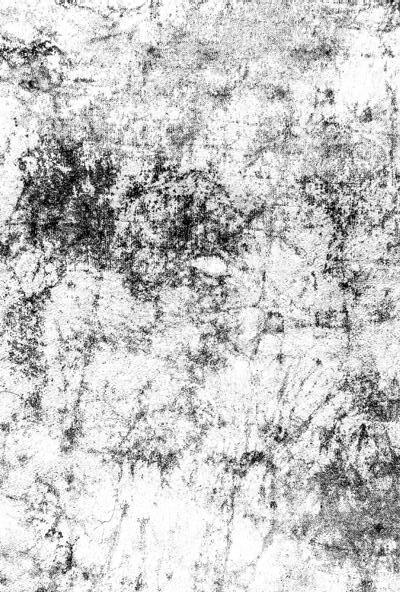


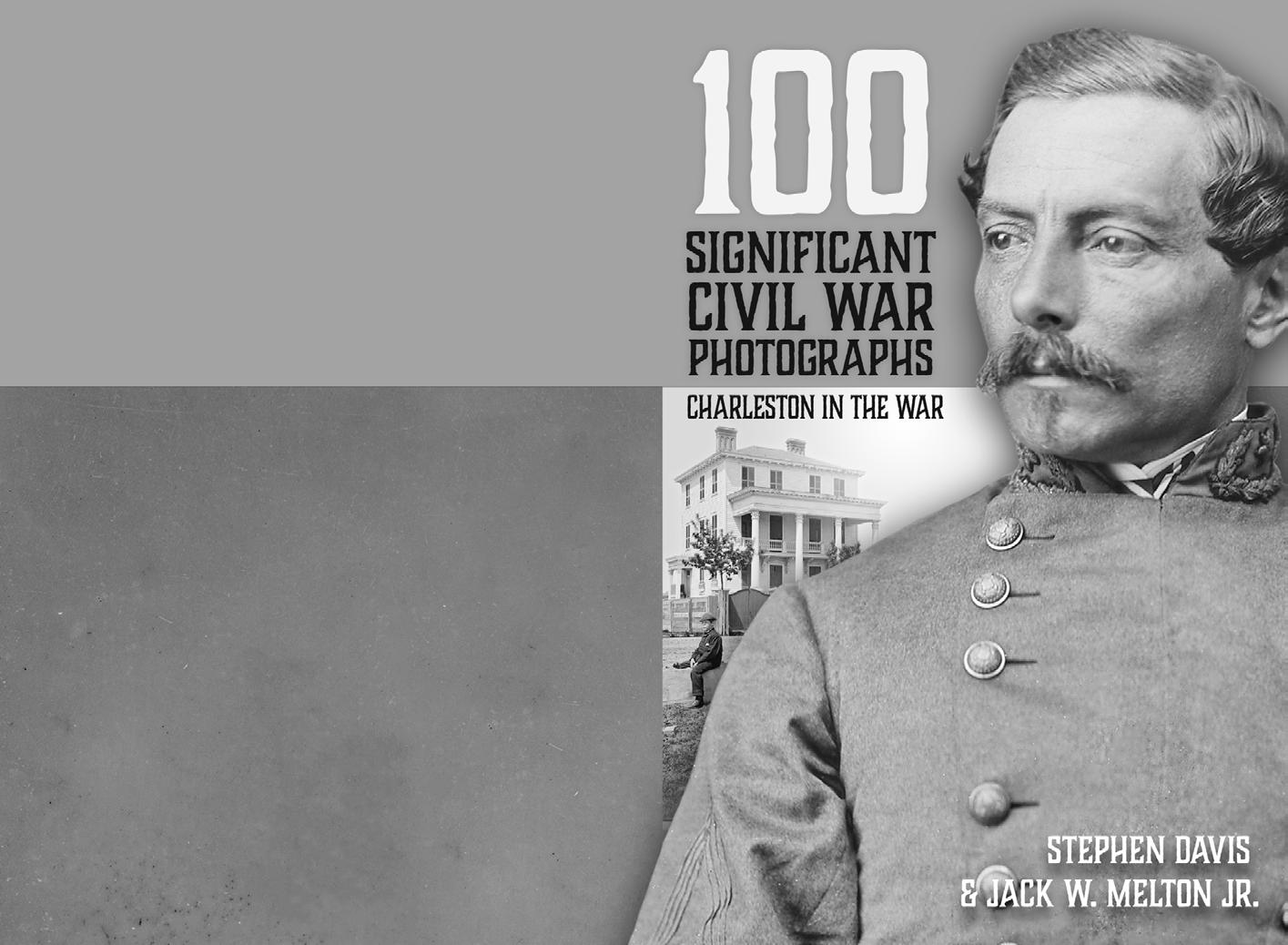
or Order online at www.historicalpubs.com

46 Civil War News March 2020 “The STORIES BEHIND THE PICTURES” 100 Significant Civil War Photographs CHARLESTON IN WAR
Stephen Davis & JACK W. MELTON JR Name Shipping Address City State Zip 160 pages • OVER 100 PHOTOS • MAPS • INDEX • BIBLIOGRAPHY • ISBN: 978-1-61850-167-7 Paperback: $19.95 (+$3.50 S & H) • Released Jan. 2020 3 ways to order YOUR COPY! CALL US 800-777-1862 ORDER ONLINE www.historicalpubs.com fill out this form BELOW & mail with a check for $23.45 to: Historical Publications LLC 520 Folly Road, Suite 25 PMB 379, Charleston, SC 29412 (S.C. residents include 9% sales tax of $1.80) newly Barnard and Charles photograph, selected as e Great Fire allow book are Confederates Harbor Reminiscences of Federal history historical works. such as (1838–1910). DAVIS & MELTON 100 SIGNIFICANT CIVIL WAR PHOTOGRAPHS CHARLESTON IN THE WAR
By
128 page Paperb ac k: $19.95 (+$3.50 S & H)
Wrecking Atlanta Northern Engineers Prying Up Track the right—leading one to deduce that this picture was taken on the afternoon November Battles and series the 1880s. When the men the 1st Missouri Engineers (oneofPoe’s twoengineerregimentsatAtlanta)sawtheTaberillustration,theyapparentlyrecognized made by them for the purpose.” for Monday, November 7. Freedpeople on the Boxcars Library of Congress. scrutinize the pictures and compare them to others. In identifying these kinds scenes, viewers look for telltale clues. One the most important inthesetofpicturestakenatBatteryKisthetreeinthecenter,whichConfederateshadleft Confederate Lt. Col. Bushrod W. Frobel, assistant chief engineer in Hood’s army, called this“thePeachtreestreetbattery.”InhisdiaryentryforAugust14,1864,heremarkedon Peachtree Battery–Another View Re enactment nd 2 Annual • COMMEMORATE 155 years since the Lincoln Funeral Train crossed the Stone Gables Estate property SEE the world’s only full- scale, operating replica of Lincoln’s Funeral Coach, “United States” • HEAR a steam train whistle, cannon re, and Civil War era music • COME aboard the passenger car replicas on the Harrisburg, Lincoln & Lancaster Railroad • EXPERIENCE presentations, demonstrations, and exhibits by Civil War re - enactors and historians • TOUR the historic Star Barn Village and Ironstone Ranch . . . and much more • General Admission Saturday, May 2nd Re-enactment starts at 12:00 noon RE-ENACTORS WANTED! If you or your group present Civil War impressions, military or civilian, we would love to have you join us! Contact Shannon to learn how you can participate in this one - of-a-kind event! 812.325.0374 ThatTrainLady@yahoo.com Elizabethtown, PA Fo r m o re i n f o r m a t i o n a n d t i c ke t s v i s i t S t o n e G a b l e s E s t a t e . c o m VIP Dinner Event Friday, May 1st
$38.50 - 1 year USA Print
$48.50 - 1 year USA Print & Digital
$66 - 2 year USA Print
$86 - 2 year USA Print & Digital
$29.95 - 1 year Digital only
Payment Enclosed Check # Card # Exp. Date
Card
Terms and Conditions
The following terms and conditions shall be incorporated by reference into all placement and order for placement of any advertisements in Civil War News by Advertiser and any Agency acting on Advertiser’s behalf. By submitting an order for placement of an advertisement and/or by placing an advertisement, Advertiser and Agency, and each of them, agree to be bound by all of the following terms and conditions:
1. All advertisements are subject to acceptance by Publisher who has the right to refuse any ad submitted for any reason.
2. The advertiser and/or their agency warrant that they have permission and rights to anything contained within the advertisement as to copyrights, trademarks or registrations. Any infringement will be the responsibility of the advertiser or their agency and the advertiser will hold harmless the Publisher for any claims or damages from publishing their advertisement. This includes all attorney fees and judgments.
3. The Publisher will not be held responsible for incorrect placement of the advertisement and will not be responsible for any loss of income or potential profit lost.
4. All orders to place advertisements in the publication are subject to the rate card charges, space units and specifications then in effect, all of which are subject to change and shall be made a part of these terms and conditions.
5. Photographs or images sent for publication must be high resolution, unedited and full size. Phone photographs are discouraged.
6. At the discretion of Civil War News any and all articles will be edited for accuracy, clarity, grammar and punctuation per our style guide.
7. Articles can be emailed as a Word Doc attachment or emailed in the body of the message. Microsoft Word format is preferred. Email articles and photographs: mail@civilwarnews.com
47 March 2020 Civil War News Publishers: Please send your book(s) for review to: Civil War News 520 Folly Road, Suite 25 PMB 379 Charleston, SC 29412 Email cover image to bookreviews@civilwarnews.com Advertisers In This Issue: 100 Significant Civil War Photographs: Atlanta 46 100 Significant Civil War Photographs: Charleston 37, 46 American Battlefield Trust 7 Ace Pyro LLC 12 American Digger Magazine 5 Artilleryman Magazine 7 Brian & Maria Green 2 Civil War Guru 36 C.S. Acquisitions 13 CS Arms 19 Civil War Artillery – The Half Shell Book 45 CWMedals.com, Civil War Recreations 41 Civil War Navy Magazine 33 Civil War Shop – Will Gorges 11 College Hill Arsenal – Tim Prince 26 Dell’s Leather Works 33 Dixie Gun Works Inc. 28 Fugawee.com 33 General Barton & Stoval Association 5 Georgia’s Confederate Monuments – Book 31 Gettysburg Foundation 24 Greg Ton Currency 11 Gunsight Antiques 11 Harpers Ferry Civil War Guns 12 The Horse Soldier 4 James Country Mercantile 57 Jeweler’s Daughter 5 Krupp Cannon For Sale 23 Le Juneau Gallery 13 Mike Brackin 28 Military Images Magazine 4 Morphy’s Auction Company 9 National Museum of Civil War Medicine 36 Owens & Ramsey Book Sellers 41 Panther Lodges 23 The Regimental Quartermaster 11 Richard LaPosta Civil War Books 41 SC Confederate Relic Room & Military Museum 28 Suppliers to the Confederacy – Book, Craig Barry 14 Ulysses S. Grant impersonator – Curt Fields 11 University of Tennessee Press 18 Vin Caponi Historic Antiques 8 Events: Baltimore Antique Arms Show 43 Chicagoland’s National Civil War Show 43 Civil War Seminars 43 The Civil War on the Water Conference 29 History Comes Alive – Bloomsburg Fairgrounds 44 MKShows, Mike Kent 3, 23 Morphy’s Auctions 9 Ohio Civil War Show 23 Poulin Auctions 48 Stone Gables Estate 46
c c c c c c
NAME ADDRESS ADDRESS CITY STATE ZIP CODE EMAIL
Charge my: Discover MasterCard Visa
Security Code
c c c c
War
PHONE
for digital subscription) USA Subscriptions Only No Canada or International Mail to: Historical Publications LLC 520 Folly Road, Suite 25 PMB 379, Charleston, SC 29412 Deadlines for Advertising or Editorial Submissions is the 20th of each month. Email to ads@civilwarnews.com Subscribe online www.CivilWarNews.com
Name on
New Renewal c Make checks payable to Historical Publications LLC.
Civil
News – 12 Issues Per Year
Email (required











































 by Paul T. Scott
by Paul T. Scott








































































































































































 Gould B. Hagler, Jr.
Gould B. Hagler, Jr.











































































































































































 $40.95 Cloth.
$40.95 Cloth.

 Reviewed by Wayne Wolf
Reviewed by Wayne Wolf











































